Paul van Yperen's Blog, page 88
May 5, 2023
Mary Miles Minter
Mary Miles Minter (1902-1984) was an American silent screen actress with a trademark innocent appearance. Her most famous film was Anne of Green Gables (1919). After the scandalous death of director William Desmond Taylor in 1922, who had been her lover, her screen career was quickly finished.
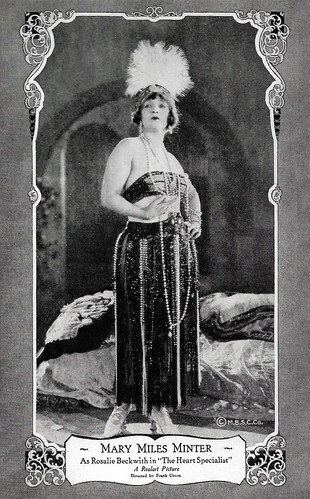
American postcard by Max B. Sheffer Card Co., Chicago (M.B.S.C.Co.). Photo: Realart. Mary Miles Minter in The Heart Specialist (Frank Urson, 1922).
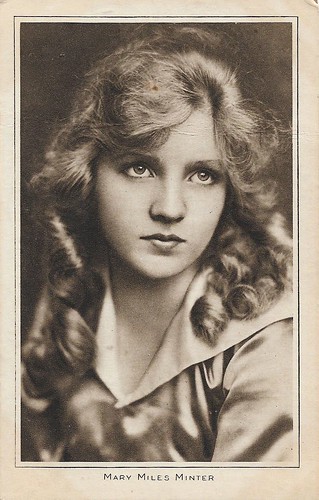
British postcard in the 'Pictures' Portrait Gallery, London.
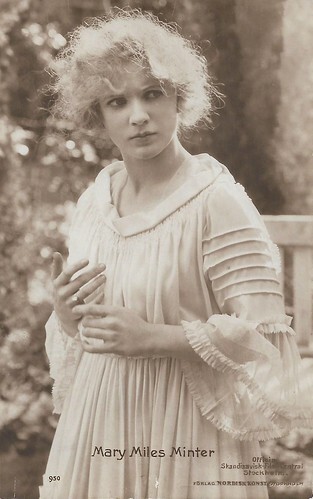
Swedish postcard by Förlag Nordisk Konst, Stockholm, no. 950. Photo: Skandinavisk-Film-Central, Stockholm.
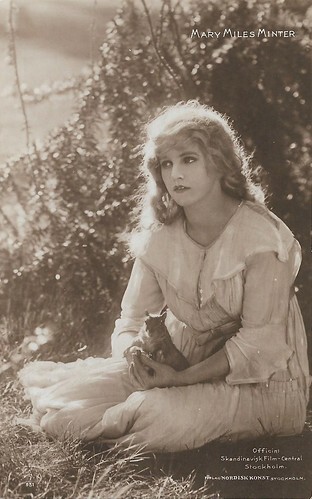
Swedish postcard by Förlag Nordisk Konst, Stockholm, no. 951. Photo: Skandinavisk-Film-Central, Stockholm.
The rival of Mary Pickford
Mary Miles Minter was born Juliet Reilly in 1902 in Shreveport as the daughter of Broadway actress Charlotte Shelby. Shelby herself wanted that Juliet and her older sister Margaret also became stage actresses. One night when there was no babysitter available Juliet accompanied her sister to an audition, was discovered and got her first stage role.
In order to avoid the Child Labor Act, she used her cousin's passport and took the name, Mary Miles Minter. As a result, she debuted in film in 1912 and in 1915 got her first substantial lead in a feature, The Fairy and the Waif (Marie Hubert Frohmann, George Irving, 1915). With her innocent appearance, she started to work for Metro Pictures.
Soon after, she moved on to Mutual Pictures in 1916. She always played the lead, despite her young age. In 1917 she moved to the American Film Company, where Henry King often directed here, and in 1918 she traded American for Paramount. Minter became popular and grew into the rival of Mary Pickford .
In 1919 Mary Miles Minter made her most famous film, Anne of Green Gables with director William Desmond Taylor. The film, now presumed to be lost, became a huge success. Taylor then started to promote the actress so that she would grow into a legendary star. Eventually, she got into a relationship with 30-year-old Desmond Taylor.
Several films with Minter in the lead were made by their newly founded production company Realart Pictures, but distributed by Paramount. Taylor initially directed her there, but after a few films, various other directors stepped in, such as Paul Powell and Joseph Henabery.
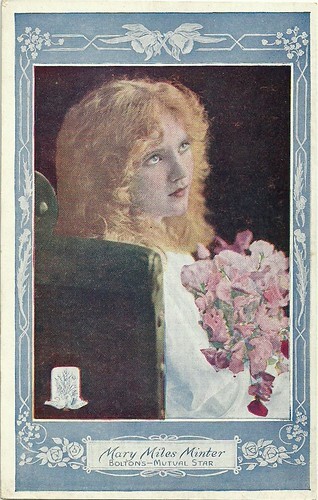
British postcard by John Horn, London/Glasgow. Photo: Bolton's-Mutual.
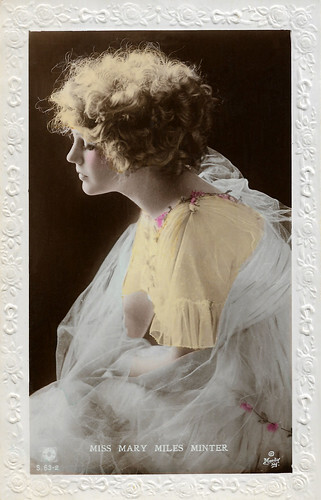
British postcard by Rotary Photo, London, no. S. 63-2. Photo: Moody, N.Y.
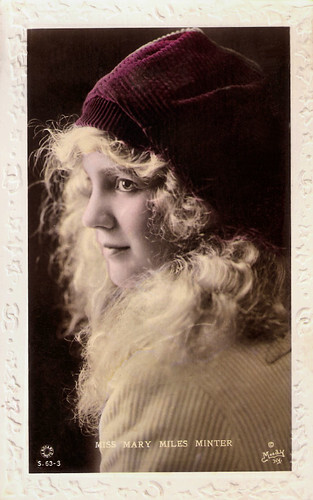
British postcard by Rotary Photo, London, no. S. 63-3. Photo: Moody, N.Y.
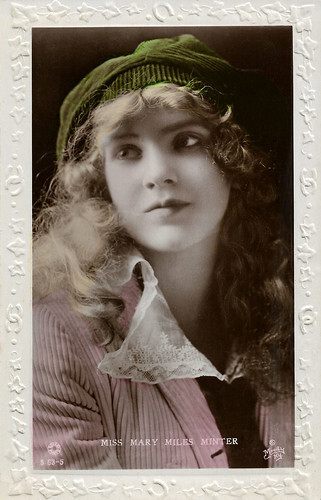
British postcard by Rotary Photo, London, no. S. 63-5. Photo: Moody, N.Y.
The unresolved murder case
In 1922 William Desmond Taylor was murdered in his house. Mary Miles Minter told in an interview in 1970 that she collapsed when she saw his body in the morgue. His death became a popular topic in the media and it took place while Minter was in the prime of her career. The perpetrator could not be found and her mother Charlotte Shelby was long known as a suspect.
In 1937, when the case was still unresolved, Minter demanded that she be given a prison sentence or that the case would be left alone. Eventually, it was announced in 1999 that Ella Margaret Gibson admitted on her deathbed in 1964 that she had committed the murder. Not much later she died of a heart attack.
After the death of Taylor, Mary Miles Minter made only four more films for Paramount. Trail of the Lonesome Pine (Charles Maigne, 1923), her last film, was released in 1923. After her contract was not renewed, she received many other offers, but she refused all because she said she was never happy during the times that she was an actress.
Minter has told in interviews that she was much happier after her Hollywood years, although she was robbed in her own home in the 1970s and 1980s. She also sued her mother for all the money she had gained by filming and got a settlement out of court.
Mary Miles Minter died of a stroke at the age of 82. All in all, she did some 55 films of which just a little over a fifth survives.
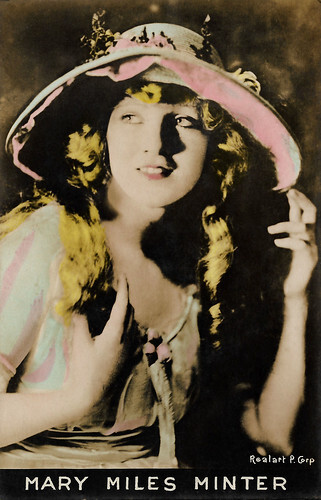
American postcard by Stage and Film Celebrity Co., New York. Photo: Realart Picture Corporation.
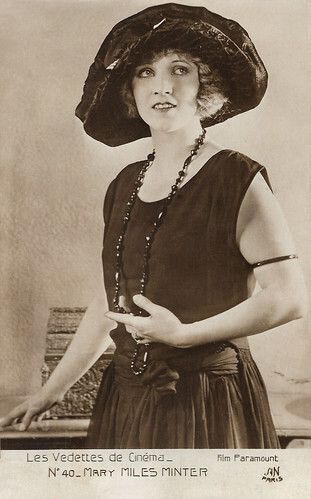
French postcard by A.N., Paris, in the Les vedettes de cinéma series, no. 40. Photo: Film Paramount.
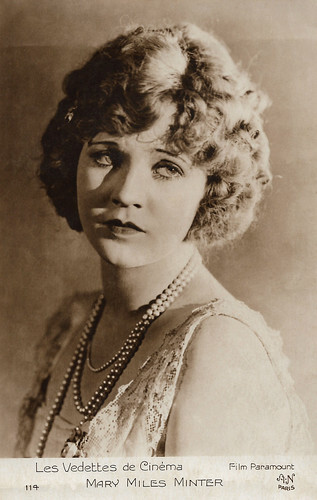
French postcard by A.N., Paris in the Les vedettes de cinéma series, no. 114. Photo: Film Paramount.
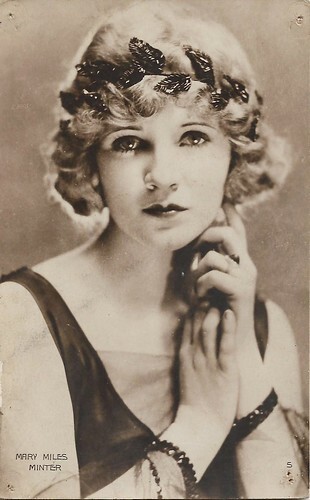
French postcard by Editions Cinémagazine, no. 5. The photo refers to the film The Cowboy and the Lady (Charles Maigne, 1922).
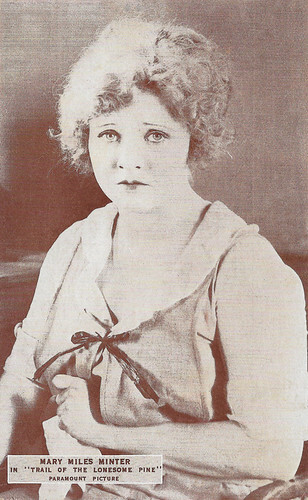
American postcard. Photo: Paramount. Mary Miles Minter in The Trail of the Lonesome Pine (Charles Maigne, 1923).
Sources: Wikipedia (English and Italian) and .

American postcard by Max B. Sheffer Card Co., Chicago (M.B.S.C.Co.). Photo: Realart. Mary Miles Minter in The Heart Specialist (Frank Urson, 1922).

British postcard in the 'Pictures' Portrait Gallery, London.

Swedish postcard by Förlag Nordisk Konst, Stockholm, no. 950. Photo: Skandinavisk-Film-Central, Stockholm.

Swedish postcard by Förlag Nordisk Konst, Stockholm, no. 951. Photo: Skandinavisk-Film-Central, Stockholm.
The rival of Mary Pickford
Mary Miles Minter was born Juliet Reilly in 1902 in Shreveport as the daughter of Broadway actress Charlotte Shelby. Shelby herself wanted that Juliet and her older sister Margaret also became stage actresses. One night when there was no babysitter available Juliet accompanied her sister to an audition, was discovered and got her first stage role.
In order to avoid the Child Labor Act, she used her cousin's passport and took the name, Mary Miles Minter. As a result, she debuted in film in 1912 and in 1915 got her first substantial lead in a feature, The Fairy and the Waif (Marie Hubert Frohmann, George Irving, 1915). With her innocent appearance, she started to work for Metro Pictures.
Soon after, she moved on to Mutual Pictures in 1916. She always played the lead, despite her young age. In 1917 she moved to the American Film Company, where Henry King often directed here, and in 1918 she traded American for Paramount. Minter became popular and grew into the rival of Mary Pickford .
In 1919 Mary Miles Minter made her most famous film, Anne of Green Gables with director William Desmond Taylor. The film, now presumed to be lost, became a huge success. Taylor then started to promote the actress so that she would grow into a legendary star. Eventually, she got into a relationship with 30-year-old Desmond Taylor.
Several films with Minter in the lead were made by their newly founded production company Realart Pictures, but distributed by Paramount. Taylor initially directed her there, but after a few films, various other directors stepped in, such as Paul Powell and Joseph Henabery.

British postcard by John Horn, London/Glasgow. Photo: Bolton's-Mutual.

British postcard by Rotary Photo, London, no. S. 63-2. Photo: Moody, N.Y.

British postcard by Rotary Photo, London, no. S. 63-3. Photo: Moody, N.Y.

British postcard by Rotary Photo, London, no. S. 63-5. Photo: Moody, N.Y.
The unresolved murder case
In 1922 William Desmond Taylor was murdered in his house. Mary Miles Minter told in an interview in 1970 that she collapsed when she saw his body in the morgue. His death became a popular topic in the media and it took place while Minter was in the prime of her career. The perpetrator could not be found and her mother Charlotte Shelby was long known as a suspect.
In 1937, when the case was still unresolved, Minter demanded that she be given a prison sentence or that the case would be left alone. Eventually, it was announced in 1999 that Ella Margaret Gibson admitted on her deathbed in 1964 that she had committed the murder. Not much later she died of a heart attack.
After the death of Taylor, Mary Miles Minter made only four more films for Paramount. Trail of the Lonesome Pine (Charles Maigne, 1923), her last film, was released in 1923. After her contract was not renewed, she received many other offers, but she refused all because she said she was never happy during the times that she was an actress.
Minter has told in interviews that she was much happier after her Hollywood years, although she was robbed in her own home in the 1970s and 1980s. She also sued her mother for all the money she had gained by filming and got a settlement out of court.
Mary Miles Minter died of a stroke at the age of 82. All in all, she did some 55 films of which just a little over a fifth survives.

American postcard by Stage and Film Celebrity Co., New York. Photo: Realart Picture Corporation.

French postcard by A.N., Paris, in the Les vedettes de cinéma series, no. 40. Photo: Film Paramount.

French postcard by A.N., Paris in the Les vedettes de cinéma series, no. 114. Photo: Film Paramount.

French postcard by Editions Cinémagazine, no. 5. The photo refers to the film The Cowboy and the Lady (Charles Maigne, 1922).

American postcard. Photo: Paramount. Mary Miles Minter in The Trail of the Lonesome Pine (Charles Maigne, 1923).
Sources: Wikipedia (English and Italian) and .
Published on May 05, 2023 22:00
May 4, 2023
Andy Warhol
Andy Warhol (1928-1987) was the 'Father of Pop Art' with his silk-screened pictures of Campbell's Soup cans and distorted images of Marilyn Monroe. He started directing films and most of his early work simply consisted of pointing the camera at something (a man asleep, the Empire State Building) and leaving it running, sometimes for hours. His films gradually grew more sophisticated, with scripts and soundtracks. They were generally performed by members of the Warhol "factory". In 1968, after a near-fatal shooting by an unstable fan, Warhol retired from direct involvement in filmmaking, and under former assistant Paul Morrissey, the Warhol films became increasingly commercial. Warhol spent the 1970s and 1980s as a major pop culture figure, constantly attending parties and providing patronage to younger artists.
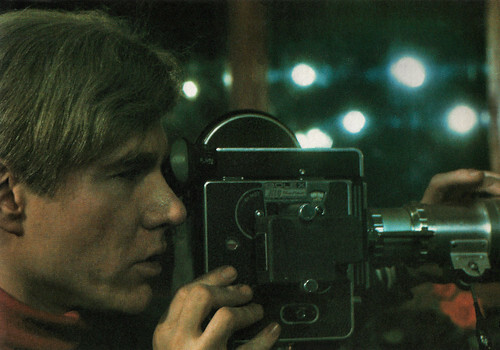
Dutch postcard by Art Unlimted, Amsterdam, no. F3135. Photo: Nat Finkelstein / Refuse Productions. Caption: Andy + movie camera, 1965.
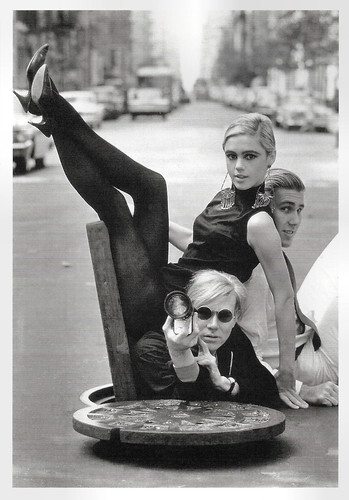
French postcard in the Collection Magie Noire by Editions Hazan, Paris, 1994, no. 6434. Photo: Burt Glinn / Magnum Photos. Caption: Andy Warhol in the London sewers, 1965.
Art as mass-produced items
Andy Warhol was born Andrew Warhola in 1928 in Pittsburgh, USA. His parents were Ondrej (Andrew) Varhola and Julia Zavackyová Varholová, ethnic Lemko immigrants from the village of Miková in the Austria-Hungary Empire (now Slovakia). Ondrej, whose surname was originally written as Varhola, changed the spelling to Warhola when he emigrated to the US. He worked as a construction worker and later as a coal miner.
His father, who travelled much on business trips, died when Andy was 13. During his teenage years, he suffered from several nervous breakdowns. He showed artistic talent early on and went to study applied art in Pittsburgh at the Carnegie Institute of Technology, now Carnegie Mellon University. There, he stood out by drawing two self-portraits showing him picking his nose ('Upper Torso Boy Picking Nose' and 'Full Figure Boy Picking Nose'). In 1949, Andy graduated and dropped the letter 'a' from his last name.
Warhol moved to New York, where he met Tina Fredericks, the art editor of Glamour Magazine. Warhol's early jobs were doing drawings for Glamour, such as the 'Success is a Job in New York' and women's shoes. He also drew advertising for various magazines, including Vogue, and Harper's Bazaar, book jackets, and holiday greeting cards.
In 1952, his first solo exhibition was held at the Hugo Gallery in New York, of drawings to illustrate stories by Truman Capote. He started illustrating books, beginning with Amy Vanderbilt's 'Complete Book of Etiquette'. In 1956, he was included in his first group exhibition, 'Recent Drawings USA', held at the Museum of Modern Art, New York. By 1959, he was a successful advertising designer with an average annual income of $65000 and almost annual medals and other professional awards.
In 1960, Warhol began to make his first paintings. They were based on comic strips in the likes of Dick Tracy, Popeye, and Superman. In the following years, Warhol started painting famous American products like Campbell's soup cans and Coca-Cola bottles in large formats. He managed to interest the influential gallery owner and art collector Leo Castelli in his work. He started using the silk-screen technique, not merely to create art using everyday commercial mass-produced items as his motif but to create even his own art as mass-produced items. Warhol preferred to become an emotionless machine.
He set himself up as chief of a team of art workers who were engaged in making screen prints, films, books and magazines. This team operated in a studio near Union Square in New York. The studio was called the Factory because it actually housed a production line of paintings. The original Factory was located in an old cap factory at 231 East 47th street (fourth floor). This studio grew into a meeting place for artists, gays, transvestites, junkies and photographic models. Anyone with any artistic pretensions was welcome there.
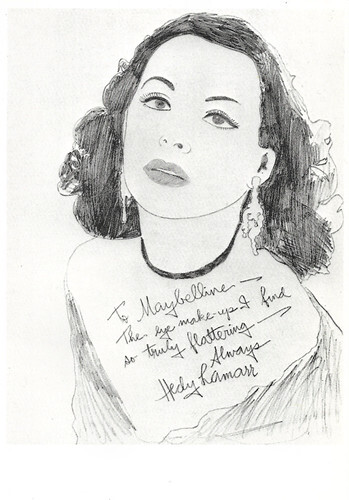
West German postcard in the 161 Andy Warhol series by Gebr. König Postkartenverlag, Köln, no. 161/4 (4 of 10), 1989. Illustration: Andy Warhol. Caption: Hedy Lamarr , 1962.
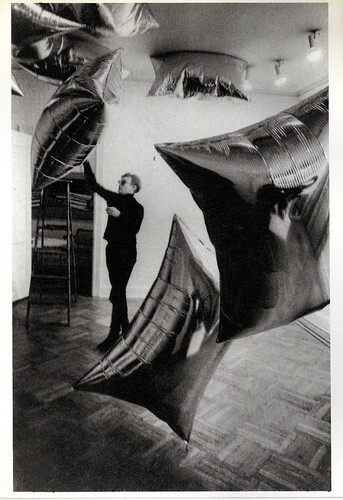
Dutch postcard by Art Unlimted, Amsterdam, no. B 1614. Photo: Nat Finkelstein, 1966.
A banana with a peel
After a few years, Andy Warhol moved his entourage to an office building across the street; 33 Union street West (sixth floor). This second Factory was called the Office by Warhol himself because it housed not only a studio but also the editorial office of Interview magazine, founded by Warhol. Warhol became known worldwide during the Factory years with his screen prints. Warhol's oeuvre largely draws on American popular culture. He made screen prints of any subject that lent itself to it. He painted and drew banknotes, cartoon images, food, women's shoes, celebrities and everyday objects. For him, these motifs represented American cultural values.
Paul Morrisey managed to persuade Warhol to become the manager of a rock band. It would be a commercial success if Warhol combined his talent for generating media attention with a sensational rock group. Warhol was not immediately enthusiastic but after Morrisey's insistence, he relented. Morrisey had seen The Velvet Underground perform at Cafe Bizarre. After Warhol went to see, he was immediately excited. He saw a group standing with good looks who, while tourists sat drinking, sang about Heroine and SM.
Warhol made the Velvet Underground part of his multimedia show 'Exploding Plastic Inevatible'. He also produced The Velvet Underground's first album with Nico. He essentially lent his name to their work and observed them in the recording studio, while Lou Reed and later Tom Wilson mostly called the shots. The cover of the band's first album was Warhol's design: a banana with a peel that was actually a peelable sticker.
On 3 June 1968, Valerie Solanas, a radical feminist author who hung around the Factory from time to time, turned up at the studio and shot Warhol and art critic Mario Amaya. Solanas had been rejected earlier that day at the Factory after she had requested the return of a script she had given Warhol for inspection. The script had apparently gone missing. Warhol was badly injured in the shooting and was even declared clinically dead in the hospital. He suffered the physical effects of the attack for the rest of his life and had to wear a corset to support his lower abdomen.
The shooting had a major after-effect on Warhol's life and his art. The Factory became more tightly shielded and for many, this event marked the end of the Factory's wild years. That same day, Solanas turned herself in to the police and was arrested. Her explanation for this crime was that Warhol had become too much of an influence on her life. This incident is the subject of the film, I Shot Andy Warhol (Mary Harron, 1996).
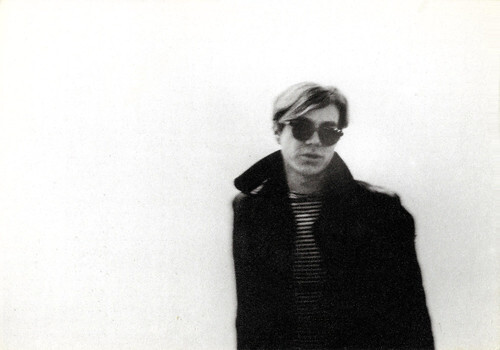
Dutch postcard by Art Unlimted, Amsterdam, no. B 1609. Photo: Nat Finkelstein, 1966. Caption: Andy Warhol, white wall.
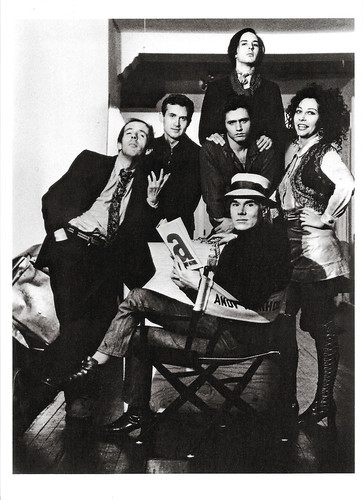
Swiss postcard by CVB Publishers / Filmwelt / News Productions, no. 57279. Photo: David Gahr / Collection Cinémathèque Suisse, Lausanne. Andy Warhol with Taylor Mead, Paul Morrissey (?), Fred Hughes, Gerard Malanga and Ultra Violet, pose for a portrait to publicize Warhol's 1968 book 'a' in December 1968 at The Factory at 33 Union Square West in New York City, New York.
Sleep, Kiss, Blow-Job and Eat
Between 1963 and 1968, Andy Warhol was a prolific filmmaker. He made more than one hundred and sixty films, 60 of which are accessible. The films share similarities with his paintings, which also feature many repetitions and subtle variations of images. In the 1970s, Warhol banned the distribution of his films, but in the 1980s, after much insistence, he gave permission to restore the films. In many of his films, the usual projection speed was reduced from 24 frames to 16 frames per second. This is slightly different from usual slow-motion, where the film is actually shot at a higher speed and played back at normal speed. Warhol's technique gives the individual images more emphasis.
One of his most famous films, and also his first, Sleep (1963), shows for eight hours a sleeping man, John Giorno, with whom he had a relationship. Warhol filmed for about three hours each time until the sun rose at five in the morning. Filming took a month. The film Kiss (1963) shows close-ups of kissing couples for 55 minutes. Blow Job (1963) is a continuous close-up of the face of a man (DeVeren Bookwalter) being orally satisfied off-screen. According to Warhol's later assistant, Gerard Malanga, the invisible role featured poet and filmmaker Willard Maas, although Warhol gave a different reading on this in his memoir 'Popism'.
Warhol met Malanga in 1964, and they made Tarzan and Jane Regained... Sort of (1964). That year, Warhol also made a 99-minute portrait of the Metropolitan Museum of Art's famous curator Henry Geldzahler. During the filming, Warhol simply walked away. The film clearly shows how Geldzahler was bored and uncomfortable by the camera. By the end of the film, he collapsed completely. Also from 1964 is the film Eat, featuring Warhol's colleague and friend Robert Indiana, who is eating a mushroom very sedately and in a close-up. Another film, Empire (1964), consists of an eight-hour shot of the Empire State Building in New York at dusk.
Warhol's role-playing film Vinyl (1965) is an adaptation of the dystopian Anthony Burgess novel 'A Clockwork Orange'. Further films depict impromptu encounters with Factory hustlers such as Brigid Berlin, Viva, Edie Sedgwick, Candy Darling, Holly Woodlawn, Ondine, Nico and Jackie Curtis. In the film Camp, legendary artist Jack Smith appears within the subculture. Many famous visitors to the Factory were put in front of the camera between 1963 and 1966, and filmed for 2 minutes and 45 seconds, the length of the standard roll of film. Usually, these were static portraits. By running the films more slowly, the expressions of the faces are greatly magnified. These shots resulted in about 500 films, called Screentests by Warhol. Among those portrayed are film star Dennis Hopper and pop stars Lou Reed and Bob Dylan. The films were edited in various compositions and shown at Warhol exhibitions and in movie houses.
Warhol's unorthodox approach is exemplified by Kitchen (1965). The actors do not know their roles by heart, but the screenplay is hidden in various places on the set. The scriptwriter whispers lines of dialogue from outside the frame. Snapshots are taken during filming. The set designer appears on the screen. Dialogue is drowned out by the sound of a mixer. There are long periods when nothing happens. There are two pairs of characters with the same names. Warhol was not interested in auctorial control but shifted the burden from the director to the actors and the shooting crew. He showed little interest in story intrigue, which he considered old-fashioned, or technical aspects of filmmaking. Warhol wanted to explore the borders between feigned action and the more authentic behaviour of non-actors, which is why he kept the camera running constantly: he didn't want to miss anything.
In the summer of 1965, Andy Warhol met Paul Morrissey, who became his advisor and collaborator. Warhol's most successful film was Chelsea Girls (1966). The film was innovative as it consisted of two simultaneously projected 16-mm rolls of film with divergent narratives. From the projection booth, the sound level for one film was raised to clarify that story while it was lowered for the other, after which the reels were reversed. Chelsea Girls became the first underground film to be shown at a commercial theatre. Warhol also used this method of doubling the image in his screen prints of the early 1960s. Other important films include My Hustler (1965) and Lonesome Cowboys (1968), a homoerotic pseudo-Western. Blue Movie (1969), a film in which Warhol's 'superstar' Viva has sex with a man (Louis Waldon) for 33 minutes, was Warhol's last film of his own. After the film caused a scandal because of its liberal approach to sexuality, Viva managed to block its public screening for a long time. The film was not shown again in New York until 2005, for the first time in 30 years.

American postcard by Fotofolio, no. P318. Photo: Christopher Makos. Caption: Andy Warhol, 1978. Kissing John Lennon at the Factory.
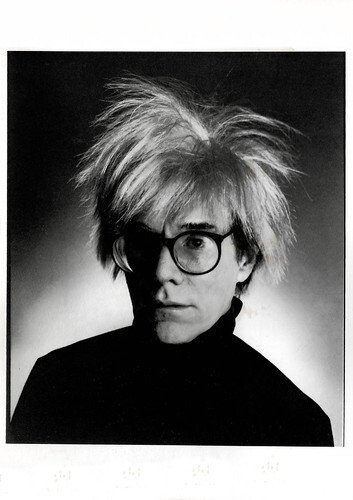
American postcard by Fotofolio, New York, NY, no. P310. Photo: Christopher Makos, 1986. Caption: For Andy, who taught me how to see.
Flesh, Trash, Heat and Bad
Compared to Andy Warhol's provocative work in the 1960s, the 1970s were artistically less productive, although Warhol became much more businesslike. He retired as a film director and left filmmaking to Paul Morrissey. The latter steered the approach to Warhol films more and more in the direction of ordinary B-movies with a clear narrative, for example, Flesh (1968), Trash (1970) and Heat (1972). These films, as well as the later films Flesh for Frankenstein (Paul Morrissey, Antonio Margheriti, 1973) and Sangue per Dracula/Blood for Dracula (Paul Morrissey, 1974), were much more mainstream than anything Warhol had ever made himself as a director. The star of these films was Joe Dallesandro, who was actually a Morrissey star rather than a true Andy Warhol superstar. Another film that caused a lot of furore as a Warhol film was Bad (1977), starring Carroll Baker and Perry King. This film was actually directed by Jed Johnson. To increase the success of the later films, all of Warhol's earlier avant-garde films were withdrawn from circulation around 1972.
Warhol founded Interview magazine in 1969. He resumed painting in 1972, although it was primarily celebrity portraits. According to his assistant during his later years, Bob Colacello, Warhol mainly sought out wealthy people from whom he could secure portrait commissions, such as Mick Jagger , Liza Minnelli, John Lennon , Diana Ross, Brigitte Bardot and Michael Jackson , as well as lesser-known bank executives and collectors. In 1975, he published his book 'The Philosophy of Andy Warhol', in which he explained his down-to-earth ideas about art and life.
Incidentally, he appeared in films and TV shows. When guesting on The Love Boat (1977), he was nervous about the experience and turned to his castmate Marion Ross, who calmed him down and offered some advice on how to act. In 1976, Warhol began a daily routine. Every morning at 9 am, he would call Pat Hackett, whom he had hired to keep track of his expenses. What was initially supposed to be just a morning bookkeeping session soon turned into an extremely intimate exchange of private experiences between the two of them. Warhol, who was "addicted to the phone anyway", told Hackett about the rather delicate details of the New York scene and celebrities, a subject that had interested him since childhood. Like his time capsules, the conversations were for capturing a picture of the times. After his death, Hackett released some of these notes in the book 'The Andy Warhol Diaries'. In 2022, this book was made into a Netflix documentary.
Andy Warhol worked for several years with Jean-Michel Basquiat a young artist in whom he recognised much of himself. The collaboration was equal, Warhol was past his prime and Basquiat had already established his name. This equality allowed them to collaborate on some 140 works, some of which were exhibited in a duo exhibition at the New York gallery Tony Shafrazi in 1985. The ensuing New York Times review made Basquiat Warhol's mascot after which their collaboration and also their friendship cooled.
Andy Warhol died in 1987 at the age of 58 in New York. He was recovering from a routine operation on his gallbladder when he died of cardiac arrest in his sleep. Hospital staff had administered sleeping pills to him after the operation and had not sufficiently monitored his well-being. Consequently, lawyers for Warhol's next of kin sued the hospital for negligence. Warhol constantly delayed medical treatment because he was afraid of hospitals and disliked doctors. Warhol was buried at St John the Baptist Byzantine Catholic Cemetery in Bethel Park, south of Pittsburgh. Yoko Ono was among those who gave a farewell address at his funeral. International auction house Sotheby's took nine days to auction off Warhol's immense collection of art and 'knickknacks'. The gross proceeds of this auction were about US$20 million. In 1990, Lou Reed and John Cale made a CD album called 'Songs for Drella' as a tribute to Warhol with 15 songs about Warhol's life.
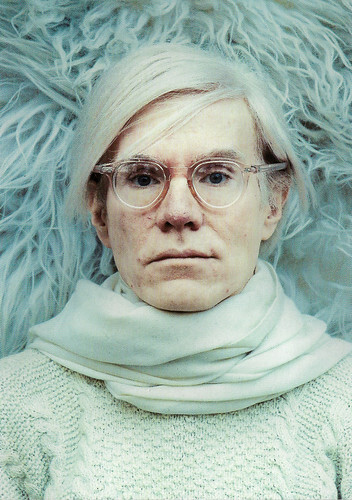
British postcard by London Cardguide LTD, London. Photo: Ewa Rudling.
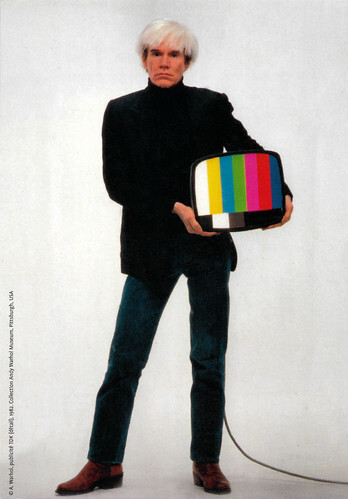
French freecard by Descartes / Actioncarbone, 2009, for the exhibition 'Warhol TV' in La Maison Rouge, Paris. Photo: Andy Warhol, publicity TDK (Detail). Collection: Andy Warhol Museum, Pittsburgh, USA.
Sources: (IMDb), (IMDb), Wikipedia (Dutch) and .

Dutch postcard by Art Unlimted, Amsterdam, no. F3135. Photo: Nat Finkelstein / Refuse Productions. Caption: Andy + movie camera, 1965.

French postcard in the Collection Magie Noire by Editions Hazan, Paris, 1994, no. 6434. Photo: Burt Glinn / Magnum Photos. Caption: Andy Warhol in the London sewers, 1965.
Art as mass-produced items
Andy Warhol was born Andrew Warhola in 1928 in Pittsburgh, USA. His parents were Ondrej (Andrew) Varhola and Julia Zavackyová Varholová, ethnic Lemko immigrants from the village of Miková in the Austria-Hungary Empire (now Slovakia). Ondrej, whose surname was originally written as Varhola, changed the spelling to Warhola when he emigrated to the US. He worked as a construction worker and later as a coal miner.
His father, who travelled much on business trips, died when Andy was 13. During his teenage years, he suffered from several nervous breakdowns. He showed artistic talent early on and went to study applied art in Pittsburgh at the Carnegie Institute of Technology, now Carnegie Mellon University. There, he stood out by drawing two self-portraits showing him picking his nose ('Upper Torso Boy Picking Nose' and 'Full Figure Boy Picking Nose'). In 1949, Andy graduated and dropped the letter 'a' from his last name.
Warhol moved to New York, where he met Tina Fredericks, the art editor of Glamour Magazine. Warhol's early jobs were doing drawings for Glamour, such as the 'Success is a Job in New York' and women's shoes. He also drew advertising for various magazines, including Vogue, and Harper's Bazaar, book jackets, and holiday greeting cards.
In 1952, his first solo exhibition was held at the Hugo Gallery in New York, of drawings to illustrate stories by Truman Capote. He started illustrating books, beginning with Amy Vanderbilt's 'Complete Book of Etiquette'. In 1956, he was included in his first group exhibition, 'Recent Drawings USA', held at the Museum of Modern Art, New York. By 1959, he was a successful advertising designer with an average annual income of $65000 and almost annual medals and other professional awards.
In 1960, Warhol began to make his first paintings. They were based on comic strips in the likes of Dick Tracy, Popeye, and Superman. In the following years, Warhol started painting famous American products like Campbell's soup cans and Coca-Cola bottles in large formats. He managed to interest the influential gallery owner and art collector Leo Castelli in his work. He started using the silk-screen technique, not merely to create art using everyday commercial mass-produced items as his motif but to create even his own art as mass-produced items. Warhol preferred to become an emotionless machine.
He set himself up as chief of a team of art workers who were engaged in making screen prints, films, books and magazines. This team operated in a studio near Union Square in New York. The studio was called the Factory because it actually housed a production line of paintings. The original Factory was located in an old cap factory at 231 East 47th street (fourth floor). This studio grew into a meeting place for artists, gays, transvestites, junkies and photographic models. Anyone with any artistic pretensions was welcome there.

West German postcard in the 161 Andy Warhol series by Gebr. König Postkartenverlag, Köln, no. 161/4 (4 of 10), 1989. Illustration: Andy Warhol. Caption: Hedy Lamarr , 1962.

Dutch postcard by Art Unlimted, Amsterdam, no. B 1614. Photo: Nat Finkelstein, 1966.
A banana with a peel
After a few years, Andy Warhol moved his entourage to an office building across the street; 33 Union street West (sixth floor). This second Factory was called the Office by Warhol himself because it housed not only a studio but also the editorial office of Interview magazine, founded by Warhol. Warhol became known worldwide during the Factory years with his screen prints. Warhol's oeuvre largely draws on American popular culture. He made screen prints of any subject that lent itself to it. He painted and drew banknotes, cartoon images, food, women's shoes, celebrities and everyday objects. For him, these motifs represented American cultural values.
Paul Morrisey managed to persuade Warhol to become the manager of a rock band. It would be a commercial success if Warhol combined his talent for generating media attention with a sensational rock group. Warhol was not immediately enthusiastic but after Morrisey's insistence, he relented. Morrisey had seen The Velvet Underground perform at Cafe Bizarre. After Warhol went to see, he was immediately excited. He saw a group standing with good looks who, while tourists sat drinking, sang about Heroine and SM.
Warhol made the Velvet Underground part of his multimedia show 'Exploding Plastic Inevatible'. He also produced The Velvet Underground's first album with Nico. He essentially lent his name to their work and observed them in the recording studio, while Lou Reed and later Tom Wilson mostly called the shots. The cover of the band's first album was Warhol's design: a banana with a peel that was actually a peelable sticker.
On 3 June 1968, Valerie Solanas, a radical feminist author who hung around the Factory from time to time, turned up at the studio and shot Warhol and art critic Mario Amaya. Solanas had been rejected earlier that day at the Factory after she had requested the return of a script she had given Warhol for inspection. The script had apparently gone missing. Warhol was badly injured in the shooting and was even declared clinically dead in the hospital. He suffered the physical effects of the attack for the rest of his life and had to wear a corset to support his lower abdomen.
The shooting had a major after-effect on Warhol's life and his art. The Factory became more tightly shielded and for many, this event marked the end of the Factory's wild years. That same day, Solanas turned herself in to the police and was arrested. Her explanation for this crime was that Warhol had become too much of an influence on her life. This incident is the subject of the film, I Shot Andy Warhol (Mary Harron, 1996).

Dutch postcard by Art Unlimted, Amsterdam, no. B 1609. Photo: Nat Finkelstein, 1966. Caption: Andy Warhol, white wall.

Swiss postcard by CVB Publishers / Filmwelt / News Productions, no. 57279. Photo: David Gahr / Collection Cinémathèque Suisse, Lausanne. Andy Warhol with Taylor Mead, Paul Morrissey (?), Fred Hughes, Gerard Malanga and Ultra Violet, pose for a portrait to publicize Warhol's 1968 book 'a' in December 1968 at The Factory at 33 Union Square West in New York City, New York.
Sleep, Kiss, Blow-Job and Eat
Between 1963 and 1968, Andy Warhol was a prolific filmmaker. He made more than one hundred and sixty films, 60 of which are accessible. The films share similarities with his paintings, which also feature many repetitions and subtle variations of images. In the 1970s, Warhol banned the distribution of his films, but in the 1980s, after much insistence, he gave permission to restore the films. In many of his films, the usual projection speed was reduced from 24 frames to 16 frames per second. This is slightly different from usual slow-motion, where the film is actually shot at a higher speed and played back at normal speed. Warhol's technique gives the individual images more emphasis.
One of his most famous films, and also his first, Sleep (1963), shows for eight hours a sleeping man, John Giorno, with whom he had a relationship. Warhol filmed for about three hours each time until the sun rose at five in the morning. Filming took a month. The film Kiss (1963) shows close-ups of kissing couples for 55 minutes. Blow Job (1963) is a continuous close-up of the face of a man (DeVeren Bookwalter) being orally satisfied off-screen. According to Warhol's later assistant, Gerard Malanga, the invisible role featured poet and filmmaker Willard Maas, although Warhol gave a different reading on this in his memoir 'Popism'.
Warhol met Malanga in 1964, and they made Tarzan and Jane Regained... Sort of (1964). That year, Warhol also made a 99-minute portrait of the Metropolitan Museum of Art's famous curator Henry Geldzahler. During the filming, Warhol simply walked away. The film clearly shows how Geldzahler was bored and uncomfortable by the camera. By the end of the film, he collapsed completely. Also from 1964 is the film Eat, featuring Warhol's colleague and friend Robert Indiana, who is eating a mushroom very sedately and in a close-up. Another film, Empire (1964), consists of an eight-hour shot of the Empire State Building in New York at dusk.
Warhol's role-playing film Vinyl (1965) is an adaptation of the dystopian Anthony Burgess novel 'A Clockwork Orange'. Further films depict impromptu encounters with Factory hustlers such as Brigid Berlin, Viva, Edie Sedgwick, Candy Darling, Holly Woodlawn, Ondine, Nico and Jackie Curtis. In the film Camp, legendary artist Jack Smith appears within the subculture. Many famous visitors to the Factory were put in front of the camera between 1963 and 1966, and filmed for 2 minutes and 45 seconds, the length of the standard roll of film. Usually, these were static portraits. By running the films more slowly, the expressions of the faces are greatly magnified. These shots resulted in about 500 films, called Screentests by Warhol. Among those portrayed are film star Dennis Hopper and pop stars Lou Reed and Bob Dylan. The films were edited in various compositions and shown at Warhol exhibitions and in movie houses.
Warhol's unorthodox approach is exemplified by Kitchen (1965). The actors do not know their roles by heart, but the screenplay is hidden in various places on the set. The scriptwriter whispers lines of dialogue from outside the frame. Snapshots are taken during filming. The set designer appears on the screen. Dialogue is drowned out by the sound of a mixer. There are long periods when nothing happens. There are two pairs of characters with the same names. Warhol was not interested in auctorial control but shifted the burden from the director to the actors and the shooting crew. He showed little interest in story intrigue, which he considered old-fashioned, or technical aspects of filmmaking. Warhol wanted to explore the borders between feigned action and the more authentic behaviour of non-actors, which is why he kept the camera running constantly: he didn't want to miss anything.
In the summer of 1965, Andy Warhol met Paul Morrissey, who became his advisor and collaborator. Warhol's most successful film was Chelsea Girls (1966). The film was innovative as it consisted of two simultaneously projected 16-mm rolls of film with divergent narratives. From the projection booth, the sound level for one film was raised to clarify that story while it was lowered for the other, after which the reels were reversed. Chelsea Girls became the first underground film to be shown at a commercial theatre. Warhol also used this method of doubling the image in his screen prints of the early 1960s. Other important films include My Hustler (1965) and Lonesome Cowboys (1968), a homoerotic pseudo-Western. Blue Movie (1969), a film in which Warhol's 'superstar' Viva has sex with a man (Louis Waldon) for 33 minutes, was Warhol's last film of his own. After the film caused a scandal because of its liberal approach to sexuality, Viva managed to block its public screening for a long time. The film was not shown again in New York until 2005, for the first time in 30 years.

American postcard by Fotofolio, no. P318. Photo: Christopher Makos. Caption: Andy Warhol, 1978. Kissing John Lennon at the Factory.

American postcard by Fotofolio, New York, NY, no. P310. Photo: Christopher Makos, 1986. Caption: For Andy, who taught me how to see.
Flesh, Trash, Heat and Bad
Compared to Andy Warhol's provocative work in the 1960s, the 1970s were artistically less productive, although Warhol became much more businesslike. He retired as a film director and left filmmaking to Paul Morrissey. The latter steered the approach to Warhol films more and more in the direction of ordinary B-movies with a clear narrative, for example, Flesh (1968), Trash (1970) and Heat (1972). These films, as well as the later films Flesh for Frankenstein (Paul Morrissey, Antonio Margheriti, 1973) and Sangue per Dracula/Blood for Dracula (Paul Morrissey, 1974), were much more mainstream than anything Warhol had ever made himself as a director. The star of these films was Joe Dallesandro, who was actually a Morrissey star rather than a true Andy Warhol superstar. Another film that caused a lot of furore as a Warhol film was Bad (1977), starring Carroll Baker and Perry King. This film was actually directed by Jed Johnson. To increase the success of the later films, all of Warhol's earlier avant-garde films were withdrawn from circulation around 1972.
Warhol founded Interview magazine in 1969. He resumed painting in 1972, although it was primarily celebrity portraits. According to his assistant during his later years, Bob Colacello, Warhol mainly sought out wealthy people from whom he could secure portrait commissions, such as Mick Jagger , Liza Minnelli, John Lennon , Diana Ross, Brigitte Bardot and Michael Jackson , as well as lesser-known bank executives and collectors. In 1975, he published his book 'The Philosophy of Andy Warhol', in which he explained his down-to-earth ideas about art and life.
Incidentally, he appeared in films and TV shows. When guesting on The Love Boat (1977), he was nervous about the experience and turned to his castmate Marion Ross, who calmed him down and offered some advice on how to act. In 1976, Warhol began a daily routine. Every morning at 9 am, he would call Pat Hackett, whom he had hired to keep track of his expenses. What was initially supposed to be just a morning bookkeeping session soon turned into an extremely intimate exchange of private experiences between the two of them. Warhol, who was "addicted to the phone anyway", told Hackett about the rather delicate details of the New York scene and celebrities, a subject that had interested him since childhood. Like his time capsules, the conversations were for capturing a picture of the times. After his death, Hackett released some of these notes in the book 'The Andy Warhol Diaries'. In 2022, this book was made into a Netflix documentary.
Andy Warhol worked for several years with Jean-Michel Basquiat a young artist in whom he recognised much of himself. The collaboration was equal, Warhol was past his prime and Basquiat had already established his name. This equality allowed them to collaborate on some 140 works, some of which were exhibited in a duo exhibition at the New York gallery Tony Shafrazi in 1985. The ensuing New York Times review made Basquiat Warhol's mascot after which their collaboration and also their friendship cooled.
Andy Warhol died in 1987 at the age of 58 in New York. He was recovering from a routine operation on his gallbladder when he died of cardiac arrest in his sleep. Hospital staff had administered sleeping pills to him after the operation and had not sufficiently monitored his well-being. Consequently, lawyers for Warhol's next of kin sued the hospital for negligence. Warhol constantly delayed medical treatment because he was afraid of hospitals and disliked doctors. Warhol was buried at St John the Baptist Byzantine Catholic Cemetery in Bethel Park, south of Pittsburgh. Yoko Ono was among those who gave a farewell address at his funeral. International auction house Sotheby's took nine days to auction off Warhol's immense collection of art and 'knickknacks'. The gross proceeds of this auction were about US$20 million. In 1990, Lou Reed and John Cale made a CD album called 'Songs for Drella' as a tribute to Warhol with 15 songs about Warhol's life.

British postcard by London Cardguide LTD, London. Photo: Ewa Rudling.

French freecard by Descartes / Actioncarbone, 2009, for the exhibition 'Warhol TV' in La Maison Rouge, Paris. Photo: Andy Warhol, publicity TDK (Detail). Collection: Andy Warhol Museum, Pittsburgh, USA.
Sources: (IMDb), (IMDb), Wikipedia (Dutch) and .
Published on May 04, 2023 22:00
May 3, 2023
Fantasia (1940)
Walt Disney's Fantasia (James Algar, Wilfred Jackson, Hamilton Luske, Ben Sharpsteen, a.o., 1940) is a collection of seven animated interpretations of great works of Western classical music. It was the third feature of his studio and one of Disney's most ambitious projects ever. Disney animators set pictures to classical music as Leopold Stokowski conducted the Philadelphia Orchestra. The Sorcerer's Apprentice features Mickey Mouse as an aspiring magician who oversteps his limits. The Rite of Spring tells the story of evolution, from single-celled animals to the death of the dinosaurs. Dance of the Hours is a comic ballet performed by ostriches, hippos, elephants, and alligators. Night on Bald Mountain and Ave Maria set the forces of darkness and light against each other as a devilish revel is interrupted by the coming of a new day. Fantasia is unique for its combination of an imaginative concept and visual creativity.
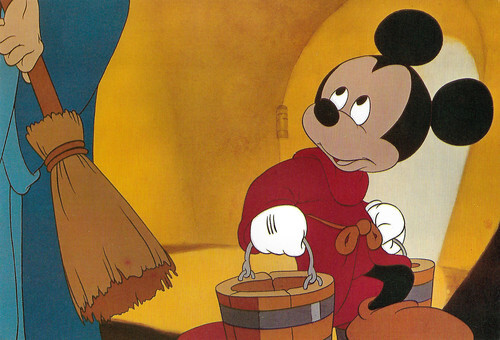
American postcard by Classico San Francisco, no. 328-013. Image: Walt Disney Productions. Mickey Mouse as the sorcerer's apprentice in Fantasia (James Algar, Wilfred Jackson, Hamilton Luske, Ben Sharpsteen, a.o., 1940).
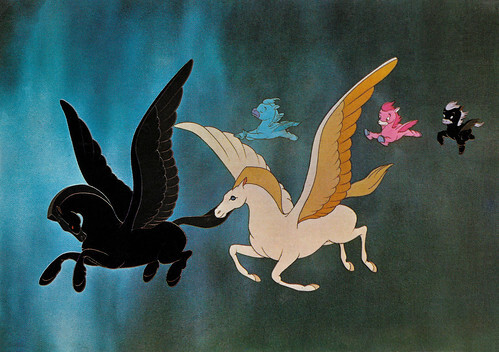
Italian postcard by Grafiche Biondetti, Verona, no. 120. Image: Walt Disney Productions. The Centaurs in the 'Pastoral Symphony' in Fantasia (James Algar, Wilfred Jackson, Hamilton Luske, Ben Sharpsteen, a.o., 1940).
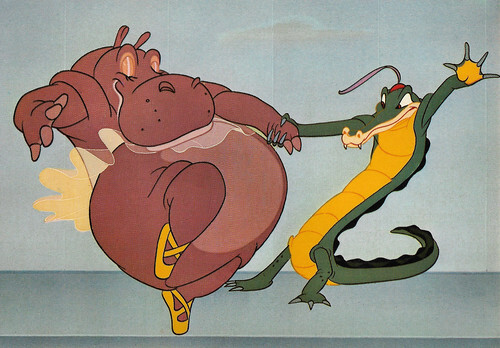
French postcard in the series The Wonderful World of Walt Disney by Editions Kroma, Caissargues, no. 6. Image: Walt Disney Productions. Publicity still for Fantasia (James Algar, Wilfred Jackson, Hamilton Luske, Ben Sharpsteen, a.o., 1940). Hyacinth Hippo and alligator dance partner in the segment Dance of the Hours.
One of the most iconic Mickey Mouse movies
Fantasia (1940) had the working title 'The Concert Feature'. Disney's third full-length animated feature was an experiment. Visualised animation is presented to the beat of classical music. For each of the seven parts, there is an introductory text. One then sees the animated film accompanied by the matching music, played by the Philadelphia Orchestra conducted by Leopold Stokowski.
The film opens without an opening title or logo. One sees a curtain open and the orchestra begins to play Toccata and Fugue in d-moll by Johann Sebastian Bach. The first section of the Toccata and Fugue, directed by Samuel Armstrong, is in live action and shows the orchestra as it plays music, accompanied by abstract light patterns. The picture then switches to an abstract cartoon, based on the works of German artist Oskar Fischinger. Live-action footage is again used for the finale.
The Nutcracker Suite by Pyotr Ilyich Tchaikovsky is the subject of the second segment. This film, also directed by Samuel Armstrong, is all about the changing of the seasons. It starts with summer and then continues through the other seasons until spring. It features many dance pieces. At the centre are animals, plants and fantasy creatures such as fairies. Beforehand, narrator Deems Taylor tells the audience that the ballet 'The Nutcracker' is no longer performed. Something that may have been the case in 1940 but is no longer the case now.
Then follows the film's most famous piece, The Sorcerer's Apprentice, with music by Paul Dukas and directed by James Algar. It is also one of the most iconic Mickey Mouse movies. The Sorcerer's Apprentice follows the story from Johann Wolfgang von Goethe's poem, starring Mickey as the sorcerer's apprentice. He enchants a broomstick so that it will fetch water for him. However, the broom continues its work until the whole room floods, and Mickey is unable to stop it. In a panic, he chops the broom to pieces, but each piece becomes a new broom that starts fetching water again. Eventually, magician Yen Sid (mirroring the name Disney) solves the problem, after which he fires Mickey and sends him away. At the end of the film, Mickey and conductor Leopold Stokowski, both in silhouette, shake hands.
The segment Le Sacre du printemps with music by Igor Stravinsky and directed by Bill Roberts and Paul Satterfield follows the creation of the earth, the first life forms, the flourishing of the dinosaurs and their eventual extinction. Remarkably for Disney, the animals were not anthropomorphised but moved and behaved realistically. Complex techniques were also used to depict volcanoes, boiling lava and earthquakes. Certain details have since been uncovered by palaeontological research, though. Tyrannosaurus rex and Stegosaurus did not live in the same era, the T. rex did not have three fingers on each hand but two, and the theory that dinosaurs died out due to drought and sandstorms has also been disproved.
Then follows a 15-minute interlude, directed by Sharpsteen and David D. Hand, in which the musicians leave the theatre and one is shown the title card of the film. The interlude is followed by a piece of jazz accompanied by a clarinet. With images, the audience is shown how sound waves work. The next segment, 'The Pastoral' with music by Ludwig van Beethoven and directed by Hamilton Luske, Jim Handley, and Ford Beebe, is set at the time of Greek mythology. It shows centaurs, the Olympian gods, satyrs and other mythological creatures, including Valentinian Cupids pairing male and female centaurs. These creatures hold a festival in honour of Bacchus, the god of wine. The festival is disrupted by Zeus, who unleashes a great thunderstorm on the revellers.
Ur Dance, with music by Amilcare Ponchielli and directed by T. Hee and Norm Ferguson, is a parody of ballet in which successive groups of ostriches, hippos, elephants and crocodiles dance. And finally, Night on Bald Mountain/Ave Maria with music by Modest Mussorgsky and Franz Schubert and directed by Wilfred Jackson is a diptych. The first part consists of 'The Night on Bald Mountain', in which at night a demon, Chernabog, awakens on a mountaintop. Béla Lugosi served as a live-action model for Chernabog and spent several days in the studio posing for the illustrators. He summons countless ghosts, monsters and the living dead and holds a ferocious feast. When morning comes and the church bells begin to ring, the demons are driven away and go to sleep. The second shutter immediately follows this and shows a large group of veiled people walking in procession with lanterns through a forest to the tune of 'Ave Maria'. It can be clearly seen that the diptych takes place during All Saints' Night and then connects through the morning.
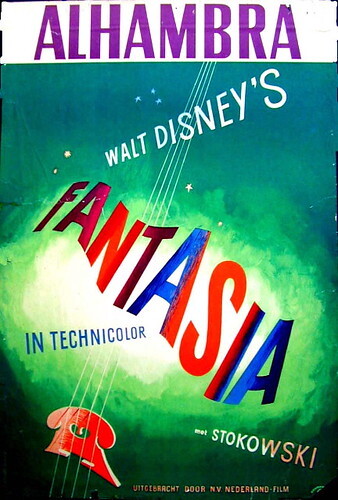
Dutch film poster by Ad Werner for Fantasia (Walt Disney, 1940).
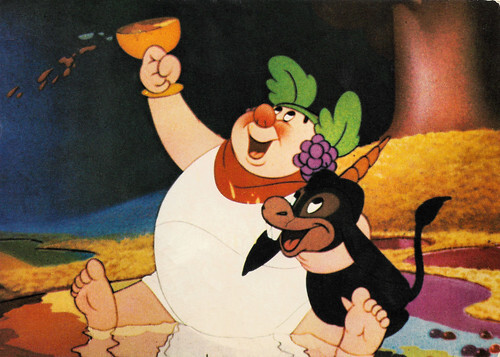
Italian postcard by Grafiche Biondetti, Verona, no. 120. Image: Walt Disney Productions. Publicity still for Fantasia (James Algar, Wilfred Jackson, Hamilton Luske, Ben Sharpsteen, a.o., 1940). Bacchus and Jacchus in the segment The Pastoral Symphony.
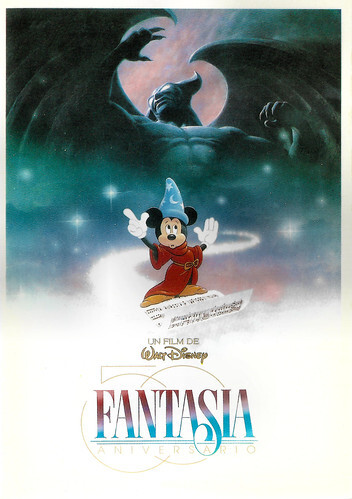
French postcard by Editions Mercuri, no. 223. Image: Walt Disney Productions. French re-issue poster for the 50th Anniversary of Fantasia (James Algar, Wilfred Jackson, Hamilton Luske, Ben Sharpsteen, a.o., 1940).
Disney's first feature-length animated film to flop mercilessly
In the late 1930s, the popularity of Walt Disney 's Mickey Mouse began to decline. To make the character more popular again, he made The Sorcerer's Apprentice. It was made as a special production, in which the character would not speak, and the images were accompanied by music by Paul Dukas, 'L'apprenti sorcier' (1897). While work on 'The Sorcerer's Apprentice' was in full swing, Disney met the famous conductor Leopold Stokowski. He offered to act as a conductor for the film and assembled an orchestra of one hundred musicians to record the music. At nine minutes in length, the film became two minutes longer than an average Mickey Mouse movie.
The production costs of The Sorcerer's Apprentice ran to $125,000, an amount Walt Disney knew he would never be able to recoup unless he came up with something bigger. At Stokowski's urging, he decided to expand the concept of The Sorcerer's Apprentice, adding more musical pieces to animated pictures. Disney hired composer and music critic Deems Taylor to talk the films together as narrator. Stokowski came up with the name Fantasia, and this became its final title. The working title of this film was 'The Concert Feature'. Although the Philadelphia Orchestra recorded the music for the film, they are not featured in the film. The orchestra seen playing in the film is made up of local Los Angeles musicians and Disney employees.
Walt Disney wanted Fantasia to be no ordinary film, but more like a signed concert. He had special programme books made for the screening. Every cinema where the film was shown was equipped with 30 or more speakers to give viewers the best possible sound. Fantasia originally had no intro piece or credits. Only a title card could be seen during the intermission section of the film. This title card was moved to the beginning of the film for later releases. Fantasia was first released in 1940 and again in 1985 and 1990.
Fantasia became Disney's first feature-length animated film to flop mercilessly at the box office. Intellectuals and fans of classical music found the film pure kitsch and the general public missed the unpretentious children's entertainment they always associated with Disney. One of the reasons that Fantasia lost so much also had to do with World War II, which deprived Disney of much of its market in Europe. The studio ran into major financial problems and quickly made a simpler feature-length animated film, Dumbo (Ben Sharpsteen, a.o., 1941), which again became a blockbuster. For Disney himself, however, it was a severe blow and he would never again take such a big artistic risk in his career.
The segment Pastorale was most often criticised by filmgoers as pure kitsch. Others criticised the scene in which some female centaurs briefly appear on screen with bare breasts. In The Night on Bald Mountain, too, we see women with bare breasts briefly appearing in the flames. Also, some centaurs are women with black skin and the lower body of a zebra, which comes across as somewhat racist these days. One scene was additionally censored on later video and DVD releases. This is a scene in which a black centaurin polishes the hooves of a white centaurin.
Despite its initially low yield, the film is now considered a classic. The initial wide release was a dismal box-office failure. In later years some theatre chains, which would normally run any Disney release, would not book the reissues of this film. However, by the 1969 reissue, the film attracted considerable interest for its supposedly psychedelic imagery and Disney marketed the film accordingly to take advantage of it. The reissue was successful and the film's reputation and popular appeal grew from that point to when its first home video release in 1991 broke records for sales. A sequel to the film was released in December 1999 under the name Fantasia 2000, initiated by Roy E. Disney.
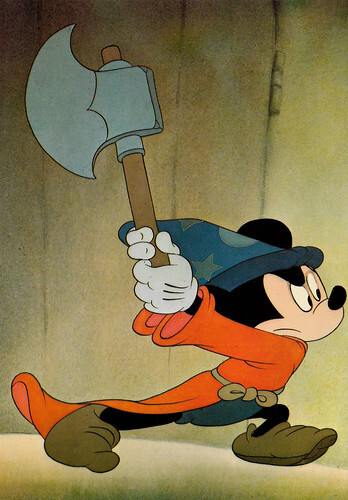
French postcard in the series The Wonderful World of Walt Disney by Editions Kroma, Caissargues, no. 5. Image: Walt Disney Productions. Mickey Mouse as the sorcerer's apprentice in Fantasia (James Algar, Wilfred Jackson, Hamilton Luske, Ben Sharpsteen, a.o., 1940).
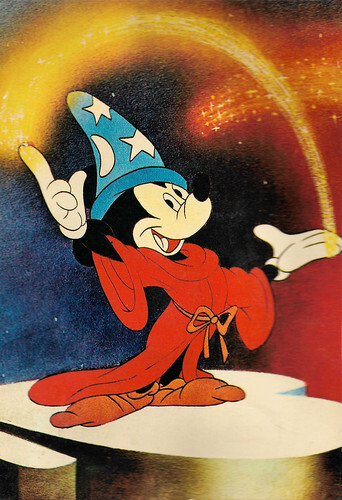
French postcard by Allain. Image: Walt Disney Productions. Mickey Mouse as the sorcerer's apprentice in Fantasia (James Algar, Wilfred Jackson, Hamilton Luske, Ben Sharpsteen, a.o., 1940).
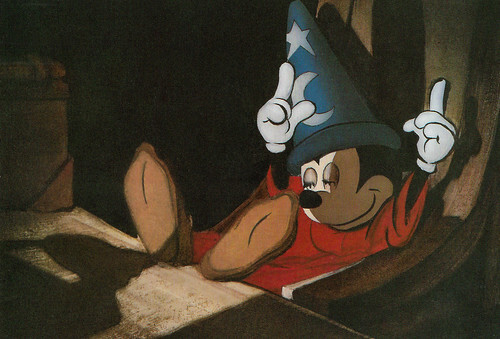
American postcard by Classico San Francisco, no. 328-009 Image: Walt Disney Productions. Mickey Mouse as the sorcerer's apprentice in Fantasia (James Algar, Wilfred Jackson, Hamilton Luske, Ben Sharpsteen, a.o., 1940).
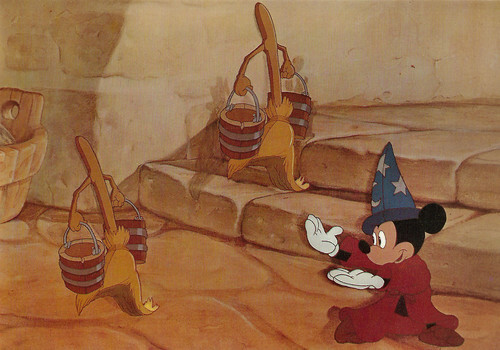
American postcard by Classico San Francisco, no. 328-011 Image: Walt Disney Productions. Mickey Mouse as the sorcerer's apprentice in Fantasia (James Algar, Wilfred Jackson, Hamilton Luske, Ben Sharpsteen, a.o., 1940).
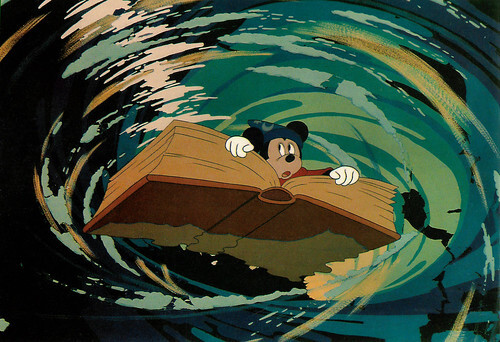
American postcard by Classico San Francisco, no. 328-008 Image: Walt Disney Productions. Mickey Mouse as the sorcerer's apprentice in Fantasia (James Algar, Wilfred Jackson, Hamilton Luske, Ben Sharpsteen, a.o., 1940).
Source: Hal Erickson (AllMovie), Wikipedia (Dutch) and IMDb.

American postcard by Classico San Francisco, no. 328-013. Image: Walt Disney Productions. Mickey Mouse as the sorcerer's apprentice in Fantasia (James Algar, Wilfred Jackson, Hamilton Luske, Ben Sharpsteen, a.o., 1940).

Italian postcard by Grafiche Biondetti, Verona, no. 120. Image: Walt Disney Productions. The Centaurs in the 'Pastoral Symphony' in Fantasia (James Algar, Wilfred Jackson, Hamilton Luske, Ben Sharpsteen, a.o., 1940).

French postcard in the series The Wonderful World of Walt Disney by Editions Kroma, Caissargues, no. 6. Image: Walt Disney Productions. Publicity still for Fantasia (James Algar, Wilfred Jackson, Hamilton Luske, Ben Sharpsteen, a.o., 1940). Hyacinth Hippo and alligator dance partner in the segment Dance of the Hours.
One of the most iconic Mickey Mouse movies
Fantasia (1940) had the working title 'The Concert Feature'. Disney's third full-length animated feature was an experiment. Visualised animation is presented to the beat of classical music. For each of the seven parts, there is an introductory text. One then sees the animated film accompanied by the matching music, played by the Philadelphia Orchestra conducted by Leopold Stokowski.
The film opens without an opening title or logo. One sees a curtain open and the orchestra begins to play Toccata and Fugue in d-moll by Johann Sebastian Bach. The first section of the Toccata and Fugue, directed by Samuel Armstrong, is in live action and shows the orchestra as it plays music, accompanied by abstract light patterns. The picture then switches to an abstract cartoon, based on the works of German artist Oskar Fischinger. Live-action footage is again used for the finale.
The Nutcracker Suite by Pyotr Ilyich Tchaikovsky is the subject of the second segment. This film, also directed by Samuel Armstrong, is all about the changing of the seasons. It starts with summer and then continues through the other seasons until spring. It features many dance pieces. At the centre are animals, plants and fantasy creatures such as fairies. Beforehand, narrator Deems Taylor tells the audience that the ballet 'The Nutcracker' is no longer performed. Something that may have been the case in 1940 but is no longer the case now.
Then follows the film's most famous piece, The Sorcerer's Apprentice, with music by Paul Dukas and directed by James Algar. It is also one of the most iconic Mickey Mouse movies. The Sorcerer's Apprentice follows the story from Johann Wolfgang von Goethe's poem, starring Mickey as the sorcerer's apprentice. He enchants a broomstick so that it will fetch water for him. However, the broom continues its work until the whole room floods, and Mickey is unable to stop it. In a panic, he chops the broom to pieces, but each piece becomes a new broom that starts fetching water again. Eventually, magician Yen Sid (mirroring the name Disney) solves the problem, after which he fires Mickey and sends him away. At the end of the film, Mickey and conductor Leopold Stokowski, both in silhouette, shake hands.
The segment Le Sacre du printemps with music by Igor Stravinsky and directed by Bill Roberts and Paul Satterfield follows the creation of the earth, the first life forms, the flourishing of the dinosaurs and their eventual extinction. Remarkably for Disney, the animals were not anthropomorphised but moved and behaved realistically. Complex techniques were also used to depict volcanoes, boiling lava and earthquakes. Certain details have since been uncovered by palaeontological research, though. Tyrannosaurus rex and Stegosaurus did not live in the same era, the T. rex did not have three fingers on each hand but two, and the theory that dinosaurs died out due to drought and sandstorms has also been disproved.
Then follows a 15-minute interlude, directed by Sharpsteen and David D. Hand, in which the musicians leave the theatre and one is shown the title card of the film. The interlude is followed by a piece of jazz accompanied by a clarinet. With images, the audience is shown how sound waves work. The next segment, 'The Pastoral' with music by Ludwig van Beethoven and directed by Hamilton Luske, Jim Handley, and Ford Beebe, is set at the time of Greek mythology. It shows centaurs, the Olympian gods, satyrs and other mythological creatures, including Valentinian Cupids pairing male and female centaurs. These creatures hold a festival in honour of Bacchus, the god of wine. The festival is disrupted by Zeus, who unleashes a great thunderstorm on the revellers.
Ur Dance, with music by Amilcare Ponchielli and directed by T. Hee and Norm Ferguson, is a parody of ballet in which successive groups of ostriches, hippos, elephants and crocodiles dance. And finally, Night on Bald Mountain/Ave Maria with music by Modest Mussorgsky and Franz Schubert and directed by Wilfred Jackson is a diptych. The first part consists of 'The Night on Bald Mountain', in which at night a demon, Chernabog, awakens on a mountaintop. Béla Lugosi served as a live-action model for Chernabog and spent several days in the studio posing for the illustrators. He summons countless ghosts, monsters and the living dead and holds a ferocious feast. When morning comes and the church bells begin to ring, the demons are driven away and go to sleep. The second shutter immediately follows this and shows a large group of veiled people walking in procession with lanterns through a forest to the tune of 'Ave Maria'. It can be clearly seen that the diptych takes place during All Saints' Night and then connects through the morning.

Dutch film poster by Ad Werner for Fantasia (Walt Disney, 1940).

Italian postcard by Grafiche Biondetti, Verona, no. 120. Image: Walt Disney Productions. Publicity still for Fantasia (James Algar, Wilfred Jackson, Hamilton Luske, Ben Sharpsteen, a.o., 1940). Bacchus and Jacchus in the segment The Pastoral Symphony.

French postcard by Editions Mercuri, no. 223. Image: Walt Disney Productions. French re-issue poster for the 50th Anniversary of Fantasia (James Algar, Wilfred Jackson, Hamilton Luske, Ben Sharpsteen, a.o., 1940).
Disney's first feature-length animated film to flop mercilessly
In the late 1930s, the popularity of Walt Disney 's Mickey Mouse began to decline. To make the character more popular again, he made The Sorcerer's Apprentice. It was made as a special production, in which the character would not speak, and the images were accompanied by music by Paul Dukas, 'L'apprenti sorcier' (1897). While work on 'The Sorcerer's Apprentice' was in full swing, Disney met the famous conductor Leopold Stokowski. He offered to act as a conductor for the film and assembled an orchestra of one hundred musicians to record the music. At nine minutes in length, the film became two minutes longer than an average Mickey Mouse movie.
The production costs of The Sorcerer's Apprentice ran to $125,000, an amount Walt Disney knew he would never be able to recoup unless he came up with something bigger. At Stokowski's urging, he decided to expand the concept of The Sorcerer's Apprentice, adding more musical pieces to animated pictures. Disney hired composer and music critic Deems Taylor to talk the films together as narrator. Stokowski came up with the name Fantasia, and this became its final title. The working title of this film was 'The Concert Feature'. Although the Philadelphia Orchestra recorded the music for the film, they are not featured in the film. The orchestra seen playing in the film is made up of local Los Angeles musicians and Disney employees.
Walt Disney wanted Fantasia to be no ordinary film, but more like a signed concert. He had special programme books made for the screening. Every cinema where the film was shown was equipped with 30 or more speakers to give viewers the best possible sound. Fantasia originally had no intro piece or credits. Only a title card could be seen during the intermission section of the film. This title card was moved to the beginning of the film for later releases. Fantasia was first released in 1940 and again in 1985 and 1990.
Fantasia became Disney's first feature-length animated film to flop mercilessly at the box office. Intellectuals and fans of classical music found the film pure kitsch and the general public missed the unpretentious children's entertainment they always associated with Disney. One of the reasons that Fantasia lost so much also had to do with World War II, which deprived Disney of much of its market in Europe. The studio ran into major financial problems and quickly made a simpler feature-length animated film, Dumbo (Ben Sharpsteen, a.o., 1941), which again became a blockbuster. For Disney himself, however, it was a severe blow and he would never again take such a big artistic risk in his career.
The segment Pastorale was most often criticised by filmgoers as pure kitsch. Others criticised the scene in which some female centaurs briefly appear on screen with bare breasts. In The Night on Bald Mountain, too, we see women with bare breasts briefly appearing in the flames. Also, some centaurs are women with black skin and the lower body of a zebra, which comes across as somewhat racist these days. One scene was additionally censored on later video and DVD releases. This is a scene in which a black centaurin polishes the hooves of a white centaurin.
Despite its initially low yield, the film is now considered a classic. The initial wide release was a dismal box-office failure. In later years some theatre chains, which would normally run any Disney release, would not book the reissues of this film. However, by the 1969 reissue, the film attracted considerable interest for its supposedly psychedelic imagery and Disney marketed the film accordingly to take advantage of it. The reissue was successful and the film's reputation and popular appeal grew from that point to when its first home video release in 1991 broke records for sales. A sequel to the film was released in December 1999 under the name Fantasia 2000, initiated by Roy E. Disney.

French postcard in the series The Wonderful World of Walt Disney by Editions Kroma, Caissargues, no. 5. Image: Walt Disney Productions. Mickey Mouse as the sorcerer's apprentice in Fantasia (James Algar, Wilfred Jackson, Hamilton Luske, Ben Sharpsteen, a.o., 1940).

French postcard by Allain. Image: Walt Disney Productions. Mickey Mouse as the sorcerer's apprentice in Fantasia (James Algar, Wilfred Jackson, Hamilton Luske, Ben Sharpsteen, a.o., 1940).

American postcard by Classico San Francisco, no. 328-009 Image: Walt Disney Productions. Mickey Mouse as the sorcerer's apprentice in Fantasia (James Algar, Wilfred Jackson, Hamilton Luske, Ben Sharpsteen, a.o., 1940).

American postcard by Classico San Francisco, no. 328-011 Image: Walt Disney Productions. Mickey Mouse as the sorcerer's apprentice in Fantasia (James Algar, Wilfred Jackson, Hamilton Luske, Ben Sharpsteen, a.o., 1940).

American postcard by Classico San Francisco, no. 328-008 Image: Walt Disney Productions. Mickey Mouse as the sorcerer's apprentice in Fantasia (James Algar, Wilfred Jackson, Hamilton Luske, Ben Sharpsteen, a.o., 1940).
Source: Hal Erickson (AllMovie), Wikipedia (Dutch) and IMDb.
Published on May 03, 2023 22:00
May 1, 2023
Emma Gramatica
Emma Gramatica (1874-1965) was a ‘monstre sacré’ of the Italian stage, but she also played many old ladies in Italian films from the 1930s to the 1950s. She was the sister of the equally famous Irma Gramatica.
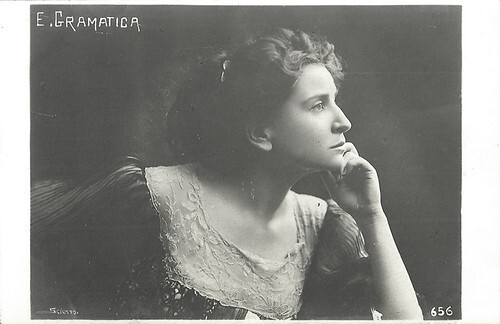
Italian postcard, no. 656. Photo: Sciutto, Genoa.

Italian postcard, no. 664. Photo: Sciutto, Genoa.
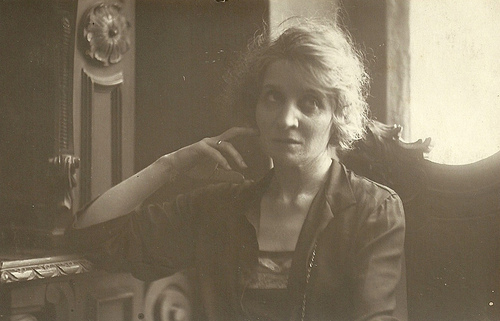
Italian postcard by Leonar, no. 2131. August 1922.
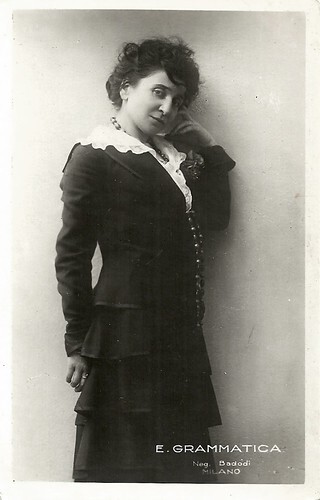
Italian postcard by Ed. A. Vettori, Bologna. Photo: Badodi, Milano.
An elegantly incisive interpretive charge
Emma Gramatica was born Aida Laura Argia Gramatica in Borgo San Donnino, Italy, in 1874. She was the sister of Irma Gramatica and of the lesser-known Anna Adele Alberta Gramatica. Anna was married to Ruggero Capodaglio and sister-in-law of the famous actress Wanda Capodaglio.
She was still a teenager when she made her stage debut next to Eleonora Duse in La Gioconda by Gabriele D'Annunzio. Emma was equipped with a physical appearance that was far from flashy, but with an elegantly incisive interpretive charge, she made her debut in the theatre.
Emma became the 'primattrice' (first actress) at the stage companies of some of the most prestigious names in the Italian theatre of the late 19th and the early 20th century, such as Ermete Zacconi , Flavio Andò, Enrico Reinach and Ermete Novelli .
In the 1910s she formed the famous company Gramatica-Carini-Piperno, in which many great actors formed such as Renzo Ricci and Lola Braccini.
In 1916 Emma debuted on the silver screen as a marriage wrecker in Quando il canto si spegne/When the hand goes out (Emilio Graziani-Walter, 1916), opposite Luigi Serventi . The film was produced by the Milanese company General Film. Although they praised her stage qualities, the press condemned her for her looks and theatricality and didn’t accept her as the mistress for which a man breaks up his marriage. Gramatica understood the message and would stay away from the screen until the arrival of sound cinema in Italy.
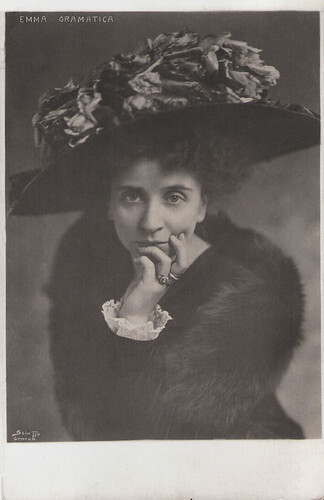
Italian/German postcard by NPG (Neue Photographische Gesellschaft). Photo: Sciutto, Genova.
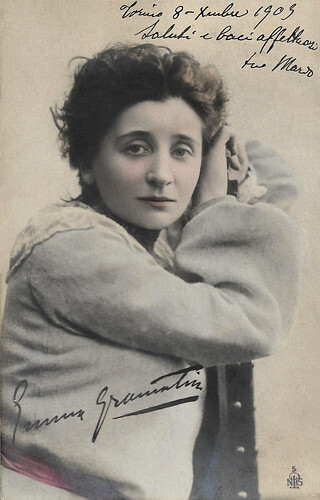
Italian/German postcard by NPG, no. 5.
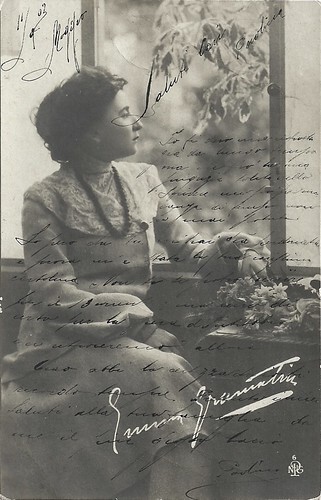
German postcard by NPG, no. 6. Card dated 11 September 1903. Back is Italian: ASC Diffida.
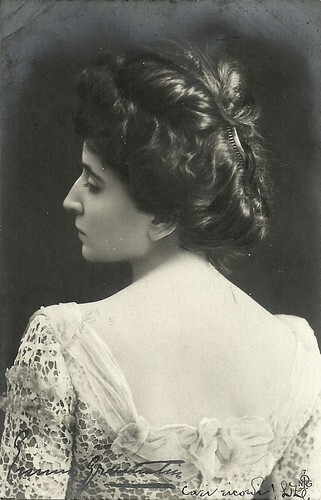
Italian/German postcard by NPG, no. 7. Back: ASC Diffida.
Acute and pathetic tones
From the early 1930s, Emma Gramatica did prose on radio, first with EIAR and later also with RAI. Gramatica was an actress of the old naturalist school, of acute and pathetic tones.
At a high age, she started a successful film and television career, starting with La vecchia signora/The Old Lady (Amleto Palermi, 1931) as an impoverished lady who sells chestnuts on the streets to support her niece.
Gramatica was memorable in Napoli d’altri tempi/Naples of Former Days (Amleto Palermi, 1938) starring Vittorio De Sica , in Mamma (Guido Brignone, 1941) as the mother of Beniamino Gigli , in the melodrama Sissignora/Yes, Madam (Ferdinando Maria Poggioli, 1941) and in the comedy Sorelle Materassi/The Materassi Sisters (Ferdinando Maria Poggioli, 1944), in which she and her sister Irma played two old spinsters.
In her most famous film, Miracolo in Milano/Miracle in Milan (Vittorio De Sica, 1951), she played old Lolotta who finds young Totò (Francesco Golisano) among the cauliflowers in her garden and raises him with an optimist and kind outlook.
She also appeared in Don Camillo Monsignore ... ma non troppo/Don Camillo: Monsignor (Carmine Gallone, 1961) starring Fernandel and Gino Cervi .
Emma Gramatica received awards and honours in Italy and also the Legion of Honor in France. She died in 1965 in Ostia, near Rome, and rests in the family tomb in the cemetery of Signa, with her sister Irma and their parents.

Italian/German postcard by NPG (Neue Photographische Gesellschaft). Mailed 11 December 1903.

Italian postcard, no. 655. Photo: Sciutto, Genoa.
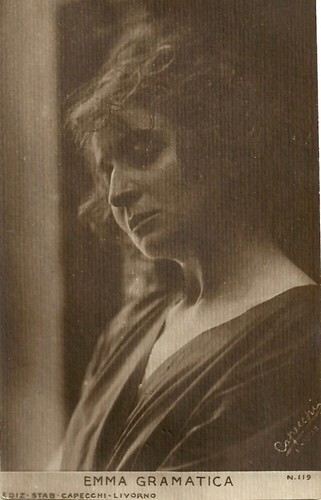
Italian postcard by Ed. Stab. Capecchi, Livorno, no. 118. Photo: Capecchi, Livorno.

Italian postcard for Sissignora/Yes Madam (Ferdinando Maria Poggioli, 1941), with Maria Denis , Irma Gramatica , Emma Gramatica, and Leonardo Cortese .
Sources: Wikipedia (Italian and English) and .

Italian postcard, no. 656. Photo: Sciutto, Genoa.

Italian postcard, no. 664. Photo: Sciutto, Genoa.

Italian postcard by Leonar, no. 2131. August 1922.

Italian postcard by Ed. A. Vettori, Bologna. Photo: Badodi, Milano.
An elegantly incisive interpretive charge
Emma Gramatica was born Aida Laura Argia Gramatica in Borgo San Donnino, Italy, in 1874. She was the sister of Irma Gramatica and of the lesser-known Anna Adele Alberta Gramatica. Anna was married to Ruggero Capodaglio and sister-in-law of the famous actress Wanda Capodaglio.
She was still a teenager when she made her stage debut next to Eleonora Duse in La Gioconda by Gabriele D'Annunzio. Emma was equipped with a physical appearance that was far from flashy, but with an elegantly incisive interpretive charge, she made her debut in the theatre.
Emma became the 'primattrice' (first actress) at the stage companies of some of the most prestigious names in the Italian theatre of the late 19th and the early 20th century, such as Ermete Zacconi , Flavio Andò, Enrico Reinach and Ermete Novelli .
In the 1910s she formed the famous company Gramatica-Carini-Piperno, in which many great actors formed such as Renzo Ricci and Lola Braccini.
In 1916 Emma debuted on the silver screen as a marriage wrecker in Quando il canto si spegne/When the hand goes out (Emilio Graziani-Walter, 1916), opposite Luigi Serventi . The film was produced by the Milanese company General Film. Although they praised her stage qualities, the press condemned her for her looks and theatricality and didn’t accept her as the mistress for which a man breaks up his marriage. Gramatica understood the message and would stay away from the screen until the arrival of sound cinema in Italy.

Italian/German postcard by NPG (Neue Photographische Gesellschaft). Photo: Sciutto, Genova.

Italian/German postcard by NPG, no. 5.

German postcard by NPG, no. 6. Card dated 11 September 1903. Back is Italian: ASC Diffida.

Italian/German postcard by NPG, no. 7. Back: ASC Diffida.
Acute and pathetic tones
From the early 1930s, Emma Gramatica did prose on radio, first with EIAR and later also with RAI. Gramatica was an actress of the old naturalist school, of acute and pathetic tones.
At a high age, she started a successful film and television career, starting with La vecchia signora/The Old Lady (Amleto Palermi, 1931) as an impoverished lady who sells chestnuts on the streets to support her niece.
Gramatica was memorable in Napoli d’altri tempi/Naples of Former Days (Amleto Palermi, 1938) starring Vittorio De Sica , in Mamma (Guido Brignone, 1941) as the mother of Beniamino Gigli , in the melodrama Sissignora/Yes, Madam (Ferdinando Maria Poggioli, 1941) and in the comedy Sorelle Materassi/The Materassi Sisters (Ferdinando Maria Poggioli, 1944), in which she and her sister Irma played two old spinsters.
In her most famous film, Miracolo in Milano/Miracle in Milan (Vittorio De Sica, 1951), she played old Lolotta who finds young Totò (Francesco Golisano) among the cauliflowers in her garden and raises him with an optimist and kind outlook.
She also appeared in Don Camillo Monsignore ... ma non troppo/Don Camillo: Monsignor (Carmine Gallone, 1961) starring Fernandel and Gino Cervi .
Emma Gramatica received awards and honours in Italy and also the Legion of Honor in France. She died in 1965 in Ostia, near Rome, and rests in the family tomb in the cemetery of Signa, with her sister Irma and their parents.

Italian/German postcard by NPG (Neue Photographische Gesellschaft). Mailed 11 December 1903.

Italian postcard, no. 655. Photo: Sciutto, Genoa.

Italian postcard by Ed. Stab. Capecchi, Livorno, no. 118. Photo: Capecchi, Livorno.

Italian postcard for Sissignora/Yes Madam (Ferdinando Maria Poggioli, 1941), with Maria Denis , Irma Gramatica , Emma Gramatica, and Leonardo Cortese .
Sources: Wikipedia (Italian and English) and .
Published on May 01, 2023 22:00
April 30, 2023
Photo by Hämmerer
Arthur (or Artur) Hämmerer was a now-forgotten portrait and still photographer and painter from the Nazi period. From 1935 on, he was one of the most prominent photographers who worked for the Ufa. This gigantic film company, headquartered in Babelsberg, near Berlin, produced and distributed hundreds of films from 1917 until the end of the Nazi era. During the war years, Hämmerer moved to Vienna and started to work for Wien-Film. After the war, he stayed in Austria and continued to make great star portraits for the film industry. Many of his pictures can be discovered on Ross Verlag postcards but also on cigarette cards and on post-war postcards by Film-Foto-Verlag and other publishers. In this post gives we give you an impression of Hämmerer's portraits.
Ross Verlag
From 1935 on, Arthür Hämmerer made photo portraits for the Ufa which were used for the popular Ross postcards. Hämmerer photographed mainly German and Austrian actors, but also Hollywood movie star Rochelle Hudson. During the war years, he worked for the Viennese studio Wien-Film.
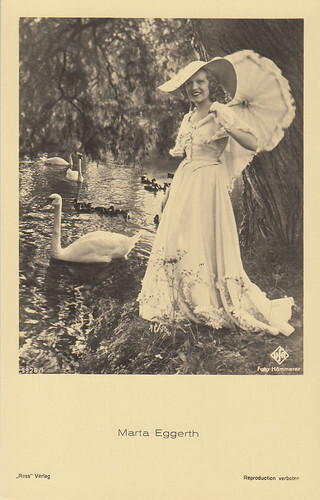
German postcard by Ross Verlag, no. 9928/1, 1935-1936. Photo: Hämmerer / Ufa. Marta Eggerth in Das Hofkonzert/The Court Concert (Detlev Sierck a.k.a. Douglas Sirk, 1936). Collection: Marlene Pilaete.
Hungarian-born singer and actress Márta Eggerth (1912-2013) maintained a global career for over 70 years. She was the popular and talented star of 30 German and Austrian operetta films of the 1930s. Many of the 20th century's most famous operetta composers, including Franz Lehár, Fritz Kreisler, Robert Stolz, Oscar Straus, and Paul Abraham, composed works especially for her. After the rise of the Nazis, she continued her career with her partner Jan Kiepura in the US.
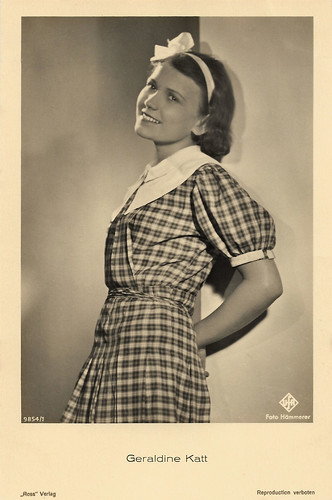
German postcard by Ross Verlag, no. 9854/1, 1935-1936. Photo: Hämmerer / Ufa.
Geraldine Katt (1920-1995) was an Austrian actress, who was seen in romantic comedies and melodramas of the 1930s and 1940s. She appeared in more than ten films from 1936 to 1951.
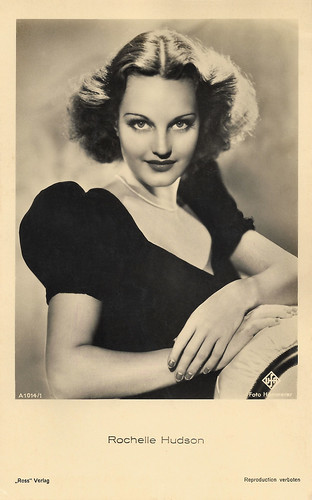
German postcard by Ross Verlag, no. A 1014/1, 1937-1938. Photo: Hämmerer / Ufa.
American film actress Rochelle Hudson (1916–1972) appeared in Hollywood films from the early 1930s through the 1960s. Her roles went from ingenue to leading lady to character actress. She is best remembered for co-starring in the tense and gripping social drama Wild Boys of the Road (William A. Wellman, 1933), playing Cosette in Les Misérables (Richard Boleslawski, 1935), as the older sister of Shirley Temple in Curly Top (Irving Cummings, 1935), and as Natalie Wood's mother in Rebel Without a Cause (Nicholas Ray, 1955).
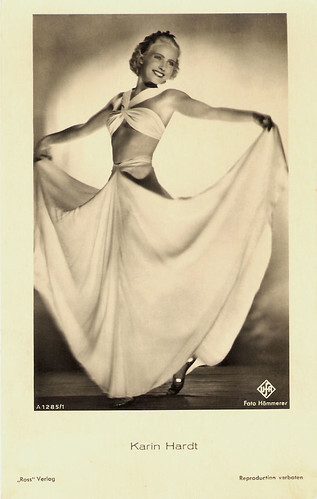
German postcard by Ross Verlag, no. A 1285/1, 1937-1938. Photo: Hämmerer / Ufa.
German actress Karin Hardt (1910-1992) made her cinema debut as a pure and disarmingly natural backfisch, looking for happiness. Her impressive career with many film, theatre and television appearances lasted for six decades.
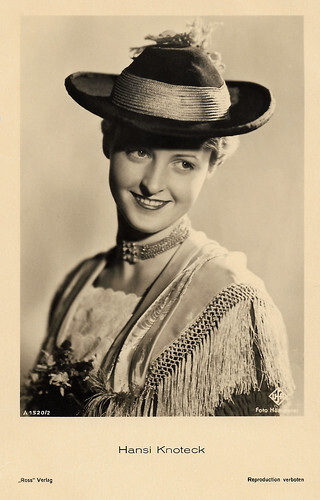
German postcard by Ross Verlag, no. A 1520/2, 1937-1938. Photo: Ufa / Hämmerer. Hansi Knoteck in Gewitter im Mai/Storms in May (Hans Deppe, 1938).
Austrian singer, stage, and film actress Hansi Knoteck (1914-2013) starred in 18 films in just five years - between 1934 and 1939. She often played the natural, sweet Dirndl in Heimatfilms. She continued her film and stage career until the mid-1970s.
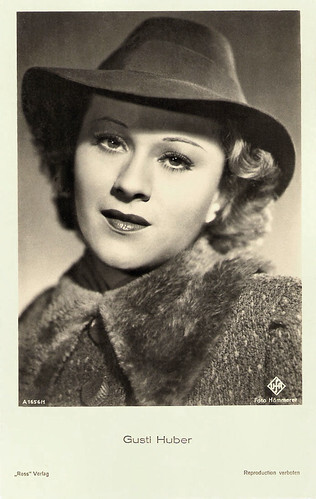
German postcard by Ross Verlag, no. A 1656/1, 1938-1939. Photo: Ufa / Hämmerer.
Gusti Huber (1914-1993) was an Austrian stage and film actress. She was a popular actress in the cinema of Nazi Germany. In 1946 she moved with her American husband to the US and continued her career on Broadway. She played Anne Frank's mother in the Pulitzer Prize-winning play 'The Diary of Anne Frank' and later also in the film version.
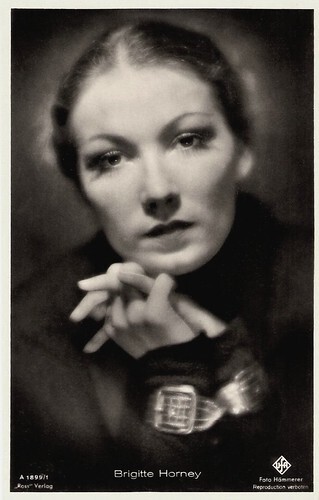
German postcard by Ross Verlag, no. A 1899/1, 1937-1938. Photo: Ufa / Hämmerer.
Charismatic German theatre and film actress Brigitte Horney (1911-1988) worked both in German and English films. Her earthy charm, prominent cheekbones and deep, sultry voice made her stand out from her colleagues. She is best remembered as Empress Katherine the Great in the lavish Ufa spectacle Munchhausen/The Adventures of Baron Munchausen (1943). After the war, she moved to the US and became an American citizen.
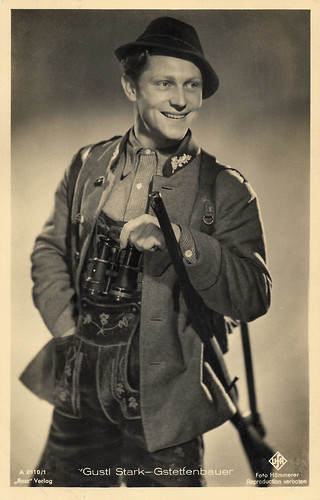
German postcard by Ross Verlag, no. A 2110/1, 1939-1940. Photo: Hämmerer / Ufa. Gustl Stark-Gstettenbaur in Der Edelweißkönig/King of the Edelweiss (Paul May, 1939).
German stage, film, and television actor Gustl Stark-Gstettenbaur (1914-1996) or Gustl (Stark-)Gstettenbauer began his career onstage as a child actor in 1927, at the age of thirteen. He went on to play a variety of juvenile roles in German films during the late silent film era. Gstettenbaur's career continued as an adult on stage, in film, and on television.
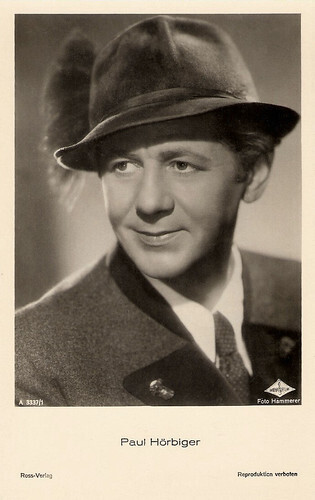
German postcard by Ross Verlag, no. A 3337/1, 1941-1944. Photo: Hämmerer / Wien Film.
Actor Paul Hörbiger (1894-1981) belongs together with Hans Moser to the ‘primary rock’ of the Austrian cinema. His popularity was unique and was reflected in over 200 films.
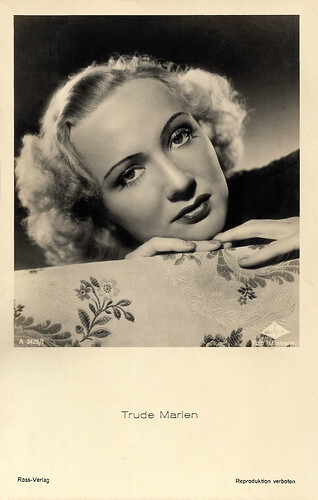
German postcard by Ross Verlag, no. A 3426/1, 1941-1944. Photo: Wien-Film / Hämmerer.
Trude Marlen (1912-2005), was a curly-locked Austrian leading lady of the 1930s. From 1933 until the 1940s, she made mostly light entertainment films as a Ufa star, in which Willi Forst was often her partner. The Ufa traded her as the German answer to Jean Harlow, but for the most part, she was rather the Viennese equivalent of the 'girl next door', engaging and uncomplicated.
Ross Verlag Film Grossbilder
In 1936 and 1937, Ross made a series of "Film Grossbilder", big black and white cards with size 5 1/4" x 7" or 13 x 18 cm. Ross published the cards for the Union Cigarettenfabrik (Union Cigarette Factory). This series of large cigarette cards was available to those who purchased Romana cigarettes.
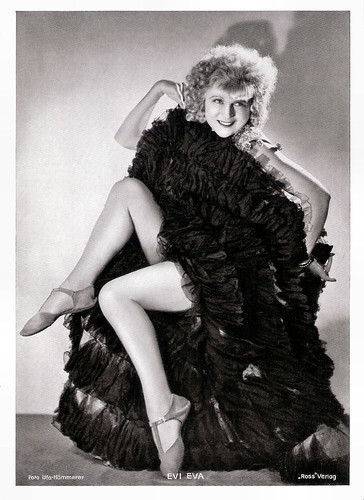
Big German card by Ross Verlag. Photo: Ufa / Hämmerer.
German actress Evi Eva (1899-1985) was a popular star of silent cinema. She often impersonated 'Berliner Gören' or 'Backfische' (brats) in film comedies. Later, the once-famous actress lived in very poor conditions.
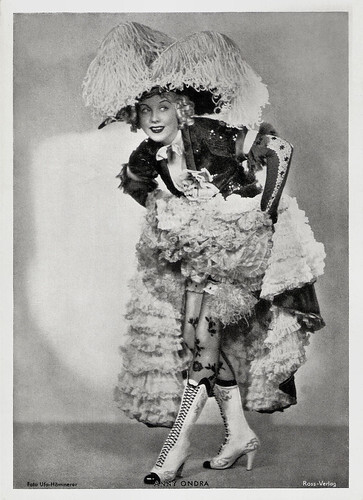
Big German collectors card by Ross Verlag. Photo: Ufa / Hämmerer. Anny Ondra in Ein Mädel von Ballett/A Girl from the Chorus (Karel Lamac, 1937).
Anny Ondra (1903-1987) was a Polish-Czech-Austrian-German-French singer, film, and stage actress. During the 1920s and 1930s, she was a popular actress in Czech, Austrian and German comedies, and she was Alfred Hitchcock’s first ‘Blonde’.
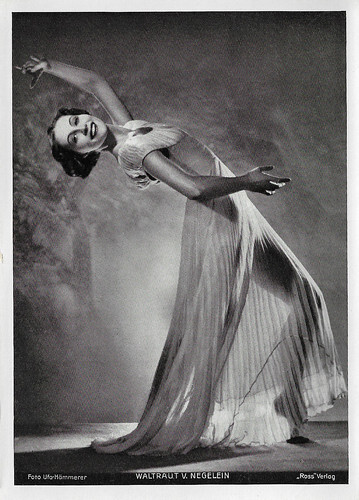
Big German card by Ross Verlag. Photo: Hämmerer / Ufa.
Waltraut von Negelein appeared in only two films, Daphne und der Diplomat/Daphne and the Diplomat (Robert A. Stemmle, 1937) with Karin Hardt, and the Western Frauen für Golden Hill/Women for Golden Hill (Erich Waschneck, 1938) with Kirsten Heiberg.
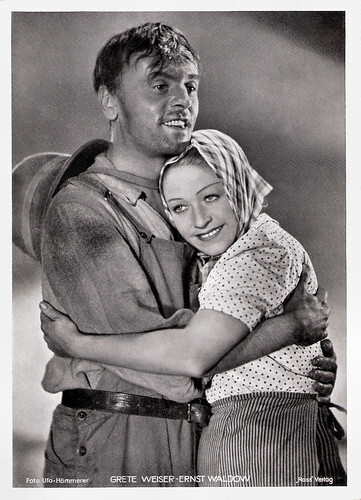
Big German card by Ross Verlag. Photo: Ufa / Hämmerer. Publicity still for Frauen für Golden Hill/Women for Golden Hill (Erich Waschneck, 1938).
Grethe Weiser (1903-1970) was a German singer, comedian, film and stage actress. She made more than 140 films.
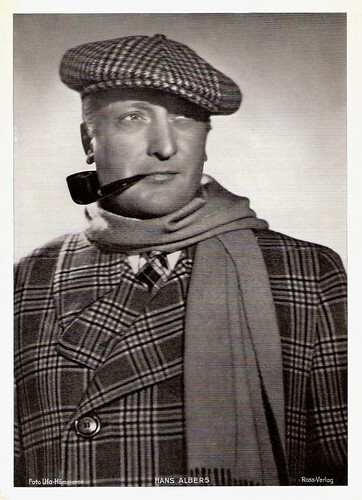
Big card by Ross Verlag. Photo: Ufa / Hämmerer. Hans Albers in Der Mann, der Sherlock Holmes war/The Man Who Was Sherlock Holmes (Karl Hartl, 1937).
Jovial, pleasantly plump Hans Albers (1891–1960) was a superstar of German cinema between 1930 and 1945. He was also one of the most popular German singers of the twentieth century. His song 'Auf der Reeperbahn nachts um halb eins' (On the Reeperbahn at half past midnight) is the unofficial anthem of Hamburg’s neighbourhood of St. Pauli, which is famous for its brothels, music and nightclubs.
Film Foto-Verlag
Ross Verlag seemed to disappear by the end of the war. The National Socialists had retained the name after they had forced Heinrich Ross out of his own company. But during the Second World War, they also started to use the name Film-Foto-Verlag. The design of the cards and the numbering system did not alter. Hämmerer's photos for Wien-Film also found their way to the postcards of this publisher.
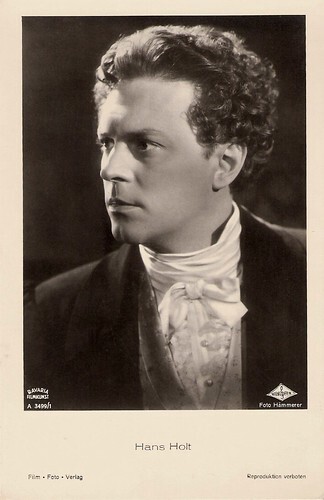
German postcard by Film-Foto-Verlag, no. A 3499/1, 1941-1944. Photo: Hämmerer / Wien-Film / Bavaria Filmkunst. Hans Holt in Brüderlein fein/Little brother fine (Hans Thimig, 1942).
Austrian actor Hans Holt (1909-2001) appeared in nearly 100 films in a career that stretched back to 1935. He portrayed Baron Von Trapp in two German films from the 1950s, a role which Christopher Plummer later played in the musical The Sound of Music.
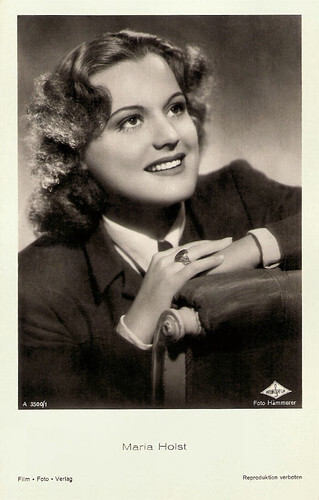
German postcard by Film-Foto-Verlag, no. A 3500/1, 1941-1944. Photo: Hämmerer / Wien Film.
Austrian actress Maria Holst (1917-1980) appeared in many plays of the famous Viennese Burgtheater and also in several popular films of the 1930s, 1940s and 1950s. She died tragically.
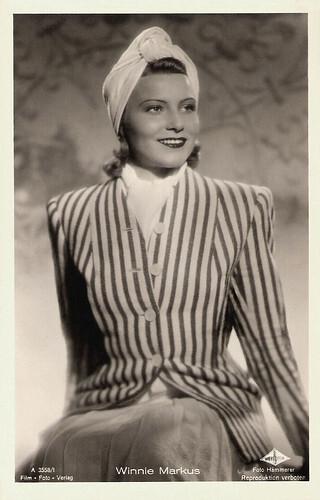
German postcard by Film-Foto-Verlag, no. A 3558/1, 1941-1944. Photo: Hämmerer / Wien-Film.
Blonde Winnie Markus (1921-2002) started as a Ufa star during the Nazi period and became one of Germany’s most famous actresses in the 1950s.
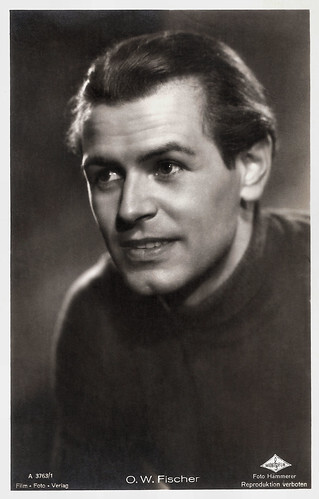
German postcard by Film-Foto-Verlag, no. A 3763/1, 1941-1944. Photo: Wien-Film / Hämmerer.
Austrian actor O.W. Fischer (1915–2004) was one of the most popular and highest-paid actors in German-language films in the 1950s. He played the lead in dozens of light romantic comedies and historical pieces. Unlike countrymen Curd Jürgens, Maria Schell and Romy Schneider, he never made it internationally.
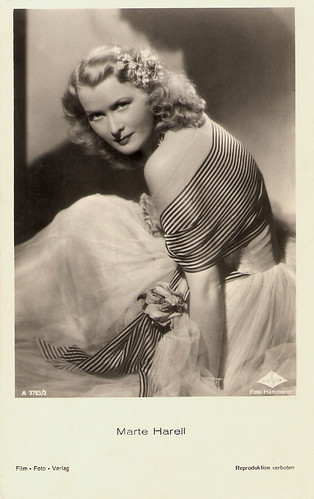
German postcard by Film-Foto-Verlag, no. A 3765/2, 1941-1944. Photo: Hämmerer / Wien-Film.
Austrian actress Marte Harell (1907-1996) played strong women who determined the events, in several Viennese comedies and operettas of the 1940s and 1950s.
Various publishers
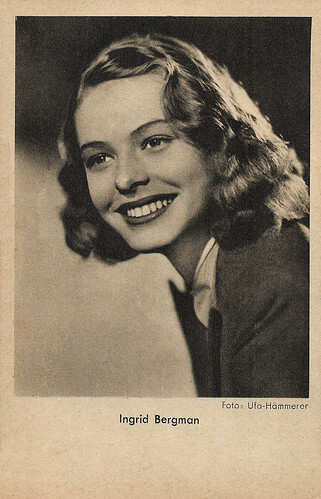
German postcard. Photo: Ufa / Hämmerer. Ingrid Bergman in Die vier Gesellen/The Four Companions (Carl Froelich, 1938).
Ingrid Bergman (1915-1982) was ‘Sweden's illustrious gift to Hollywood’. In the 1940s the fresh and naturally beautiful actress won three times the Oscar, twice the Emmy, and once the Tony Award for Best Actress. Little known is that before she went to Hollywood she already had a European film career.
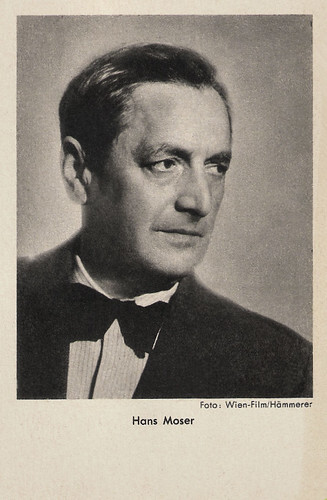
German postcard by Das Programm von Heute / Ross Verlag, Berlin. Photo: Wien-Film / Hämmerer.
Austrian actor Hans Moser (1880-1964) appeared in over 150 films. During his long career, from the 1920s up to his death, he became very popular as the mumbling factotum in comedy films. Moser was particularly associated with the genre of the Wiener Film.
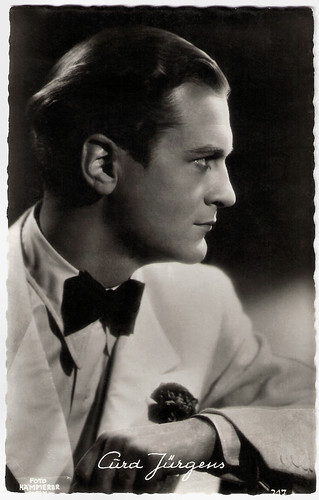
Austrian postcard by Verlag Hubmann, Wien (Vienna), no. 3323. Photo: Hämmerer, Wien.
Tall, blonde, blue-eyed Curd Jürgens (1915-1982) played German soldiers in countless World War II films, usually billed as Curt Jurgens. Although the German-Austrian actor appeared in over 100 films, Jürgens considered himself primarily a stage actor. He also directed a few films with limited success and wrote screenplays.
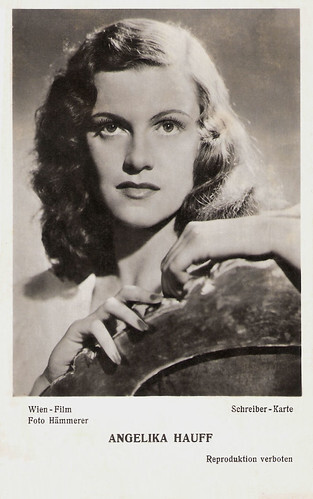
Austrian postcard by Schreiber-Karte, no. 70087. Photo: Hämmerer / Wien-Film.
Austrian film and stage actress Angelika Hauff (1922–1983) played the lead in several post-war German and Austrian films. For the East-German DEFA studio, she appeared in three films, including the box office hit Figaros Hochzeit/The Marriage of Figaro (1949).
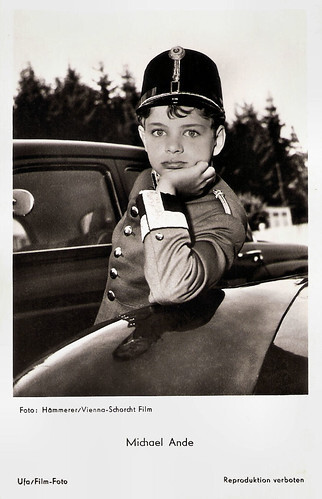
German postcard by Ufa/Film-Foto, Berlin-Tempelhof, no. FK 3875. Photo: Hämmerer / Vienna / Schorcht Film. Publicity still for Skandal in Ischl/Scandal in Bad Ischl (Rolf Thiele, 1957).
German actor Michael Ande (1944) was a well-known child star of German cinema during the 1950s. Nowadays he is best known for his role in the West German Krimi TV series Der Alte/The Old Fox (1977-2016).
Sources: Peter Ernst (German - Unse Kienwerder), Filmportal, and .
Ross Verlag
From 1935 on, Arthür Hämmerer made photo portraits for the Ufa which were used for the popular Ross postcards. Hämmerer photographed mainly German and Austrian actors, but also Hollywood movie star Rochelle Hudson. During the war years, he worked for the Viennese studio Wien-Film.

German postcard by Ross Verlag, no. 9928/1, 1935-1936. Photo: Hämmerer / Ufa. Marta Eggerth in Das Hofkonzert/The Court Concert (Detlev Sierck a.k.a. Douglas Sirk, 1936). Collection: Marlene Pilaete.
Hungarian-born singer and actress Márta Eggerth (1912-2013) maintained a global career for over 70 years. She was the popular and talented star of 30 German and Austrian operetta films of the 1930s. Many of the 20th century's most famous operetta composers, including Franz Lehár, Fritz Kreisler, Robert Stolz, Oscar Straus, and Paul Abraham, composed works especially for her. After the rise of the Nazis, she continued her career with her partner Jan Kiepura in the US.

German postcard by Ross Verlag, no. 9854/1, 1935-1936. Photo: Hämmerer / Ufa.
Geraldine Katt (1920-1995) was an Austrian actress, who was seen in romantic comedies and melodramas of the 1930s and 1940s. She appeared in more than ten films from 1936 to 1951.

German postcard by Ross Verlag, no. A 1014/1, 1937-1938. Photo: Hämmerer / Ufa.
American film actress Rochelle Hudson (1916–1972) appeared in Hollywood films from the early 1930s through the 1960s. Her roles went from ingenue to leading lady to character actress. She is best remembered for co-starring in the tense and gripping social drama Wild Boys of the Road (William A. Wellman, 1933), playing Cosette in Les Misérables (Richard Boleslawski, 1935), as the older sister of Shirley Temple in Curly Top (Irving Cummings, 1935), and as Natalie Wood's mother in Rebel Without a Cause (Nicholas Ray, 1955).

German postcard by Ross Verlag, no. A 1285/1, 1937-1938. Photo: Hämmerer / Ufa.
German actress Karin Hardt (1910-1992) made her cinema debut as a pure and disarmingly natural backfisch, looking for happiness. Her impressive career with many film, theatre and television appearances lasted for six decades.

German postcard by Ross Verlag, no. A 1520/2, 1937-1938. Photo: Ufa / Hämmerer. Hansi Knoteck in Gewitter im Mai/Storms in May (Hans Deppe, 1938).
Austrian singer, stage, and film actress Hansi Knoteck (1914-2013) starred in 18 films in just five years - between 1934 and 1939. She often played the natural, sweet Dirndl in Heimatfilms. She continued her film and stage career until the mid-1970s.

German postcard by Ross Verlag, no. A 1656/1, 1938-1939. Photo: Ufa / Hämmerer.
Gusti Huber (1914-1993) was an Austrian stage and film actress. She was a popular actress in the cinema of Nazi Germany. In 1946 she moved with her American husband to the US and continued her career on Broadway. She played Anne Frank's mother in the Pulitzer Prize-winning play 'The Diary of Anne Frank' and later also in the film version.

German postcard by Ross Verlag, no. A 1899/1, 1937-1938. Photo: Ufa / Hämmerer.
Charismatic German theatre and film actress Brigitte Horney (1911-1988) worked both in German and English films. Her earthy charm, prominent cheekbones and deep, sultry voice made her stand out from her colleagues. She is best remembered as Empress Katherine the Great in the lavish Ufa spectacle Munchhausen/The Adventures of Baron Munchausen (1943). After the war, she moved to the US and became an American citizen.

German postcard by Ross Verlag, no. A 2110/1, 1939-1940. Photo: Hämmerer / Ufa. Gustl Stark-Gstettenbaur in Der Edelweißkönig/King of the Edelweiss (Paul May, 1939).
German stage, film, and television actor Gustl Stark-Gstettenbaur (1914-1996) or Gustl (Stark-)Gstettenbauer began his career onstage as a child actor in 1927, at the age of thirteen. He went on to play a variety of juvenile roles in German films during the late silent film era. Gstettenbaur's career continued as an adult on stage, in film, and on television.

German postcard by Ross Verlag, no. A 3337/1, 1941-1944. Photo: Hämmerer / Wien Film.
Actor Paul Hörbiger (1894-1981) belongs together with Hans Moser to the ‘primary rock’ of the Austrian cinema. His popularity was unique and was reflected in over 200 films.

German postcard by Ross Verlag, no. A 3426/1, 1941-1944. Photo: Wien-Film / Hämmerer.
Trude Marlen (1912-2005), was a curly-locked Austrian leading lady of the 1930s. From 1933 until the 1940s, she made mostly light entertainment films as a Ufa star, in which Willi Forst was often her partner. The Ufa traded her as the German answer to Jean Harlow, but for the most part, she was rather the Viennese equivalent of the 'girl next door', engaging and uncomplicated.
Ross Verlag Film Grossbilder
In 1936 and 1937, Ross made a series of "Film Grossbilder", big black and white cards with size 5 1/4" x 7" or 13 x 18 cm. Ross published the cards for the Union Cigarettenfabrik (Union Cigarette Factory). This series of large cigarette cards was available to those who purchased Romana cigarettes.

Big German card by Ross Verlag. Photo: Ufa / Hämmerer.
German actress Evi Eva (1899-1985) was a popular star of silent cinema. She often impersonated 'Berliner Gören' or 'Backfische' (brats) in film comedies. Later, the once-famous actress lived in very poor conditions.

Big German collectors card by Ross Verlag. Photo: Ufa / Hämmerer. Anny Ondra in Ein Mädel von Ballett/A Girl from the Chorus (Karel Lamac, 1937).
Anny Ondra (1903-1987) was a Polish-Czech-Austrian-German-French singer, film, and stage actress. During the 1920s and 1930s, she was a popular actress in Czech, Austrian and German comedies, and she was Alfred Hitchcock’s first ‘Blonde’.

Big German card by Ross Verlag. Photo: Hämmerer / Ufa.
Waltraut von Negelein appeared in only two films, Daphne und der Diplomat/Daphne and the Diplomat (Robert A. Stemmle, 1937) with Karin Hardt, and the Western Frauen für Golden Hill/Women for Golden Hill (Erich Waschneck, 1938) with Kirsten Heiberg.

Big German card by Ross Verlag. Photo: Ufa / Hämmerer. Publicity still for Frauen für Golden Hill/Women for Golden Hill (Erich Waschneck, 1938).
Grethe Weiser (1903-1970) was a German singer, comedian, film and stage actress. She made more than 140 films.

Big card by Ross Verlag. Photo: Ufa / Hämmerer. Hans Albers in Der Mann, der Sherlock Holmes war/The Man Who Was Sherlock Holmes (Karl Hartl, 1937).
Jovial, pleasantly plump Hans Albers (1891–1960) was a superstar of German cinema between 1930 and 1945. He was also one of the most popular German singers of the twentieth century. His song 'Auf der Reeperbahn nachts um halb eins' (On the Reeperbahn at half past midnight) is the unofficial anthem of Hamburg’s neighbourhood of St. Pauli, which is famous for its brothels, music and nightclubs.
Film Foto-Verlag
Ross Verlag seemed to disappear by the end of the war. The National Socialists had retained the name after they had forced Heinrich Ross out of his own company. But during the Second World War, they also started to use the name Film-Foto-Verlag. The design of the cards and the numbering system did not alter. Hämmerer's photos for Wien-Film also found their way to the postcards of this publisher.

German postcard by Film-Foto-Verlag, no. A 3499/1, 1941-1944. Photo: Hämmerer / Wien-Film / Bavaria Filmkunst. Hans Holt in Brüderlein fein/Little brother fine (Hans Thimig, 1942).
Austrian actor Hans Holt (1909-2001) appeared in nearly 100 films in a career that stretched back to 1935. He portrayed Baron Von Trapp in two German films from the 1950s, a role which Christopher Plummer later played in the musical The Sound of Music.

German postcard by Film-Foto-Verlag, no. A 3500/1, 1941-1944. Photo: Hämmerer / Wien Film.
Austrian actress Maria Holst (1917-1980) appeared in many plays of the famous Viennese Burgtheater and also in several popular films of the 1930s, 1940s and 1950s. She died tragically.

German postcard by Film-Foto-Verlag, no. A 3558/1, 1941-1944. Photo: Hämmerer / Wien-Film.
Blonde Winnie Markus (1921-2002) started as a Ufa star during the Nazi period and became one of Germany’s most famous actresses in the 1950s.

German postcard by Film-Foto-Verlag, no. A 3763/1, 1941-1944. Photo: Wien-Film / Hämmerer.
Austrian actor O.W. Fischer (1915–2004) was one of the most popular and highest-paid actors in German-language films in the 1950s. He played the lead in dozens of light romantic comedies and historical pieces. Unlike countrymen Curd Jürgens, Maria Schell and Romy Schneider, he never made it internationally.

German postcard by Film-Foto-Verlag, no. A 3765/2, 1941-1944. Photo: Hämmerer / Wien-Film.
Austrian actress Marte Harell (1907-1996) played strong women who determined the events, in several Viennese comedies and operettas of the 1940s and 1950s.
Various publishers

German postcard. Photo: Ufa / Hämmerer. Ingrid Bergman in Die vier Gesellen/The Four Companions (Carl Froelich, 1938).
Ingrid Bergman (1915-1982) was ‘Sweden's illustrious gift to Hollywood’. In the 1940s the fresh and naturally beautiful actress won three times the Oscar, twice the Emmy, and once the Tony Award for Best Actress. Little known is that before she went to Hollywood she already had a European film career.

German postcard by Das Programm von Heute / Ross Verlag, Berlin. Photo: Wien-Film / Hämmerer.
Austrian actor Hans Moser (1880-1964) appeared in over 150 films. During his long career, from the 1920s up to his death, he became very popular as the mumbling factotum in comedy films. Moser was particularly associated with the genre of the Wiener Film.

Austrian postcard by Verlag Hubmann, Wien (Vienna), no. 3323. Photo: Hämmerer, Wien.
Tall, blonde, blue-eyed Curd Jürgens (1915-1982) played German soldiers in countless World War II films, usually billed as Curt Jurgens. Although the German-Austrian actor appeared in over 100 films, Jürgens considered himself primarily a stage actor. He also directed a few films with limited success and wrote screenplays.

Austrian postcard by Schreiber-Karte, no. 70087. Photo: Hämmerer / Wien-Film.
Austrian film and stage actress Angelika Hauff (1922–1983) played the lead in several post-war German and Austrian films. For the East-German DEFA studio, she appeared in three films, including the box office hit Figaros Hochzeit/The Marriage of Figaro (1949).

German postcard by Ufa/Film-Foto, Berlin-Tempelhof, no. FK 3875. Photo: Hämmerer / Vienna / Schorcht Film. Publicity still for Skandal in Ischl/Scandal in Bad Ischl (Rolf Thiele, 1957).
German actor Michael Ande (1944) was a well-known child star of German cinema during the 1950s. Nowadays he is best known for his role in the West German Krimi TV series Der Alte/The Old Fox (1977-2016).
Sources: Peter Ernst (German - Unse Kienwerder), Filmportal, and .
Published on April 30, 2023 22:00
April 29, 2023
Gérard Philipe
Gérard Philipe (1922–1959) is still a legendary idol of French cinema. He was adored for his good looks, but Philipe was also a very talented actor. He was sought out by France's preeminent directors for his versatility and professionalism and played roles as diverse as Faust and Modigliani.
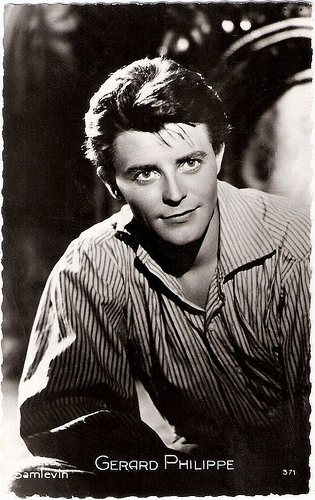
French Postcard by Editions P.I., Paris, no. 371. Photo: Sam Lévin.
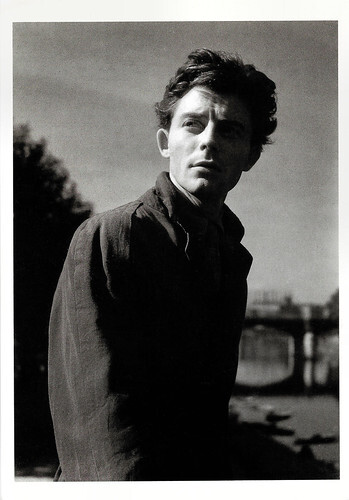
French postcard in the Collection Image Noire by Editions Hazan, no. 6030, 1988. Photo: Raymond Voinquel. Caption: Gérard Philipe, 1946.
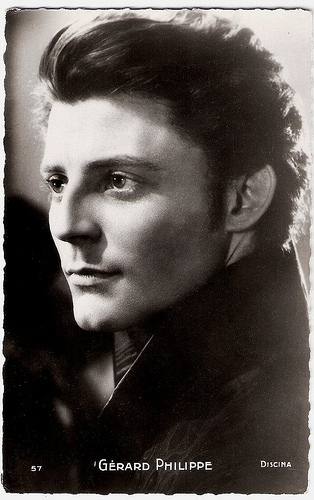
French postcard by Editions P.I., Paris, no. 57. Photo: Discina.
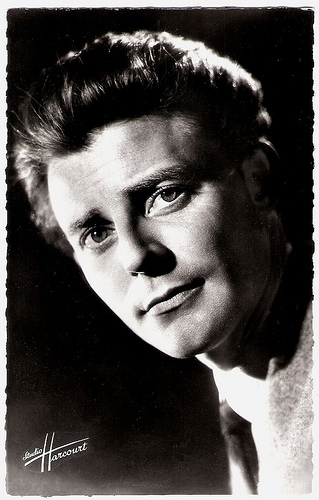
French postcard by Editions du Globe, Paris. Photo: Studio Harcourt.
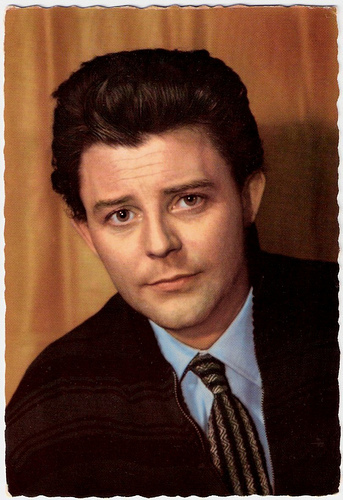
German postcard by Universum-Film Aktiengesellschaft (UFA), Berlin-Tempelhof, no. 1041. Photo: UFA.
Rave reviews
Gérard Philipe (sometimes written as Philippe) was born Gérard Philip in Cannes, France in 1922. In 1940, Gérard left school and his parents wanted him to become a lawyer. His mother noticed that he was only interested in acting, but his father was against the idea.
Gérard's father, a successful businessman, was a right-wing extremist and collaborated with the Nazis. After the war, he was forced to exile to Spain to escape a death sentence. Gérard himself was his whole life a staunch social liberal politically wise.
Actor Claude Dauphin introduced the young Philipe in 1942 to the stage. One of his first parts was as the angel in the play 'Sodome et Gomorrhe' by Jean Giraudoux in 1943. Director Marc Allégret decided that he showed some promise and gave him a small part in his film Les petites du quai aux fleurs/The Girls From the Quai aux Fleurs (Marc Allégret, 1944) starring Odette Joyeux .
With the support of his admirer Jean Cocteau, he entered the Paris Conservatory where under the tutelage of Georges Le Roy he discovered his passion for live theatre. In 1945 he received rave reviews for his performance in the stage production of Albert Camus’ 'Caligula'.
This success further opened the doors to the cinema. His first leading part in Le pays sans étoiles/Land Without Stars (Georges Lacombe, 1946) opposite Jany Holt got so many favourable reviews that he became a star.
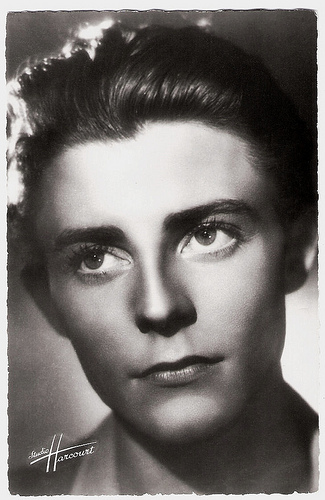
French postcard by Editions du Globe, no. 22. Photo: Studio Harcourt.
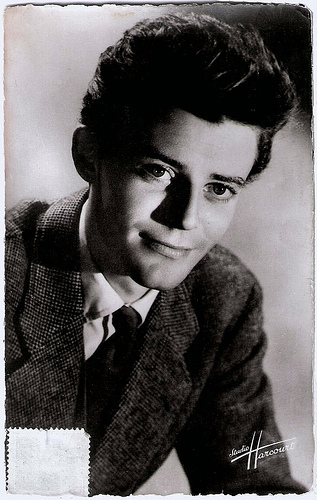
French postcard by Editions du Globe (E.D.U.G.), Paris, no. 31. Photo: Studio Harcourt.
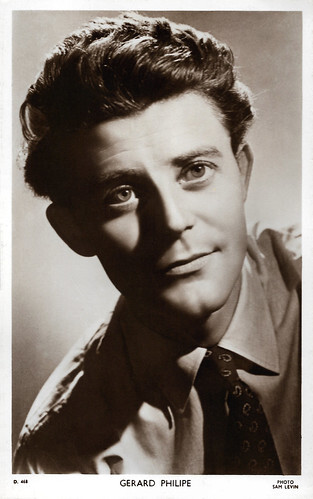
British postcard in the Picturegoer Series, London, no. D 468. Photo: Sam Lévin.
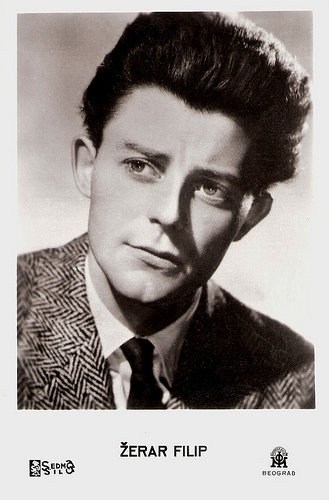
Serbian postcard by Sedm Sil.
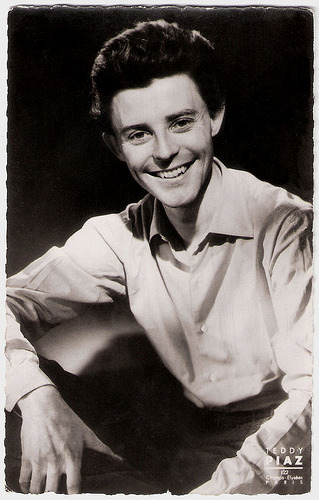
French postcard by Editions du Globe, no. 51. Photo: Teddy Piaz, Paris.
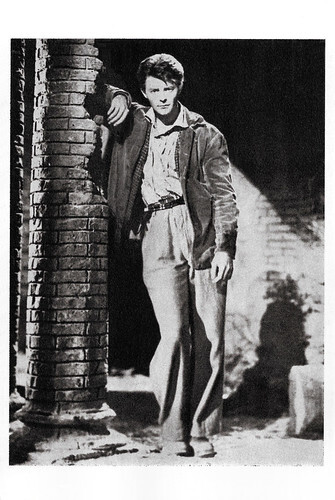
French postcard by Editions la Malibran, Saint Dié, no. CF 44.
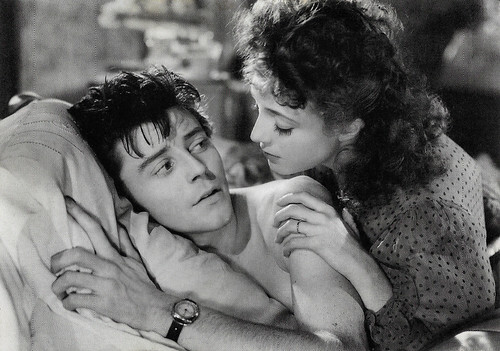
French postcard by Editions La Malibran, Paris, no. CF 23, 1990. Gérard Philipe and Micheline Presle in Le Diable au corps/Devil in the Flesh (Claude Autant-Lara, 1947).
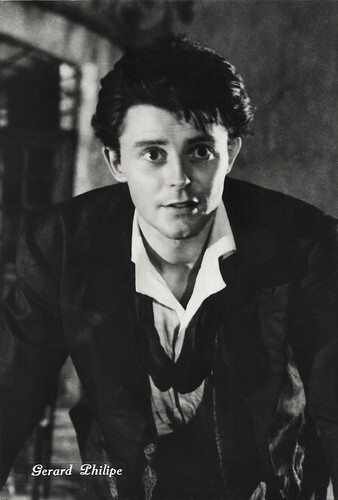
Italian postcard by Vetta Traldi, Milano, no. 70. Gérard Philipe in La chartreuse de Parme/The Charterhouse of Parma (Christian-Jaque, 1948).
Tongue-in-cheek titular swashbuckler
In 1947, Gérard Philipe exploded upon the European film scene in Le diable au corps/Devil in the Flesh (Claude Autant-Lara, 1947), playing Francois Jaubert, a callow youth in love with much older and very married Micheline Presle .
Superstardom followed almost immediately: female filmgoers doted upon Philippe's sensitive, handsome features and strapping physique, while men identified with his soulfulness and introspection. Next, he would take on prominent roles in such classic films as Une si jolie petite plage/Such a Pretty Little Beach (Yves Allégret, 1949), and La beauté du diable/Beauty and the Devil (René Clair, 1950) as Faust.
He was an international success as the tongue-in-cheek titular swashbuckler Fanfan la Tulipe/Fan-Fan the Tulip (Christian-Jaque, 1952), one of the most popular historical-adventure films made in France. At French Films , James Travers reviews: "Not only is the film impeccably made, with lavish production values, stunning cinematography and impressively choreographed fight scenes, but it has a timeless quality which will no doubt ensure it will remain a popular classic for years to come. Philipe excels in this film in what is regarded by many as his finest film role, the indefatigable womaniser and agile swordsman Fanfan la Tulipe. Philipe is simply brilliant in the role, tackling the numerous swordfights and Henri Jeanson’s sparkling dialogue with equal relish."
He appeared with such great stars of the European cinema as Italian beauty Gina Lollobrigida in Les belles de nuit/Beauties of the Night (René Clair, 1952), with Michèle Morgan in both Les orgueilleux/The Proud Ones (Yves Allégret, 1953) and Les grandes manœuvres/The Grand Maneuver (René Clair, 1955).
In 1956, Philipe starred in and directed a film adaptation of the old folk tale 'Till Eulenspiegel', Les aventures de Till L'Espiègle/Bold Adventure (Gérard Philipe, Joris Ivens, 1956). The French-East-German coproduction was not a success. He simultaneously pursued his stage career, with a keen involvement in the Théatre National de Paris, which would endure up until his death. Whilst working at the TNP, Philipe, a strong believer in egalitarianism, would draw exactly the same salary as junior actors. He would also become president of the French actors union, actively promoting the rights of actors.
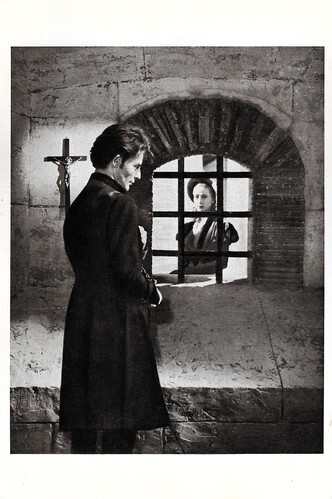
French postcard by Editions La Malibran, Paris, no. CF 24. Photo: N. Hayer. Gérard Philipe and Renée Faure in La chartreuse de Parme (Christian-Jaque, 1948).
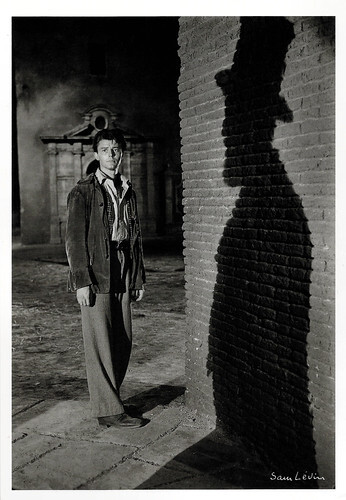
French postcard in the Collection Magie Noire by Editions Hazan, Paris, no. 6192, 1989. Photo: Sam Lévin. Gérard Philipe and the shadow of Michel Simon in La Beauté du diable (René Clair, 1950).
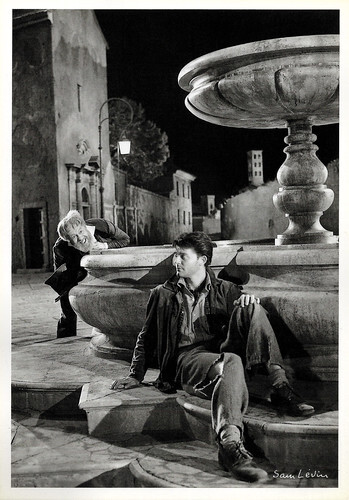
French postcard in the Collection Magie Noire by Editions Hazan, Paris, no. 6195, 1989. Photo: Sam Lévin. Gérard Philipe and Michel Simon in La Beauté du diable (René Clair, 1950).
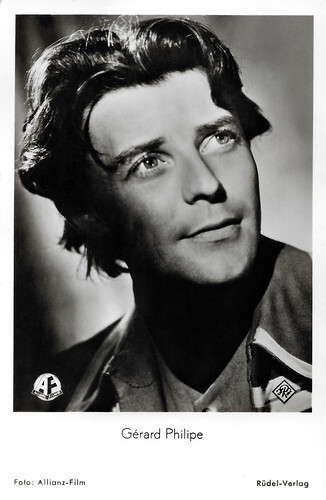
West German postcard by Rüdel Verlag, Hamburg-Bergedorf, no. 467. Photo: Allianz- Film. Gérard Philipe in Fanfan la Tulipe/Fan-Fan the Tulip (Christian-Jaque, 1952).
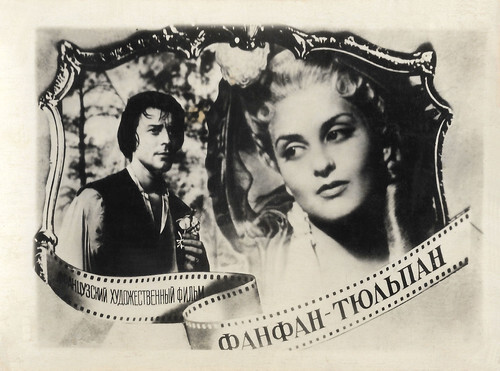
Russian collectors card. Photo: Gérard Philipe and Genevieve Page in Fanfan la Tulipe (Christian-Jaque, 1952).
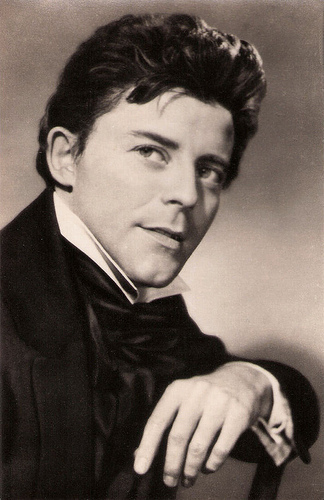
East-German postcard by VEB Progress Film-Vertrieb, Berlin, no. 73. Photo: Franco-London-Film S.A. Publicity still for Le rouge et le noir/The Red and the Black (Claude Autant-Lara, 1954).
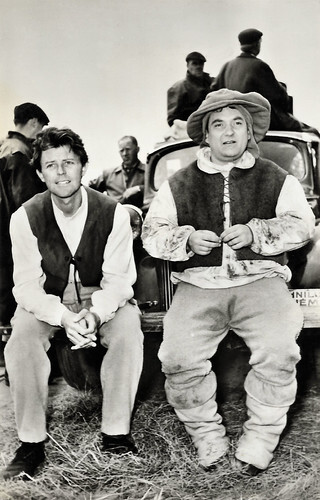
East German postcard by VEB Progress Film-Vertrieb, Berlin, no. 159, 1956. Photo: Gerhard Puhlmann. Gérard Philipe and Jean Carmet on the set of Les aventures de Till L'Espiègle/Bold Adventure (Gérard Philipe, Joris Ivens, 1956).
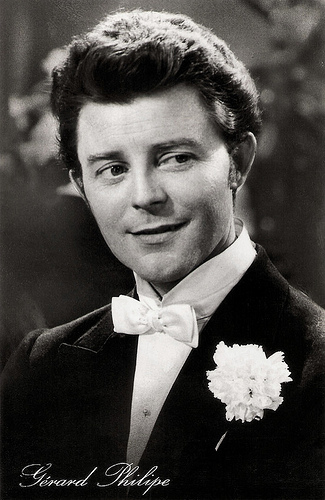
East-German postcard by VEB Progress Filmvertrieb, no. 1290, 1960. Photo: publicity still for Pot-Bouille/Lovers of Paris (Julien Duvivier, 1957).
Legendary status
Gérard Philipe continued his string of film successes throughout the 1950s. Among these films were the Fyodor Dostoevsky adaptation Le joueur/The Gambler (Claude Autant-Lara, 1958) with Liselotte Pulver , and Les liaisons dangereuses/Dangerous Liaisons (Roger Vadim, 1959) opposite Jeanne Moreau .
In 1959 doctors told Philippe that he had liver cancer. On 25 November that year, while working on Luis Buñuel's Le Fievre Monte a El Pao/Fever Mounts at El Pao (Luis Buñuel, 1959), he died at the peak of his popularity. He was just 36 years old.
The news provoked an immediate and intense outpouring of grief. His early death elevated him to a near-legendary status in France. Since 1951, Philipe was married to actress and writer Nicole Fourcade, with whom he had two children, writer and actor Anne-Marie Philipe (1954) and Olivier Philipe (1957).
Nicole adopted the pseudonym Anne Philipe, and wrote two books about her husband, 'Souvenirs' (1960) and 'Le Temps d'un soupir' (1963, No Longer Than a Sigh). In 1961, Gérard's portrait appeared on a French commemorative postage stamp. There is a film festival named in his honour as well as a number of theatres, schools and colleges in various parts of France. He was also very popular in Germany, and a Berlin theatre has been named after him.
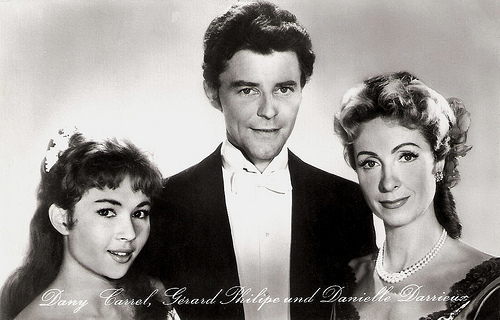
East-German postcard by VEB Progress Filmvertrieb, no. 1294, 1960. Photo: publicity still for Pot-Bouille/Lovers of Paris (Julien Duvivier, 1957) with Dany Carrel and Danielle Darrieux .
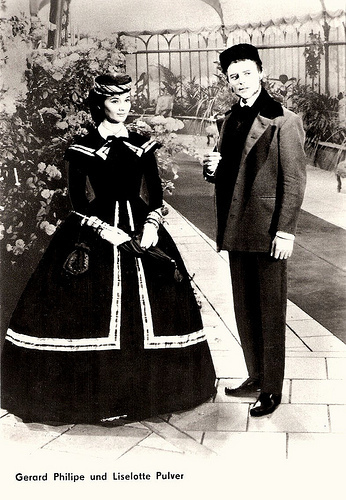
East-German postcard by VEB Progress Film-Vertrieb, no. 2699. Retail price: 0,20 MDN. Photo: publicity still for Le joueur/The Gambler (Claude Autant-Lara, 1958) with Liselotte Pulver .
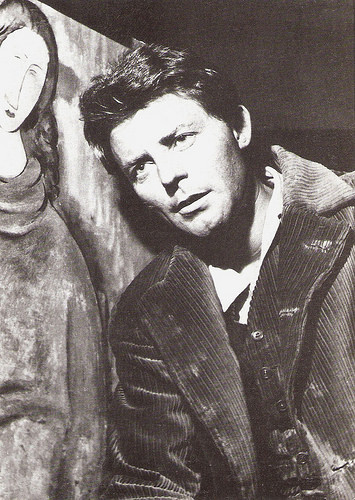
French postcard by Sofraneme, Levallois Perret no. CP 210. Photo: publicity still for Les amants de Montparnasse/The Lovers of Montparnasse (Jacques Becker, 1958) with Gérard Philipe as painter Amedeo Modigliani.
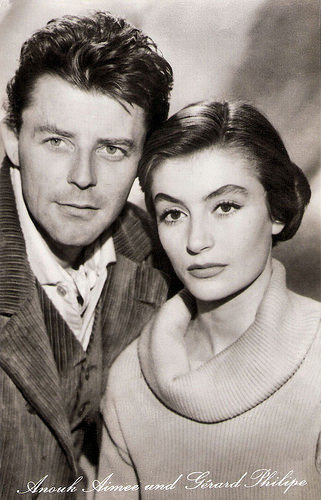
East-German postcard by VEB Progress Filmvertrieb, Berlin no. 1272, 1960. Photo: publicity still for Les amants de Montparnasse/The Lovers of Montparnasse (Jacques Becker, 1958) with Anouk Aimée .
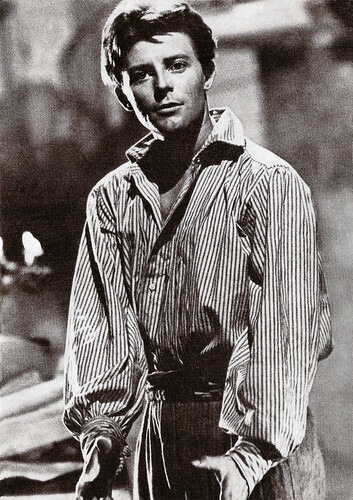
French postcard by Edition Delta-Productions, Saint Jean-De-Vedas, no CP-24.
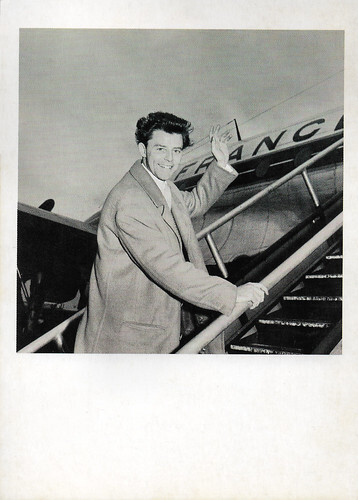
French postcard by Editions F. Nugeron, no. Star 139. Photo: Air France / Distribution VU. Caption: Gerard Philippe, 5 January 1958.
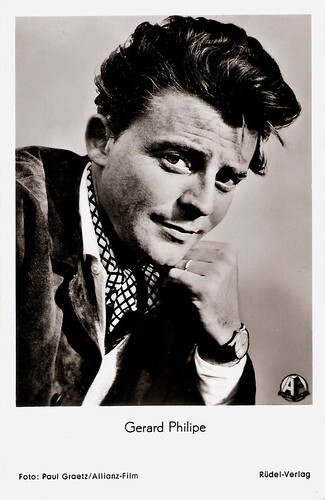
German postcard by Rúdel-Verlag, Hamburg-Bergedorf, no.953. Photo: Paul Goetz / Allianz-Film.
Trailer for La Beauté du diable/Beauty and the Devil (René Clair, 1950). Source: entertainmentone (YouTube).
Compilation of scenes from Les grandes manœuvres/The Grand Maneuver (1955). Source: Slava Batareykin (YouTube).
French trailer for Les amants de Montparnasse/The Lovers of Montparnasse (Jacques Becker, 1958). Source: Gaumont (YouTube).
Sources: James Travers (French Films), Hal Erickson (AllMovie), Wikipedia, and .

French Postcard by Editions P.I., Paris, no. 371. Photo: Sam Lévin.

French postcard in the Collection Image Noire by Editions Hazan, no. 6030, 1988. Photo: Raymond Voinquel. Caption: Gérard Philipe, 1946.

French postcard by Editions P.I., Paris, no. 57. Photo: Discina.

French postcard by Editions du Globe, Paris. Photo: Studio Harcourt.

German postcard by Universum-Film Aktiengesellschaft (UFA), Berlin-Tempelhof, no. 1041. Photo: UFA.
Rave reviews
Gérard Philipe (sometimes written as Philippe) was born Gérard Philip in Cannes, France in 1922. In 1940, Gérard left school and his parents wanted him to become a lawyer. His mother noticed that he was only interested in acting, but his father was against the idea.
Gérard's father, a successful businessman, was a right-wing extremist and collaborated with the Nazis. After the war, he was forced to exile to Spain to escape a death sentence. Gérard himself was his whole life a staunch social liberal politically wise.
Actor Claude Dauphin introduced the young Philipe in 1942 to the stage. One of his first parts was as the angel in the play 'Sodome et Gomorrhe' by Jean Giraudoux in 1943. Director Marc Allégret decided that he showed some promise and gave him a small part in his film Les petites du quai aux fleurs/The Girls From the Quai aux Fleurs (Marc Allégret, 1944) starring Odette Joyeux .
With the support of his admirer Jean Cocteau, he entered the Paris Conservatory where under the tutelage of Georges Le Roy he discovered his passion for live theatre. In 1945 he received rave reviews for his performance in the stage production of Albert Camus’ 'Caligula'.
This success further opened the doors to the cinema. His first leading part in Le pays sans étoiles/Land Without Stars (Georges Lacombe, 1946) opposite Jany Holt got so many favourable reviews that he became a star.

French postcard by Editions du Globe, no. 22. Photo: Studio Harcourt.

French postcard by Editions du Globe (E.D.U.G.), Paris, no. 31. Photo: Studio Harcourt.

British postcard in the Picturegoer Series, London, no. D 468. Photo: Sam Lévin.

Serbian postcard by Sedm Sil.

French postcard by Editions du Globe, no. 51. Photo: Teddy Piaz, Paris.

French postcard by Editions la Malibran, Saint Dié, no. CF 44.

French postcard by Editions La Malibran, Paris, no. CF 23, 1990. Gérard Philipe and Micheline Presle in Le Diable au corps/Devil in the Flesh (Claude Autant-Lara, 1947).

Italian postcard by Vetta Traldi, Milano, no. 70. Gérard Philipe in La chartreuse de Parme/The Charterhouse of Parma (Christian-Jaque, 1948).
Tongue-in-cheek titular swashbuckler
In 1947, Gérard Philipe exploded upon the European film scene in Le diable au corps/Devil in the Flesh (Claude Autant-Lara, 1947), playing Francois Jaubert, a callow youth in love with much older and very married Micheline Presle .
Superstardom followed almost immediately: female filmgoers doted upon Philippe's sensitive, handsome features and strapping physique, while men identified with his soulfulness and introspection. Next, he would take on prominent roles in such classic films as Une si jolie petite plage/Such a Pretty Little Beach (Yves Allégret, 1949), and La beauté du diable/Beauty and the Devil (René Clair, 1950) as Faust.
He was an international success as the tongue-in-cheek titular swashbuckler Fanfan la Tulipe/Fan-Fan the Tulip (Christian-Jaque, 1952), one of the most popular historical-adventure films made in France. At French Films , James Travers reviews: "Not only is the film impeccably made, with lavish production values, stunning cinematography and impressively choreographed fight scenes, but it has a timeless quality which will no doubt ensure it will remain a popular classic for years to come. Philipe excels in this film in what is regarded by many as his finest film role, the indefatigable womaniser and agile swordsman Fanfan la Tulipe. Philipe is simply brilliant in the role, tackling the numerous swordfights and Henri Jeanson’s sparkling dialogue with equal relish."
He appeared with such great stars of the European cinema as Italian beauty Gina Lollobrigida in Les belles de nuit/Beauties of the Night (René Clair, 1952), with Michèle Morgan in both Les orgueilleux/The Proud Ones (Yves Allégret, 1953) and Les grandes manœuvres/The Grand Maneuver (René Clair, 1955).
In 1956, Philipe starred in and directed a film adaptation of the old folk tale 'Till Eulenspiegel', Les aventures de Till L'Espiègle/Bold Adventure (Gérard Philipe, Joris Ivens, 1956). The French-East-German coproduction was not a success. He simultaneously pursued his stage career, with a keen involvement in the Théatre National de Paris, which would endure up until his death. Whilst working at the TNP, Philipe, a strong believer in egalitarianism, would draw exactly the same salary as junior actors. He would also become president of the French actors union, actively promoting the rights of actors.

French postcard by Editions La Malibran, Paris, no. CF 24. Photo: N. Hayer. Gérard Philipe and Renée Faure in La chartreuse de Parme (Christian-Jaque, 1948).

French postcard in the Collection Magie Noire by Editions Hazan, Paris, no. 6192, 1989. Photo: Sam Lévin. Gérard Philipe and the shadow of Michel Simon in La Beauté du diable (René Clair, 1950).

French postcard in the Collection Magie Noire by Editions Hazan, Paris, no. 6195, 1989. Photo: Sam Lévin. Gérard Philipe and Michel Simon in La Beauté du diable (René Clair, 1950).

West German postcard by Rüdel Verlag, Hamburg-Bergedorf, no. 467. Photo: Allianz- Film. Gérard Philipe in Fanfan la Tulipe/Fan-Fan the Tulip (Christian-Jaque, 1952).

Russian collectors card. Photo: Gérard Philipe and Genevieve Page in Fanfan la Tulipe (Christian-Jaque, 1952).

East-German postcard by VEB Progress Film-Vertrieb, Berlin, no. 73. Photo: Franco-London-Film S.A. Publicity still for Le rouge et le noir/The Red and the Black (Claude Autant-Lara, 1954).

East German postcard by VEB Progress Film-Vertrieb, Berlin, no. 159, 1956. Photo: Gerhard Puhlmann. Gérard Philipe and Jean Carmet on the set of Les aventures de Till L'Espiègle/Bold Adventure (Gérard Philipe, Joris Ivens, 1956).

East-German postcard by VEB Progress Filmvertrieb, no. 1290, 1960. Photo: publicity still for Pot-Bouille/Lovers of Paris (Julien Duvivier, 1957).
Legendary status
Gérard Philipe continued his string of film successes throughout the 1950s. Among these films were the Fyodor Dostoevsky adaptation Le joueur/The Gambler (Claude Autant-Lara, 1958) with Liselotte Pulver , and Les liaisons dangereuses/Dangerous Liaisons (Roger Vadim, 1959) opposite Jeanne Moreau .
In 1959 doctors told Philippe that he had liver cancer. On 25 November that year, while working on Luis Buñuel's Le Fievre Monte a El Pao/Fever Mounts at El Pao (Luis Buñuel, 1959), he died at the peak of his popularity. He was just 36 years old.
The news provoked an immediate and intense outpouring of grief. His early death elevated him to a near-legendary status in France. Since 1951, Philipe was married to actress and writer Nicole Fourcade, with whom he had two children, writer and actor Anne-Marie Philipe (1954) and Olivier Philipe (1957).
Nicole adopted the pseudonym Anne Philipe, and wrote two books about her husband, 'Souvenirs' (1960) and 'Le Temps d'un soupir' (1963, No Longer Than a Sigh). In 1961, Gérard's portrait appeared on a French commemorative postage stamp. There is a film festival named in his honour as well as a number of theatres, schools and colleges in various parts of France. He was also very popular in Germany, and a Berlin theatre has been named after him.

East-German postcard by VEB Progress Filmvertrieb, no. 1294, 1960. Photo: publicity still for Pot-Bouille/Lovers of Paris (Julien Duvivier, 1957) with Dany Carrel and Danielle Darrieux .

East-German postcard by VEB Progress Film-Vertrieb, no. 2699. Retail price: 0,20 MDN. Photo: publicity still for Le joueur/The Gambler (Claude Autant-Lara, 1958) with Liselotte Pulver .

French postcard by Sofraneme, Levallois Perret no. CP 210. Photo: publicity still for Les amants de Montparnasse/The Lovers of Montparnasse (Jacques Becker, 1958) with Gérard Philipe as painter Amedeo Modigliani.

East-German postcard by VEB Progress Filmvertrieb, Berlin no. 1272, 1960. Photo: publicity still for Les amants de Montparnasse/The Lovers of Montparnasse (Jacques Becker, 1958) with Anouk Aimée .

French postcard by Edition Delta-Productions, Saint Jean-De-Vedas, no CP-24.

French postcard by Editions F. Nugeron, no. Star 139. Photo: Air France / Distribution VU. Caption: Gerard Philippe, 5 January 1958.

German postcard by Rúdel-Verlag, Hamburg-Bergedorf, no.953. Photo: Paul Goetz / Allianz-Film.
Trailer for La Beauté du diable/Beauty and the Devil (René Clair, 1950). Source: entertainmentone (YouTube).
Compilation of scenes from Les grandes manœuvres/The Grand Maneuver (1955). Source: Slava Batareykin (YouTube).
French trailer for Les amants de Montparnasse/The Lovers of Montparnasse (Jacques Becker, 1958). Source: Gaumont (YouTube).
Sources: James Travers (French Films), Hal Erickson (AllMovie), Wikipedia, and .
Published on April 29, 2023 22:00
April 28, 2023
George Raft
American actor George Raft (1901-1980) was born and grew up in a poor family in Hell's Kitchen, at the time one of the roughest, meanest areas of New York City. With his dark good looks and sharp dressing, Raft tried his luck in Hollywood. His first big role was as the coin-tossing henchman in Scarface (1932). His career was marked by numerous tough-guy roles, often a gangster or convict. The believability with which he played these, together with his lifelong associations with real-life gangsters like Bugsy Siegel, added to persistent rumours that he was also a gangster. The slightly shady reputation helped his popularity early on, but it made him undesirable to movie executives later in his career. He somewhat parodied his gangster reputation in Billy Wilder's Some Like It Hot (1959).
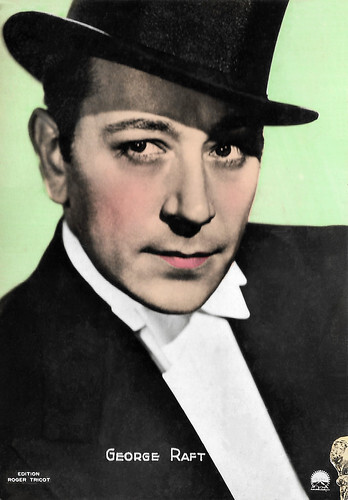
French collectors card by Edition Roger Tricot. Photo: Paramount.
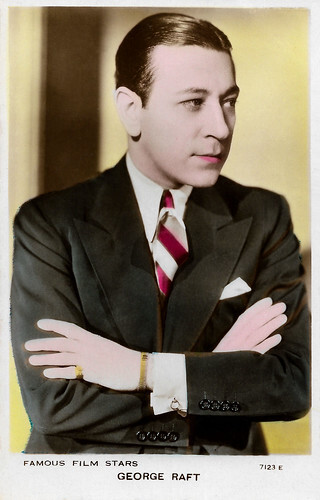
British postcard by Art Photo in the Famous Film Stars series, no. 7123 E. Caption: George Raft - Born 27th September, 1903, in New York City. Black hair, brown eyes. Height 5ft, 10 Ins. In his teens was professional fly-weight boxer. Later took up professional dancing. Has stage experience before coming to the screen. Films include: 'The Trumpet Blows', 'Limehouse Blues', 'Rumba', 'Every Night at Eight' and 'The Woman Tamer'.
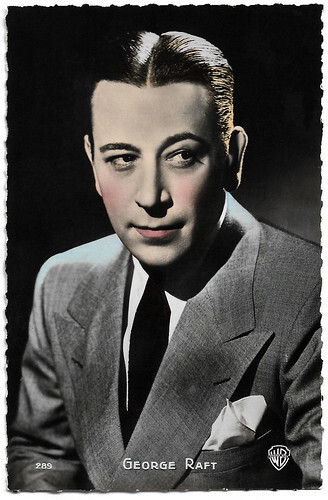
French postcard by Editions P.I., Paris, no. 289, presented by Les Carbones de France, Paris. Photo: Warner Bros.
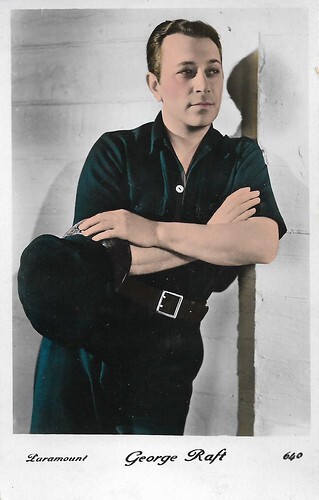
French postcard, no. 460. Photo: Paramount. George Raft in Spawn of the North (Henry Hathaway, 1938).

British postcard by Art Photo, no. 173. Sylvia Sidney and George Raft in You and Me (Fritz Lang, 1938).
Hell's Kitchen
George Raft was born George Ranft in New York in 1901. He was the eldest of ten children of German immigrant Conrad Ranft and his wife Eva Glockner. His parents worked as dancers in New York nightclubs. George Raft spoke fluent German, which he had learned from his parents.
George grew up in poor circumstances in Hell's Kitchen, at the time one of the roughest, meanest areas of New York City. In his childhood, he befriended the later mobsters Bugsy Siegel and Owney Madden, who grew up in the same neighbourhoods as he did. The friendship between Siegel and Raft lasted a lifetime, with Raft making Siegel acquaintances in Hollywood and using his popularity to support him in courtroom prosecutions.
Raft ran away from home at the age of 13. In his younger years, he tried his hand as a boxer, taxi driver and nightclub dancer. His success as a dancer in New York nightclubs led him to Broadway, where he also worked as a dancer. Fred Astaire , in his autobiography 'Steps in Time' (1959), said Raft was "the neatest, fastest Charleston dancer ever. He practically floored me with his footwork."
George Raft married Grayce Mulrooney in 1923 but soon after they would divorce. Grayce, a devout Catholic, refused Raft a divorce, however, and he remained married to her until her death in 1970.
Raft later had several relationships with Betty Grable and Mae West . He appeared with Mae West in both her first film, Night After Night (Archie Mayo, 1932) and her last film, Sextette (Ken Hughes, 1977). He openly declared that he wanted to marry Norma Shearer , but his wife's refusal to divorce meant that his wedding plans came to nothing.
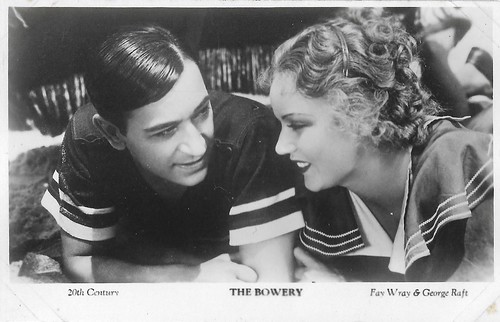
British postcard in the Film Shots series by Film Weekly. Photo: 20th Century. Fay Wray and George Raft on the beach in the pre-Code movie The Bowery (Raoul Walsh, 1933), distributed by United Artists.

British postcard in the Film Shots series by Film Weekly. Photo: Paramount. Sylvia Sidney and George Raft in Pick-up (Marion Gering, 1933).
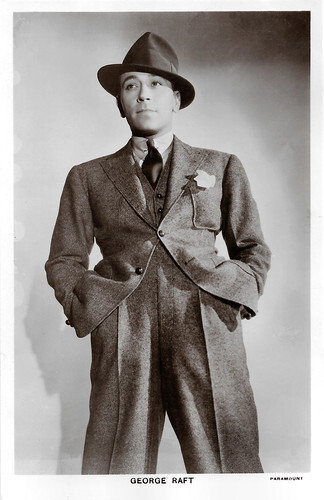
British postcard in the Picturegoer Series, London, no. 1018. Photo: Paramount.
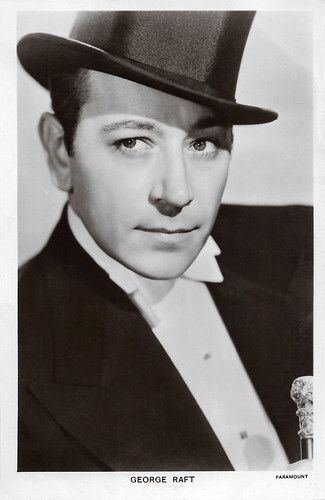
British postcard in the Picturegoer Series, London, no. 1018a. Photo: Paramount.
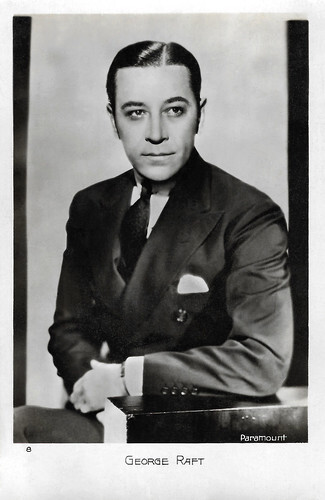
French postcard by E.C. (Edition Chantal), no. 8. Photo: Paramount.
An ideal gangster on the silver screen
George Raft moved to Hollywood in 1929 and first played small roles there. His success came in Scarface (Howard Hawks, 1932). He played Guino Rinaldo, the aspiring gangster partner of Paul Muni , who is ultimately killed by him because of an affair with his sister. Raft's charisma made him an ideal gangster on the silver screen.
Raft solidified his reputation as a movie star in the 1930s with crime and gangster films such as The Glass Key (Frank Tuttle, 1935). In 1938 he played the male lead in You and I, directed by Fritz Lang . He was one of the most popular actors in gangster roles of the 1930s, with James Cagney and Edward G. Robinson .
Raft and Cagney worked as convicts in a prison in Each Dawn I Die (William Keighley, 1939). From 1945 his popularity waned and from then on he was mostly seen as the lead in B-movies in Film Noir style. He also took leading roles in European films. In the 1950s, Raft, along with Kosher-Nostra head Meyer Lansky and mob boss Santo Trafficante, opened the Capri Casino in Havana, which was initially financially successful. However, he lost it in 1959 to the revolution in Cuba.
In 1965, Raft was accused of tax evasion because of his financial problems. However, he got off with a suspended sentence as he pleaded guilty. In 1967, Britain banned him from entering the country because of his Mafia contacts. One of his best-known later film appearances was in the comedy classic Some Like It Hot (Billy Wilder, 1959), where he played the gangster boss "Spats Colombo" in a parody of his usual roles. Some Like It Hot became one of Raft's last major film appearances.
In the 1960s and 1970s, the veteran star mostly had to settle for cameo appearances. Raft's last film Sam Marlow, Private Detective (Robert Day, 1980) was released in the last year of his life and was a tribute to his former co-star Humphrey Bogart . George Raft died of leukaemia in Los Angeles in November 1980 at the age of 79. He was buried in Forest Lawn Memorial Park.
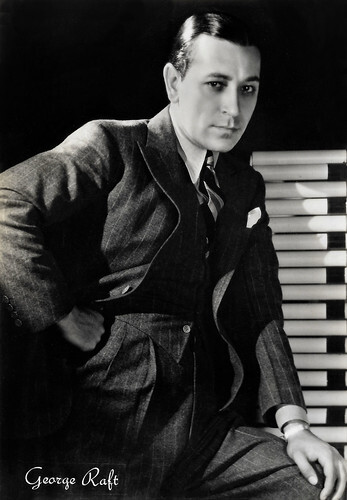
Italian postcard by Rotalfoto, Milano, no. 34.
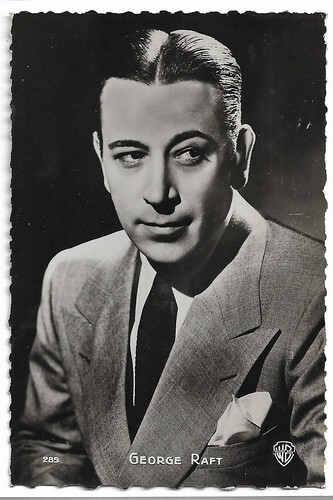
French postcard by Editions P.I., Paris, no. 289. Photo: Warner Bros.
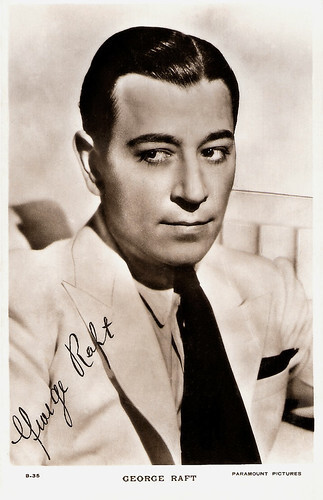
British Real Photograph postcard, no. B.35. Photo: Paramount Pictures.
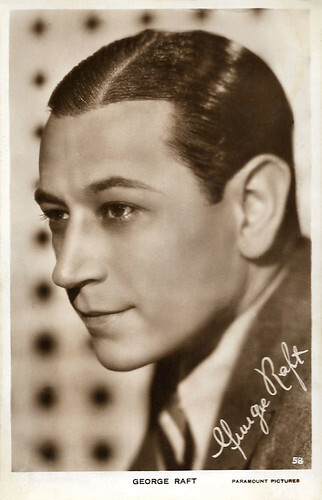
British postcard, no. 58. Photo: Paramount Pictures.
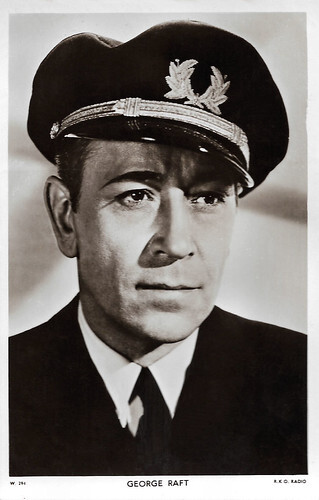
British postcard in the Picturegoer Series, London, no. W 294. Photo: R.K.O. Radio. George Raft in Johnny Angel (Edwin L. Marin, 1945).
Sources: (IMDb), Wikipedia (Dutch and English) and .

French collectors card by Edition Roger Tricot. Photo: Paramount.

British postcard by Art Photo in the Famous Film Stars series, no. 7123 E. Caption: George Raft - Born 27th September, 1903, in New York City. Black hair, brown eyes. Height 5ft, 10 Ins. In his teens was professional fly-weight boxer. Later took up professional dancing. Has stage experience before coming to the screen. Films include: 'The Trumpet Blows', 'Limehouse Blues', 'Rumba', 'Every Night at Eight' and 'The Woman Tamer'.

French postcard by Editions P.I., Paris, no. 289, presented by Les Carbones de France, Paris. Photo: Warner Bros.

French postcard, no. 460. Photo: Paramount. George Raft in Spawn of the North (Henry Hathaway, 1938).

British postcard by Art Photo, no. 173. Sylvia Sidney and George Raft in You and Me (Fritz Lang, 1938).
Hell's Kitchen
George Raft was born George Ranft in New York in 1901. He was the eldest of ten children of German immigrant Conrad Ranft and his wife Eva Glockner. His parents worked as dancers in New York nightclubs. George Raft spoke fluent German, which he had learned from his parents.
George grew up in poor circumstances in Hell's Kitchen, at the time one of the roughest, meanest areas of New York City. In his childhood, he befriended the later mobsters Bugsy Siegel and Owney Madden, who grew up in the same neighbourhoods as he did. The friendship between Siegel and Raft lasted a lifetime, with Raft making Siegel acquaintances in Hollywood and using his popularity to support him in courtroom prosecutions.
Raft ran away from home at the age of 13. In his younger years, he tried his hand as a boxer, taxi driver and nightclub dancer. His success as a dancer in New York nightclubs led him to Broadway, where he also worked as a dancer. Fred Astaire , in his autobiography 'Steps in Time' (1959), said Raft was "the neatest, fastest Charleston dancer ever. He practically floored me with his footwork."
George Raft married Grayce Mulrooney in 1923 but soon after they would divorce. Grayce, a devout Catholic, refused Raft a divorce, however, and he remained married to her until her death in 1970.
Raft later had several relationships with Betty Grable and Mae West . He appeared with Mae West in both her first film, Night After Night (Archie Mayo, 1932) and her last film, Sextette (Ken Hughes, 1977). He openly declared that he wanted to marry Norma Shearer , but his wife's refusal to divorce meant that his wedding plans came to nothing.

British postcard in the Film Shots series by Film Weekly. Photo: 20th Century. Fay Wray and George Raft on the beach in the pre-Code movie The Bowery (Raoul Walsh, 1933), distributed by United Artists.

British postcard in the Film Shots series by Film Weekly. Photo: Paramount. Sylvia Sidney and George Raft in Pick-up (Marion Gering, 1933).

British postcard in the Picturegoer Series, London, no. 1018. Photo: Paramount.

British postcard in the Picturegoer Series, London, no. 1018a. Photo: Paramount.

French postcard by E.C. (Edition Chantal), no. 8. Photo: Paramount.
An ideal gangster on the silver screen
George Raft moved to Hollywood in 1929 and first played small roles there. His success came in Scarface (Howard Hawks, 1932). He played Guino Rinaldo, the aspiring gangster partner of Paul Muni , who is ultimately killed by him because of an affair with his sister. Raft's charisma made him an ideal gangster on the silver screen.
Raft solidified his reputation as a movie star in the 1930s with crime and gangster films such as The Glass Key (Frank Tuttle, 1935). In 1938 he played the male lead in You and I, directed by Fritz Lang . He was one of the most popular actors in gangster roles of the 1930s, with James Cagney and Edward G. Robinson .
Raft and Cagney worked as convicts in a prison in Each Dawn I Die (William Keighley, 1939). From 1945 his popularity waned and from then on he was mostly seen as the lead in B-movies in Film Noir style. He also took leading roles in European films. In the 1950s, Raft, along with Kosher-Nostra head Meyer Lansky and mob boss Santo Trafficante, opened the Capri Casino in Havana, which was initially financially successful. However, he lost it in 1959 to the revolution in Cuba.
In 1965, Raft was accused of tax evasion because of his financial problems. However, he got off with a suspended sentence as he pleaded guilty. In 1967, Britain banned him from entering the country because of his Mafia contacts. One of his best-known later film appearances was in the comedy classic Some Like It Hot (Billy Wilder, 1959), where he played the gangster boss "Spats Colombo" in a parody of his usual roles. Some Like It Hot became one of Raft's last major film appearances.
In the 1960s and 1970s, the veteran star mostly had to settle for cameo appearances. Raft's last film Sam Marlow, Private Detective (Robert Day, 1980) was released in the last year of his life and was a tribute to his former co-star Humphrey Bogart . George Raft died of leukaemia in Los Angeles in November 1980 at the age of 79. He was buried in Forest Lawn Memorial Park.

Italian postcard by Rotalfoto, Milano, no. 34.

French postcard by Editions P.I., Paris, no. 289. Photo: Warner Bros.

British Real Photograph postcard, no. B.35. Photo: Paramount Pictures.

British postcard, no. 58. Photo: Paramount Pictures.

British postcard in the Picturegoer Series, London, no. W 294. Photo: R.K.O. Radio. George Raft in Johnny Angel (Edwin L. Marin, 1945).
Sources: (IMDb), Wikipedia (Dutch and English) and .
Published on April 28, 2023 22:00
April 27, 2023
La Collectionneuse: Loretta Young
Loretta Young was probably one of the loveliest female stars from the golden age of Hollywood, with her beautiful eyes, high cheekbones, full lips and radiant smile. She was also regarded as one of the most elegant actresses of her time. Gwen Wakeling, head costume designer at Fox from 1933 to 1942, said of her: "She could manage any article of clothing, no matter the weight, the size or the swing as if she were born in it. Nothing caused problems for that girl. She knew how to handle clothes exactly. She was exceptional. She knew she was a clotheshorse and she collaborated with the designers." Loretta Young had a long career at the top. She began to get leading roles at the end of the 1920s and was still given starring parts at the beginning of the 1950s. Afterwards, she was able to extend her success for several years by wisely turning to television.
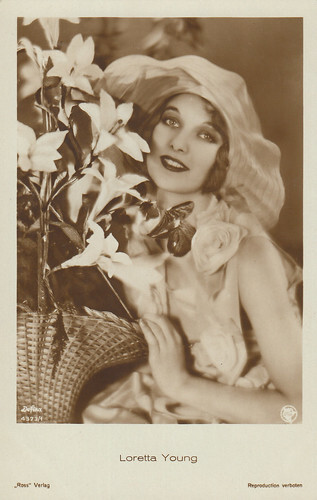
German postcard by Ross Verlag, no. 4373/1, 1929-1930. Photo: Defina / First National.
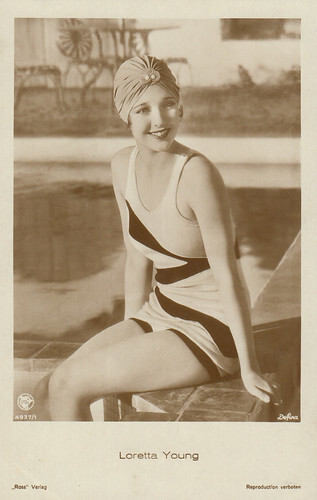
German postcard by Ross Verlag, no. 4937/1, 1929-1930. Photo: Defina / First National.
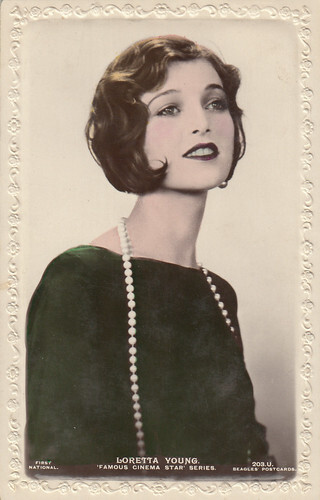
British postcard in the Famous Cinema Stars Series by Beagles, no. 203.U. Photo: First National.
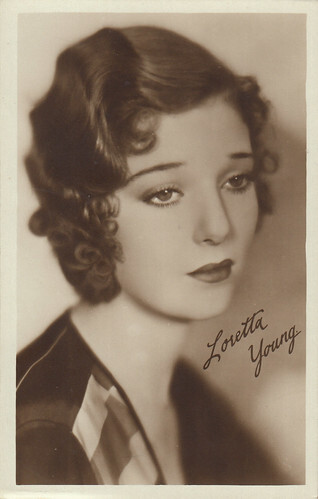
British postcard issued with Sarony cigarettes, no. 38 of a third series of 50 Cinema Stars.
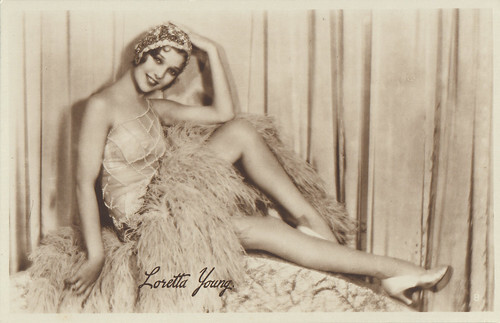
British postcard issued with Sarony cigarettes, no. 8 of a fifth series of 25 Cinema Stars.
A Hollywood child
Loretta Young was born Gretchen Young on the 6th of January 1913 in Salt Lake City, U.S.A.
She had two elder sisters who, as Polly Ann Young and Sally Blane, would also later become film actresses. In 1916, her father left the family and her mother relocated to Hollywood.
Soon, Gretchen began to appear as an extra in several movies. She played for example a fairy in The Primrose Ring (1917), a Mae Murray vehicle, or an Arab child in The Sheikh (1921).
Mae Murray was so taken with the young child that, knowing the Young family was struggling, she offered to take her into her home in 1918. Gretchen spent an enchanted time in Murray’s house. She was dressed in the finest clothes, was given dance lessons by famous choreographer Ernest Belcher and was spoiled by the actress. In March 1919, Mae Murray left California for New York and offered to take Gretchen with her but Mrs Young nixed the idea.
In 1954, Mae Murray , who had fallen into poverty, got in touch with Loretta Young and asked her for $5000, claiming it was to help friends in need. After she had received the money, Mae, who had stayed vague about where she then lived and how she could be reached, vanished from sight and never contacted Loretta again.
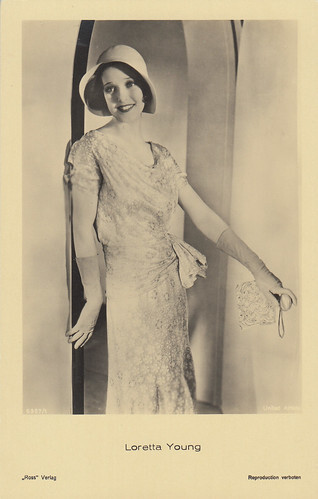
German postcard by Ross Verlag, no. 6957/1, 1931-1932. Photo: United Artists.
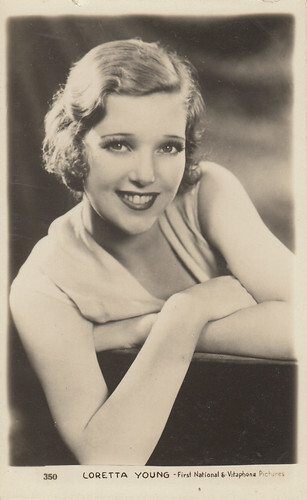
Argentinian postcard by F. Riudavets, Buenos Aires, no. 350. Photo: First National & Vitaphone Pictures.
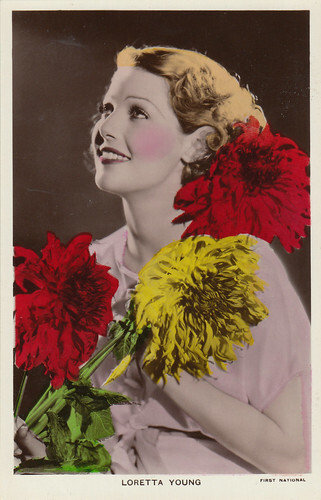
British postcard in the Colourgraph Series, London, no. C80a. Photo: First National.
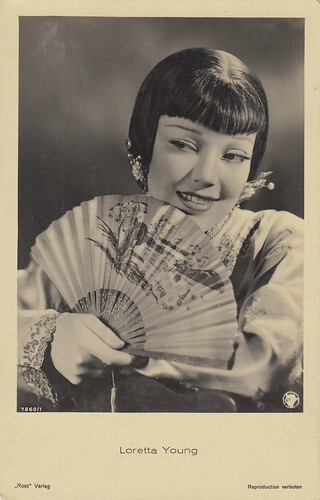
German postcard by Ross Verlag, no. 7960/1, 1932-1933. Photo: First National. Loretta Young as the Chinese character Sun Toya San in The Hatchet Man (William A. Wellman, 1932).
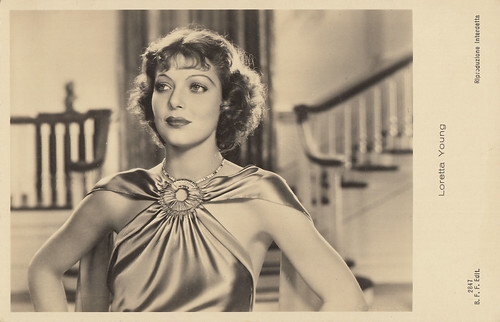
Italian postcard by Ballerini & Fratini, Firenze (BFF Edit.), no. 2847.
A quick climb to the top
After several years in school, Gretchen came back to the screen in a bit role in Naughty But Nice (1927). The star of the movie, Colleen Moore , was so impressed by the teenage girl that she urged First National to put her under contract, which they did. As her first name 'Gretchen' was thought of as sounding too harsh, she was rechristened 'Loretta'.
She got her first important role in Laugh, Clown, Laugh (1928), alongside Lon Chaney , and made her talking debut in The Squall (1929). First National very soon realized her potential and her career quickly took off.
The young rising star was submitted to a hectic filming schedule and was featured in movies such as The Girl in the Glass Cage (1929), The Fast Life (1929), The Careless Age (1929), Loose Ankles (1930), Road to Paradise (1930), Kismet (1930), The Devil to Pay (1930), Three Girls Lost (1931), Big Business Girl (1931), The Ruling Voice (1931), Taxi (1932), Play Girl (1932), Life Begins (1932), Zoo in Budapest (1933), Midnight Mary (1933), She Had to Say Yes (1933), Man’s Castle (1933), …
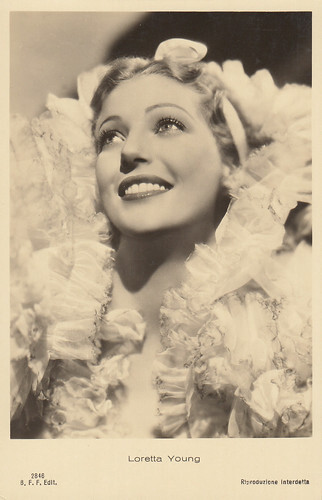
Italian postcard by Ballerini & Fratini, Firenze (BFF Edit.), no. 2848.
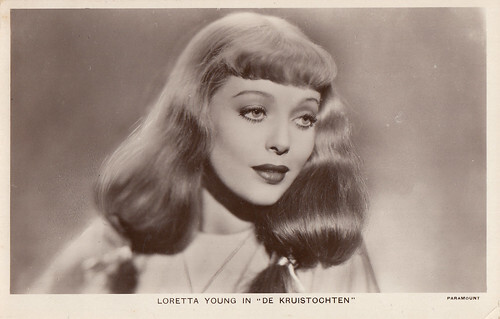
Dutch postcard by Bonnist & Zonen, Amsterdam, no. B425. Photo: Paramount. Loretta Young in The Crusades (Cecil B. DeMille, 1935).
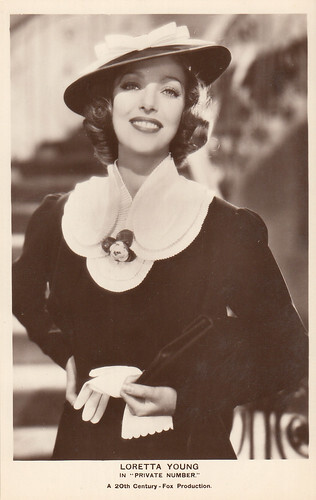
British postcard in the Picturegoer Series, no. FS26. Photo: 20th Century - Fox. Loretta Young in Private Number (Roy Del Ruth, 1936).
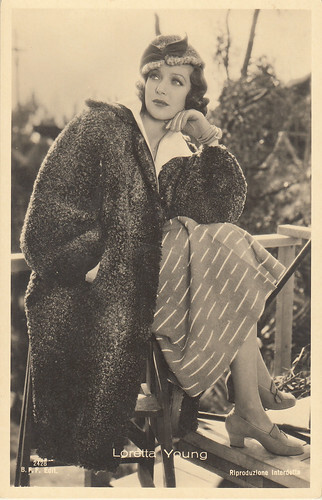
Italian postcard by Ballerini & Fratini, Firenze (B.F.F. Edit.), no. 2428.
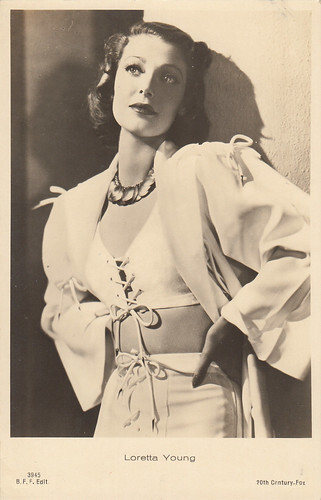
Italian postcard by Ballerini & Fratini, Firenze (B.F.F. Edit.), no. 3945.
A new contract
In June 1933, she signed with Darryl Zanuck, who kept her very busy with an average number of four or five films a year. These include Born to Be Bad (1934), The White Parade (1934), Call of the Wild (1935), The Crusades (1935), Private Number (1936), Ramona (1936), Love Under Fire (1937), Three Blind Mice (1938), Kentucky (1938), …
She also formed a handsome movie couple with Tyrone Power in Ladies In Love (1936), Love Is News (1937), Cafe Metropole (1937), Second Honeymoon (1937) and Suez (1938).
Dissatisfied by the way she was being handled, she quit 20th Century Fox at the end of the 1930s.
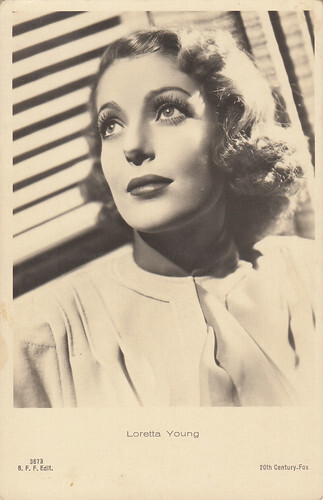
Italian postcard by Ballerini & Fratini, Firenze (B.F.F. Edit.), no. 3673.
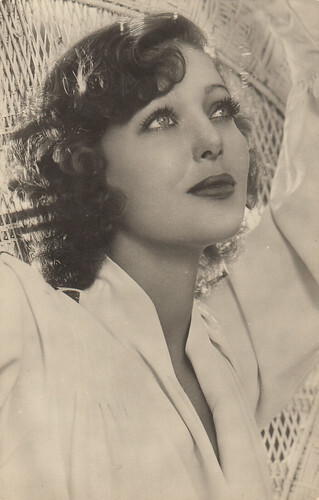
Spanish postcard no. 1087.
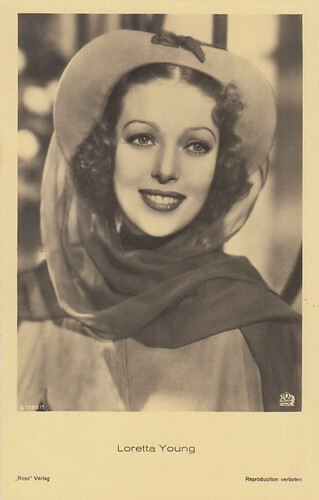
German postcard by Ross Verlag, no. A 1160/1, 1937-1938. Photo: 20th Century Fox.
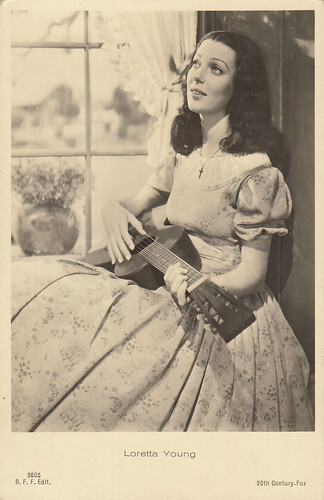
Italian postcard by Ballerini & Fratini, Firenze (B.F.F. Edit.), no. 3605. Photo: 20th Century Fox. Loretta Young in Ramona (Henry King, 1936).
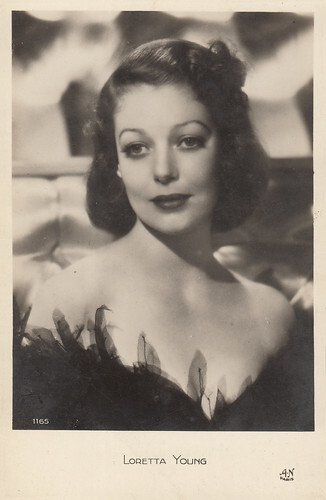
French postcard by A.N., Paris, no. 1165.
An unexpected Oscar in the 1940s
She was still in demand in the 1940s and notably starred in The Doctor Takes a Wife (1940), The Men in Her Life (1941), Bedtime Story (1942), A Night to Remember (1942), China (1943), And Now Tomorrow (1944), Along Came Jones (1945), The Stranger (1946), The Bishop’s Wife (1947), Rachel and the Stranger (1948), The Accused (1949), Come to the Stable (1949), …
During her film career, Loretta Young has never been ranked as one of the most outstanding actresses of her time and she often won more praise for her stylish beauty. She nevertheless won an unexpected Best Actress Oscar for The Farmer’s Daughter (1947), against the tough competition of Joan Crawford , Susan Hayward , Dorothy McGuire and Rosalind Russell .
She began the 1950s by co-starring with Clark Gable in Key to the City (1950) and by giving a good performance in the thriller Cause for Alarm (1951).
After the family-oriented comedy It Happens Every Thursday (1953), she wisely turned to television.
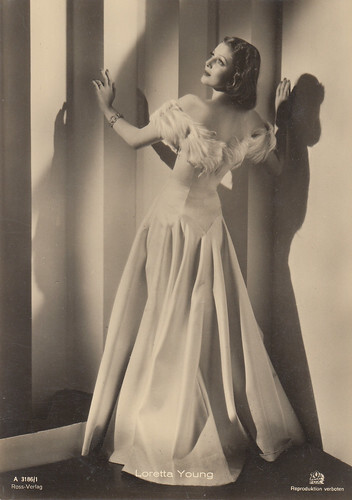
German postcard by Ross Verlag, no. A 3186/1, 1941-1944. Photo: 20th Century Fox.
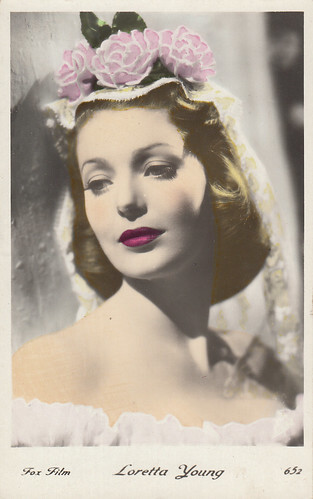
French postcard by Erpé, no. 652. Photo: Fox Film.
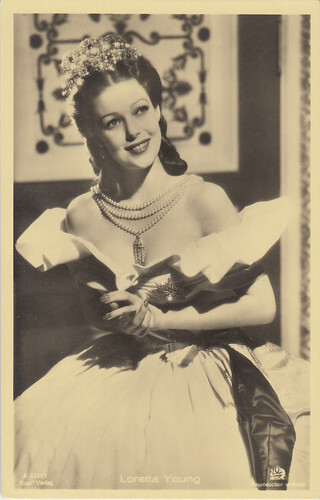
German postcard by Ross Verlag, no. A 2337/1, 1939-1940. Photo: 20th Century Fox. Loretta Young in Suez (Allan Dwan, 1938).
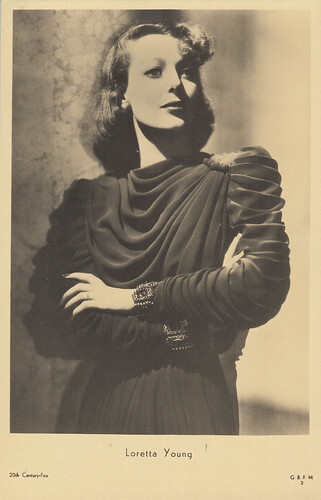
Italian postcard by G.B. Falci Editore, Milano, no. 2. Photo: 20th Century Fox.
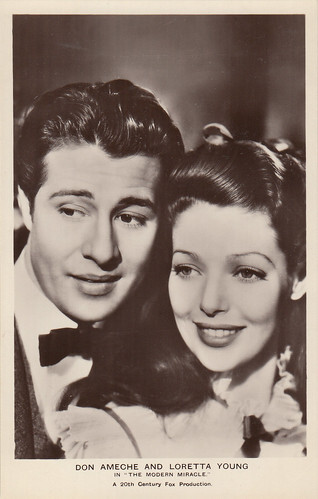
British postcard by Picturegoer, no. FS194. Photo: 20th Century Fox. Loretta Young and Don Ameche in The Story of Alexander Graham Bell (Irving Cummings, 1939).
Loretta on TV
From September 1953 to June 1961, she hosted the very popular Loretta Young Show, which earned her three Emmy Awards in 1955, 1957 and 1959.
Each week’s episode began with a beautifully gowned Loretta making a spectacular entrance through a door and uttering a few introductory remarks about the topic of the day.
This glamourous opening segment was followed by a 27-minute comedy or drama. During the run of the series, she acted in about 65 % of these. For the remainder, roles were taken by other performers such as Laraine Day, Mercedes McCambridge, Teresa Wright, Merle Oberon , Dorothy Malone, Viveca Lindfors , Virginia Mayo , etc. Over the years, The Loretta Young Show also gave exposure to newcomers such as Sue Lyon, Dennis Hopper , Elizabeth Montgomery and Mike Connors.
From September 1962 to March 1963, she played a widow in The New Loretta Young Show, which was a flop. Afterwards, she mostly devoted herself to charities.
She came back to acting in two TV movies, Christmas Eve (1986), for which she was awarded a Golden Globe for Best Performance, and Lady in the Corner (1989). Loretta Young passed away on the 12th of August 2000.
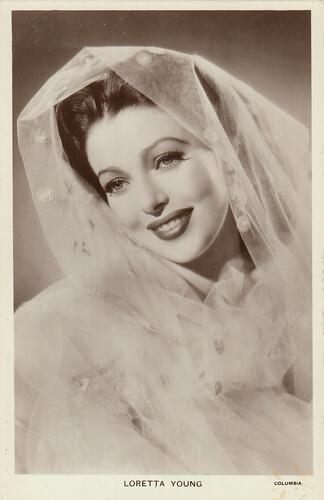
British postcard by Picturegoer, no. W14. Photo: Columbia.
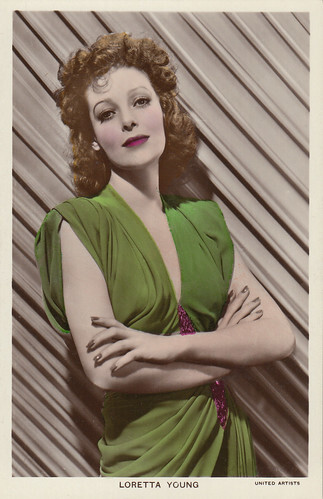
British postcard in the Colourgraph Series, no. C336. Photo: United Artists.
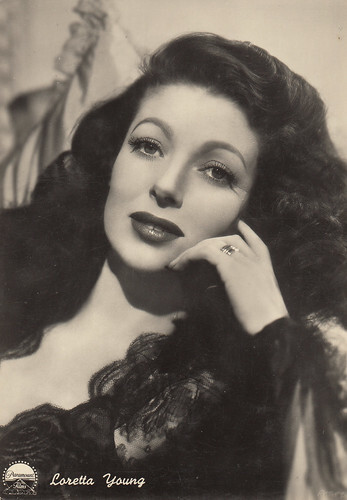
Italian postcard by Bromofoto, Milano, no. 291. Photo: Paramount Films.
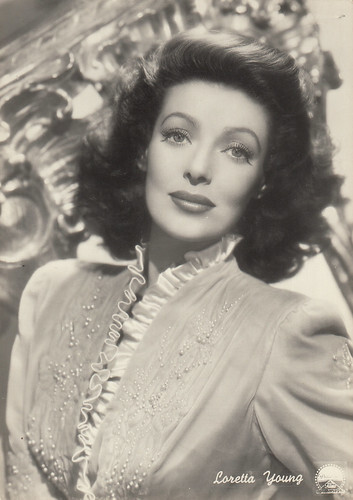
Italian postcard by Bromofoto, Milano, no. 345. Photo: Paramount.
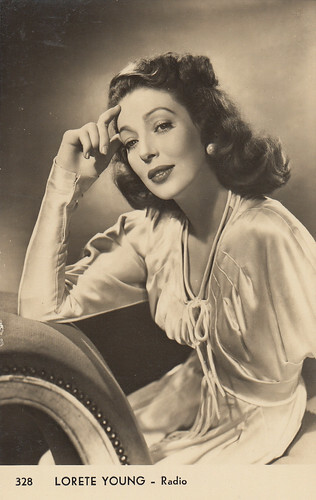
Spanish postcard no. 328. Photo: Radio.
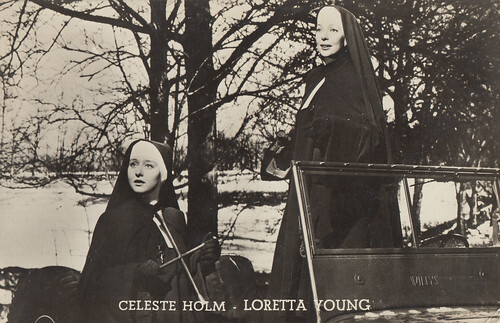
Vintage postcard. Loretta Young and Celeste Holm in Come to the Stable (Henry Koster, 1949).
Her private life
In January 1930, she eloped with actor Grant Withers and they married in Yuma. In less than a year, they separated and, in September 1931, she was granted a divorce.
During the filming of Man’s Castle (1933), she and her co-star Spencer Tracy fell in love. But he had a wife and, although they lived separately for many years, he stayed married to her until his death. After Loretta had realised that Tracy would not divorce and that their affair was leading nowhere, they separated.
In June 1937, she announced that she had adopted a baby girl, Judy, from a Catholic orphanage. In fact, she was the child’s biological mother and the father was her co-star in Call of the Wild (1935), Clark Gable , who was married at the time. A devout Catholic, she strongly objected to abortion. So, she secretly had given birth to Judy in November 1935, after having carefully hidden her pregnancy from the press. The baby was then placed in an orphanage until her so-called 'adoption'.
Young tried hard to keep the truth from her daughter. It was only at the end of the 1950s, when she was an adult, that Judy, to her shock, learned that she was her mother’s natural child and that her father was Gable. She nevertheless waited until the mid-1960s to confront Loretta, who confessed that she had lied to her daughter until then.
However, during her lifetime, the actress never publicly acknowledged the truth, even when, much to her chagrin, Judy published a book about her parentage in 1994. She took care that her authorised biography, in which she finally admitted the facts, was only published after her death.
In 1940, she married radio advertising executive Thomas H. A. Lewis. They had two sons, in 1944 and 1945, and they divorced in 1969. She remarried famous clothes designer Jean Louis in 1993 and was widowed in 1997.
According to Young’s daughter-in-law, Linda Lewis, Loretta had learned of the concept of date rape by watching a TV program in 1998 and allegedly told her that this applied to what happened between Gable and herself. Linda Lewis waited until Loretta and Judy had passed away to disclose her revelations in 2015.
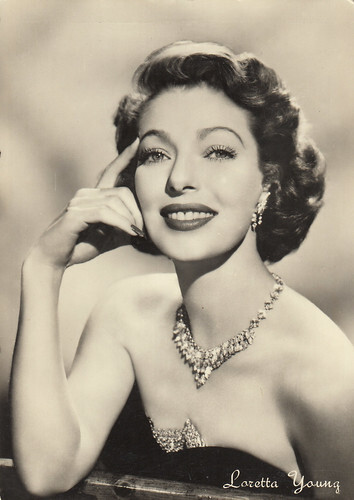
Italian postcard by Rotalfoto, Milano, no. 337.
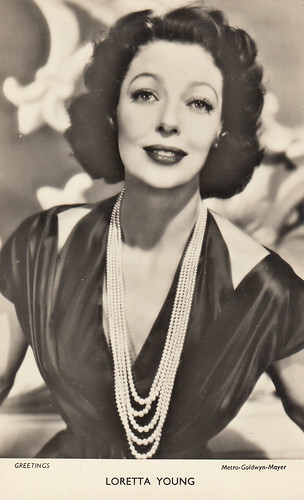
British postcard in the Greetings Series. Photo: Metro-Goldwyn-Mayer.
Text and postcards: Marlene Pilaete.

German postcard by Ross Verlag, no. 4373/1, 1929-1930. Photo: Defina / First National.

German postcard by Ross Verlag, no. 4937/1, 1929-1930. Photo: Defina / First National.

British postcard in the Famous Cinema Stars Series by Beagles, no. 203.U. Photo: First National.

British postcard issued with Sarony cigarettes, no. 38 of a third series of 50 Cinema Stars.

British postcard issued with Sarony cigarettes, no. 8 of a fifth series of 25 Cinema Stars.
A Hollywood child
Loretta Young was born Gretchen Young on the 6th of January 1913 in Salt Lake City, U.S.A.
She had two elder sisters who, as Polly Ann Young and Sally Blane, would also later become film actresses. In 1916, her father left the family and her mother relocated to Hollywood.
Soon, Gretchen began to appear as an extra in several movies. She played for example a fairy in The Primrose Ring (1917), a Mae Murray vehicle, or an Arab child in The Sheikh (1921).
Mae Murray was so taken with the young child that, knowing the Young family was struggling, she offered to take her into her home in 1918. Gretchen spent an enchanted time in Murray’s house. She was dressed in the finest clothes, was given dance lessons by famous choreographer Ernest Belcher and was spoiled by the actress. In March 1919, Mae Murray left California for New York and offered to take Gretchen with her but Mrs Young nixed the idea.
In 1954, Mae Murray , who had fallen into poverty, got in touch with Loretta Young and asked her for $5000, claiming it was to help friends in need. After she had received the money, Mae, who had stayed vague about where she then lived and how she could be reached, vanished from sight and never contacted Loretta again.

German postcard by Ross Verlag, no. 6957/1, 1931-1932. Photo: United Artists.

Argentinian postcard by F. Riudavets, Buenos Aires, no. 350. Photo: First National & Vitaphone Pictures.

British postcard in the Colourgraph Series, London, no. C80a. Photo: First National.

German postcard by Ross Verlag, no. 7960/1, 1932-1933. Photo: First National. Loretta Young as the Chinese character Sun Toya San in The Hatchet Man (William A. Wellman, 1932).

Italian postcard by Ballerini & Fratini, Firenze (BFF Edit.), no. 2847.
A quick climb to the top
After several years in school, Gretchen came back to the screen in a bit role in Naughty But Nice (1927). The star of the movie, Colleen Moore , was so impressed by the teenage girl that she urged First National to put her under contract, which they did. As her first name 'Gretchen' was thought of as sounding too harsh, she was rechristened 'Loretta'.
She got her first important role in Laugh, Clown, Laugh (1928), alongside Lon Chaney , and made her talking debut in The Squall (1929). First National very soon realized her potential and her career quickly took off.
The young rising star was submitted to a hectic filming schedule and was featured in movies such as The Girl in the Glass Cage (1929), The Fast Life (1929), The Careless Age (1929), Loose Ankles (1930), Road to Paradise (1930), Kismet (1930), The Devil to Pay (1930), Three Girls Lost (1931), Big Business Girl (1931), The Ruling Voice (1931), Taxi (1932), Play Girl (1932), Life Begins (1932), Zoo in Budapest (1933), Midnight Mary (1933), She Had to Say Yes (1933), Man’s Castle (1933), …

Italian postcard by Ballerini & Fratini, Firenze (BFF Edit.), no. 2848.

Dutch postcard by Bonnist & Zonen, Amsterdam, no. B425. Photo: Paramount. Loretta Young in The Crusades (Cecil B. DeMille, 1935).

British postcard in the Picturegoer Series, no. FS26. Photo: 20th Century - Fox. Loretta Young in Private Number (Roy Del Ruth, 1936).

Italian postcard by Ballerini & Fratini, Firenze (B.F.F. Edit.), no. 2428.

Italian postcard by Ballerini & Fratini, Firenze (B.F.F. Edit.), no. 3945.
A new contract
In June 1933, she signed with Darryl Zanuck, who kept her very busy with an average number of four or five films a year. These include Born to Be Bad (1934), The White Parade (1934), Call of the Wild (1935), The Crusades (1935), Private Number (1936), Ramona (1936), Love Under Fire (1937), Three Blind Mice (1938), Kentucky (1938), …
She also formed a handsome movie couple with Tyrone Power in Ladies In Love (1936), Love Is News (1937), Cafe Metropole (1937), Second Honeymoon (1937) and Suez (1938).
Dissatisfied by the way she was being handled, she quit 20th Century Fox at the end of the 1930s.

Italian postcard by Ballerini & Fratini, Firenze (B.F.F. Edit.), no. 3673.

Spanish postcard no. 1087.

German postcard by Ross Verlag, no. A 1160/1, 1937-1938. Photo: 20th Century Fox.

Italian postcard by Ballerini & Fratini, Firenze (B.F.F. Edit.), no. 3605. Photo: 20th Century Fox. Loretta Young in Ramona (Henry King, 1936).

French postcard by A.N., Paris, no. 1165.
An unexpected Oscar in the 1940s
She was still in demand in the 1940s and notably starred in The Doctor Takes a Wife (1940), The Men in Her Life (1941), Bedtime Story (1942), A Night to Remember (1942), China (1943), And Now Tomorrow (1944), Along Came Jones (1945), The Stranger (1946), The Bishop’s Wife (1947), Rachel and the Stranger (1948), The Accused (1949), Come to the Stable (1949), …
During her film career, Loretta Young has never been ranked as one of the most outstanding actresses of her time and she often won more praise for her stylish beauty. She nevertheless won an unexpected Best Actress Oscar for The Farmer’s Daughter (1947), against the tough competition of Joan Crawford , Susan Hayward , Dorothy McGuire and Rosalind Russell .
She began the 1950s by co-starring with Clark Gable in Key to the City (1950) and by giving a good performance in the thriller Cause for Alarm (1951).
After the family-oriented comedy It Happens Every Thursday (1953), she wisely turned to television.

German postcard by Ross Verlag, no. A 3186/1, 1941-1944. Photo: 20th Century Fox.

French postcard by Erpé, no. 652. Photo: Fox Film.

German postcard by Ross Verlag, no. A 2337/1, 1939-1940. Photo: 20th Century Fox. Loretta Young in Suez (Allan Dwan, 1938).

Italian postcard by G.B. Falci Editore, Milano, no. 2. Photo: 20th Century Fox.

British postcard by Picturegoer, no. FS194. Photo: 20th Century Fox. Loretta Young and Don Ameche in The Story of Alexander Graham Bell (Irving Cummings, 1939).
Loretta on TV
From September 1953 to June 1961, she hosted the very popular Loretta Young Show, which earned her three Emmy Awards in 1955, 1957 and 1959.
Each week’s episode began with a beautifully gowned Loretta making a spectacular entrance through a door and uttering a few introductory remarks about the topic of the day.
This glamourous opening segment was followed by a 27-minute comedy or drama. During the run of the series, she acted in about 65 % of these. For the remainder, roles were taken by other performers such as Laraine Day, Mercedes McCambridge, Teresa Wright, Merle Oberon , Dorothy Malone, Viveca Lindfors , Virginia Mayo , etc. Over the years, The Loretta Young Show also gave exposure to newcomers such as Sue Lyon, Dennis Hopper , Elizabeth Montgomery and Mike Connors.
From September 1962 to March 1963, she played a widow in The New Loretta Young Show, which was a flop. Afterwards, she mostly devoted herself to charities.
She came back to acting in two TV movies, Christmas Eve (1986), for which she was awarded a Golden Globe for Best Performance, and Lady in the Corner (1989). Loretta Young passed away on the 12th of August 2000.

British postcard by Picturegoer, no. W14. Photo: Columbia.

British postcard in the Colourgraph Series, no. C336. Photo: United Artists.

Italian postcard by Bromofoto, Milano, no. 291. Photo: Paramount Films.

Italian postcard by Bromofoto, Milano, no. 345. Photo: Paramount.

Spanish postcard no. 328. Photo: Radio.

Vintage postcard. Loretta Young and Celeste Holm in Come to the Stable (Henry Koster, 1949).
Her private life
In January 1930, she eloped with actor Grant Withers and they married in Yuma. In less than a year, they separated and, in September 1931, she was granted a divorce.
During the filming of Man’s Castle (1933), she and her co-star Spencer Tracy fell in love. But he had a wife and, although they lived separately for many years, he stayed married to her until his death. After Loretta had realised that Tracy would not divorce and that their affair was leading nowhere, they separated.
In June 1937, she announced that she had adopted a baby girl, Judy, from a Catholic orphanage. In fact, she was the child’s biological mother and the father was her co-star in Call of the Wild (1935), Clark Gable , who was married at the time. A devout Catholic, she strongly objected to abortion. So, she secretly had given birth to Judy in November 1935, after having carefully hidden her pregnancy from the press. The baby was then placed in an orphanage until her so-called 'adoption'.
Young tried hard to keep the truth from her daughter. It was only at the end of the 1950s, when she was an adult, that Judy, to her shock, learned that she was her mother’s natural child and that her father was Gable. She nevertheless waited until the mid-1960s to confront Loretta, who confessed that she had lied to her daughter until then.
However, during her lifetime, the actress never publicly acknowledged the truth, even when, much to her chagrin, Judy published a book about her parentage in 1994. She took care that her authorised biography, in which she finally admitted the facts, was only published after her death.
In 1940, she married radio advertising executive Thomas H. A. Lewis. They had two sons, in 1944 and 1945, and they divorced in 1969. She remarried famous clothes designer Jean Louis in 1993 and was widowed in 1997.
According to Young’s daughter-in-law, Linda Lewis, Loretta had learned of the concept of date rape by watching a TV program in 1998 and allegedly told her that this applied to what happened between Gable and herself. Linda Lewis waited until Loretta and Judy had passed away to disclose her revelations in 2015.

Italian postcard by Rotalfoto, Milano, no. 337.

British postcard in the Greetings Series. Photo: Metro-Goldwyn-Mayer.
Text and postcards: Marlene Pilaete.
Published on April 27, 2023 22:00
April 26, 2023
Madagascar (2005)
Madagascar (Eric Darnell, Tom McGrath, 2005) is a computer-animated film by DreamWorks Animation about some zoo inhabitants who try to escape and start making a living on the African island of Madagascar. The film became a huge success with revenues of over half a billion dollars.
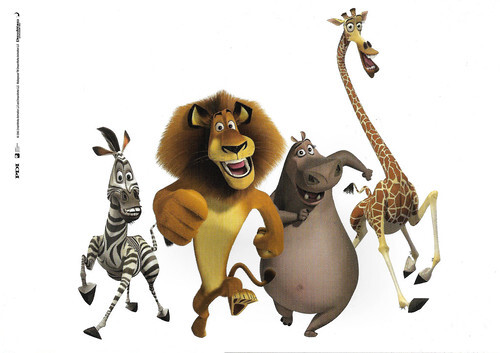
Belgian postcard by Boomerang.be. Image: PDI / UIP / Dreamworks. The animals of Madagascar (Eric Darnell, Tom McGrath, 2005).
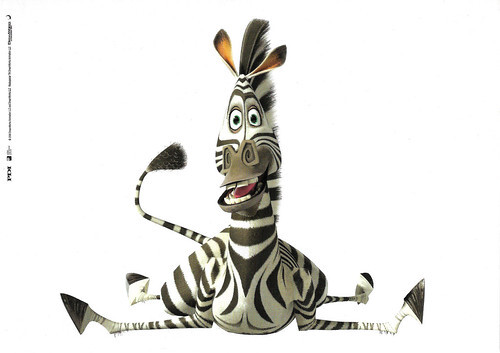
Belgian postcard by Boomerang.be. Image: PDI / UIP / Dreamworks. Marty the Zebra in Madagascar (Eric Darnell, Tom McGrath, 2005).
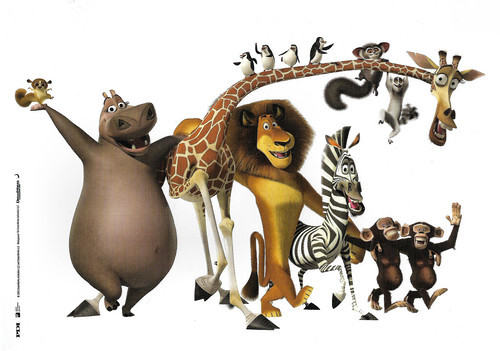
Belgian postcard by Boomerang.be. Image: PDI / UIP / Dreamworks. The animals of Madagascar (Eric Darnell, Tom McGrath, 2005).
A midlife crisis after his 10th birthday
Madagascar (2005) was written by Eric Darnell, Tom McGrath, Mark Burton, and Billy Frolick.
Marty the zebra, Alex the lion, Gloria the hippo and Melman the giraffe live at the Central Park Zoo in New York. There they perform for the visitors, and Alex in particular is the big star.
Marty suffers a midlife crisis after his 10th birthday and wants to escape to live in the wild. One night, Marty escapes along with two chimpanzees and four penguins. Alex now wants to escape too - along with Gloria and Melman - to get him back. After all, Alex himself loves the zoo and is afraid Marty will do stupid things that might get them all transferred.
People panic and the animals are stunned and trapped. While the animals are sedated, animal protection groups and protesters, who believe the animals belong in the wild, put pressure on the zoo and the city government. One gave in and sent the animals back to Africa. They are now captured and locked in wooden crates taken by a cargo ship. On the way, the crates fall off the ship and wash up on the island of Madagascar.
There they meet a colony of lemurs led by King Julien XIII who welcomes them. This colony is in fact besieged by fossas, who are startled by Alex and his fearsome roar. However, some problems arise on the island when Alex gets really hungry for the first time in his life. After all, in the zoo, he was always given meat, which is only available in Madagascar if he kills other animals...
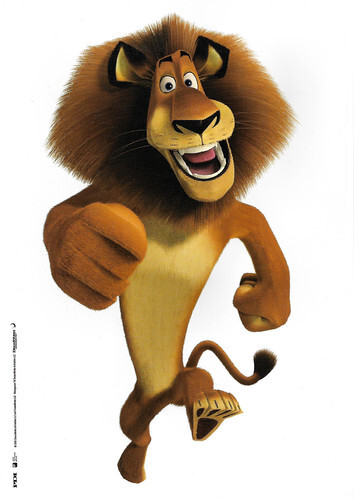
Belgian postcard by Boomerang.be. Image: PDI / UIP / Dreamworks. Alex, a lion, in Madagascar (Eric Darnell, Tom McGrath, 2005).
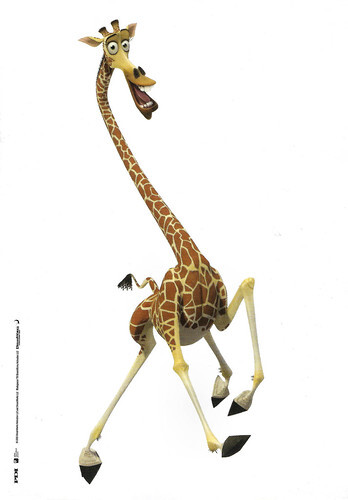
Belgian postcard by Boomerang.be. Image: PDI / UIP / Dreamworks. Melman the giraffe in Madagascar (Eric Darnell, Tom McGrath, 2005).
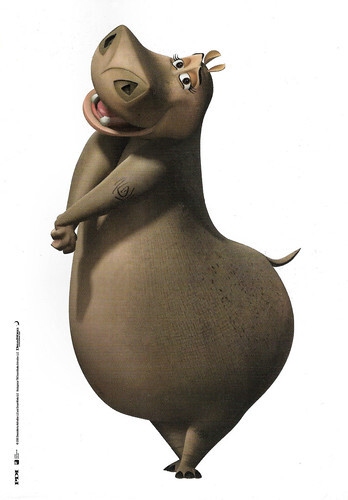
Belgian postcard by Boomerang.be. Image: PDI / UIP / Dreamworks. Gloria the hippo in Madagascar (Eric Darnell, Tom McGrath, 2005).
The penguins as a commando unit rather than a rock band
Madagascar (2005) was yet another computer-animated film about animals in a short time. According to co-director Tom McGrath, the idea for Madagascar began as a one-sentence prompt, and it took two years of development for the idea to be refined to the point where the four main characters were finalised.
In 1998, DreamWorks and PDI started development on an animated film titled Rockumentary, which featured a Beatles-like penguin rock band. The idea was scrapped, but after production on Madagascar started, director Eric Darnell decided to revive the penguins, albeit he retooled them as a commando unit rather than a rock band.
The English voices were by Ben Stiller (Alex), Jada Pinkett Smith (Gloria), Chris Rock (Marty) and David Schwimmer (Melman). Andy Richter, Bob Saget, Sacha Baron Cohen (King Julien XIII) and Cedric the Entertainer also make appearances.
Critic Roger Ebert was mildly amused: "Madagascar is funny, especially at the beginning, and good-looking in a retro cartoon way, but in a world where the stakes have been raised by Finding Nemo, Shrek and The Incredibles, it's a throwback to a more conventional kind of animated entertainment." At the box office, the film became a huge success. Worldwide, Madagascar was the sixth most successful film of the year. Competitor Pixar did not make a major animated film in 2005, a big advantage. In 2004, when DreamWorks released the second part of Shrek, it did have major competition due to the premiere of The Incredibles. Shrek 2 ended up being the big box-office success of 2004, while The Incredibles did a bit less.
Madagascar is often compared to the Disney film The Wild (2006). That film, starring Kiefer Sutherland as the lion, did much worse, although it was not a flop. The Madagascar DVD was released in 2005, including a short animated film called The Madagascar Penguins in a Christmas Caper. That short animated film was also shown in cinemas ahead of other films. Later, two sequels followed - Madagascar: Escape 2 Africa (Eric Darnell, Tom McGrath, 2008) and Madagascar 3: Europe's Most Wanted (Eric Darnell, Conrad Vernon, Tom McGrath, 2012). A fourth film is coming up.

Dutch postcard by Boomerang Schoolcards, Amsterdam, no WK23-05. Image: UIP / Dreamworks. Publicity for Madagascar (2005). Caption: From the creators of Shrek and Shark Tale. Visit Madagascar, Lose yourself in the wild, It's a jungle out there, Departing June.
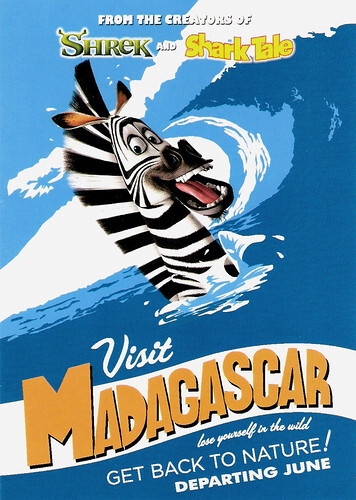
Dutch postcard by Boomerang Schoolcards, Amsterdam. Image: UIP / Dreamworks. Publicity for Madagascar (2005). Caption: From the creators of Shrek and Shark Tale. Visit Madagascar, Lose yourself in the wild, Get back to nature! Departing June.
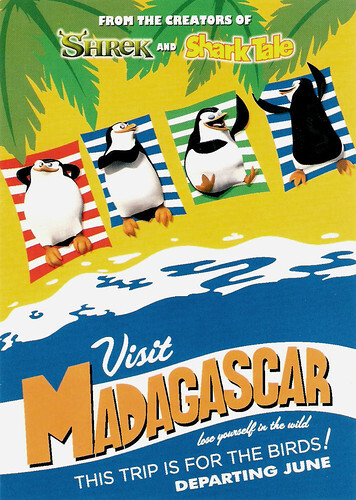
Dutch postcard by Boomerang Schoolcards, Amsterdam. Image: UIP / Dreamworks. Publicity for Madagascar (2005). Caption: From the creators of Shrek and Shark Tale. Visit Madagascar, Lose yourself in the wild, This trip is for the birds! Departing June.
Sources: Roger Ebert (RogerEbertCom), Wikipedia (Dutch and English) and IMDb.

Belgian postcard by Boomerang.be. Image: PDI / UIP / Dreamworks. The animals of Madagascar (Eric Darnell, Tom McGrath, 2005).

Belgian postcard by Boomerang.be. Image: PDI / UIP / Dreamworks. Marty the Zebra in Madagascar (Eric Darnell, Tom McGrath, 2005).

Belgian postcard by Boomerang.be. Image: PDI / UIP / Dreamworks. The animals of Madagascar (Eric Darnell, Tom McGrath, 2005).
A midlife crisis after his 10th birthday
Madagascar (2005) was written by Eric Darnell, Tom McGrath, Mark Burton, and Billy Frolick.
Marty the zebra, Alex the lion, Gloria the hippo and Melman the giraffe live at the Central Park Zoo in New York. There they perform for the visitors, and Alex in particular is the big star.
Marty suffers a midlife crisis after his 10th birthday and wants to escape to live in the wild. One night, Marty escapes along with two chimpanzees and four penguins. Alex now wants to escape too - along with Gloria and Melman - to get him back. After all, Alex himself loves the zoo and is afraid Marty will do stupid things that might get them all transferred.
People panic and the animals are stunned and trapped. While the animals are sedated, animal protection groups and protesters, who believe the animals belong in the wild, put pressure on the zoo and the city government. One gave in and sent the animals back to Africa. They are now captured and locked in wooden crates taken by a cargo ship. On the way, the crates fall off the ship and wash up on the island of Madagascar.
There they meet a colony of lemurs led by King Julien XIII who welcomes them. This colony is in fact besieged by fossas, who are startled by Alex and his fearsome roar. However, some problems arise on the island when Alex gets really hungry for the first time in his life. After all, in the zoo, he was always given meat, which is only available in Madagascar if he kills other animals...

Belgian postcard by Boomerang.be. Image: PDI / UIP / Dreamworks. Alex, a lion, in Madagascar (Eric Darnell, Tom McGrath, 2005).

Belgian postcard by Boomerang.be. Image: PDI / UIP / Dreamworks. Melman the giraffe in Madagascar (Eric Darnell, Tom McGrath, 2005).

Belgian postcard by Boomerang.be. Image: PDI / UIP / Dreamworks. Gloria the hippo in Madagascar (Eric Darnell, Tom McGrath, 2005).
The penguins as a commando unit rather than a rock band
Madagascar (2005) was yet another computer-animated film about animals in a short time. According to co-director Tom McGrath, the idea for Madagascar began as a one-sentence prompt, and it took two years of development for the idea to be refined to the point where the four main characters were finalised.
In 1998, DreamWorks and PDI started development on an animated film titled Rockumentary, which featured a Beatles-like penguin rock band. The idea was scrapped, but after production on Madagascar started, director Eric Darnell decided to revive the penguins, albeit he retooled them as a commando unit rather than a rock band.
The English voices were by Ben Stiller (Alex), Jada Pinkett Smith (Gloria), Chris Rock (Marty) and David Schwimmer (Melman). Andy Richter, Bob Saget, Sacha Baron Cohen (King Julien XIII) and Cedric the Entertainer also make appearances.
Critic Roger Ebert was mildly amused: "Madagascar is funny, especially at the beginning, and good-looking in a retro cartoon way, but in a world where the stakes have been raised by Finding Nemo, Shrek and The Incredibles, it's a throwback to a more conventional kind of animated entertainment." At the box office, the film became a huge success. Worldwide, Madagascar was the sixth most successful film of the year. Competitor Pixar did not make a major animated film in 2005, a big advantage. In 2004, when DreamWorks released the second part of Shrek, it did have major competition due to the premiere of The Incredibles. Shrek 2 ended up being the big box-office success of 2004, while The Incredibles did a bit less.
Madagascar is often compared to the Disney film The Wild (2006). That film, starring Kiefer Sutherland as the lion, did much worse, although it was not a flop. The Madagascar DVD was released in 2005, including a short animated film called The Madagascar Penguins in a Christmas Caper. That short animated film was also shown in cinemas ahead of other films. Later, two sequels followed - Madagascar: Escape 2 Africa (Eric Darnell, Tom McGrath, 2008) and Madagascar 3: Europe's Most Wanted (Eric Darnell, Conrad Vernon, Tom McGrath, 2012). A fourth film is coming up.

Dutch postcard by Boomerang Schoolcards, Amsterdam, no WK23-05. Image: UIP / Dreamworks. Publicity for Madagascar (2005). Caption: From the creators of Shrek and Shark Tale. Visit Madagascar, Lose yourself in the wild, It's a jungle out there, Departing June.

Dutch postcard by Boomerang Schoolcards, Amsterdam. Image: UIP / Dreamworks. Publicity for Madagascar (2005). Caption: From the creators of Shrek and Shark Tale. Visit Madagascar, Lose yourself in the wild, Get back to nature! Departing June.

Dutch postcard by Boomerang Schoolcards, Amsterdam. Image: UIP / Dreamworks. Publicity for Madagascar (2005). Caption: From the creators of Shrek and Shark Tale. Visit Madagascar, Lose yourself in the wild, This trip is for the birds! Departing June.
Sources: Roger Ebert (RogerEbertCom), Wikipedia (Dutch and English) and IMDb.
Published on April 26, 2023 22:00
April 25, 2023
Harry Belafonte (1927-2023)
Singer, actor, composer, author, and producer Harry Belafonte (1927-2023), who passed away on Monday 25 April 2023, was one of the most successful African-American artists in history. In 1954, he became the first black performer to receive a Tony Award, and in 1957 the first African-American man to receive an Emmy Award, with his first solo TV special 'Tonight with Belafonte' (1959). As the 'King of Calypso', he popularised the Caribbean musical style internationally in the 1950s. His breakthrough album 'Calypso' (1956) is the first million-selling album by a single artist and his hit 'The Banana Boat Song' has become an evergreen. He also starred in several films, most notably in Otto Preminger's hit musical Carmen Jones (1954), Island in the Sun (Robert Rossen, 1957), Odds Against Tomorrow (Robert Wise, 1959), Robert Altman's Kansas City (1996), Bobby (Emilio Estevez, 2006) and more recently Spike Lee's BlacKkKlansman (2018). Throughout his career, he was an advocate for humanitarian causes, such as the anti-apartheid movement and USA for Africa.
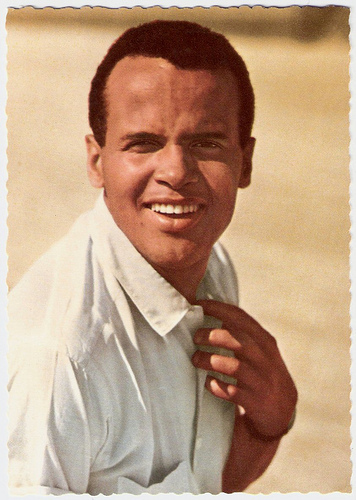
German postcard by Ufa (Universum-Film Aktiengesellschaft), Berlin-Tempelhof, no. CK 232. Retail price: 30 Pfg. Photo: Fried Agency.
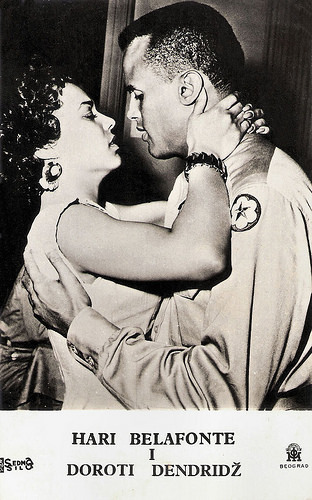
Yugoslavian postcard by IOM, Beograd. Photo: Sedmo Silo. Publicity still for Carmen Jones (Otto Preminger, 1954) with Dorothy Dandridge .
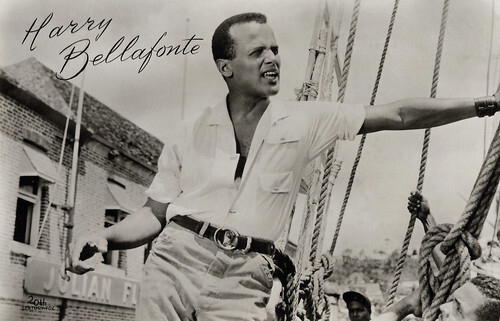
Dutch postcard by Uitgeverij Takken, Utrecht, no. AX 3680. Photo: 20th Century Fox. Harry Belafonte in Island in the Sun (Robert Rossen, 1957). Belafonte's name is misspelt on the card.
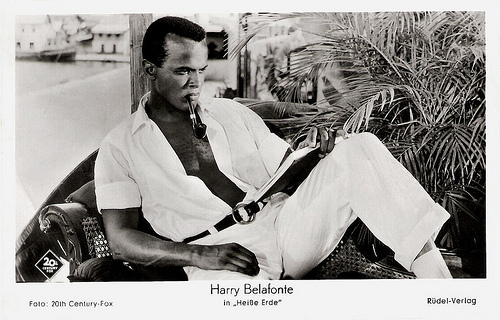
German postcard by Rüdel-Verlag, Hamburg-Bergedorf, no. 2186. Photo: 20th Century Fox. Publicity still for Island in the Sun (Robert Rossen, 1957).
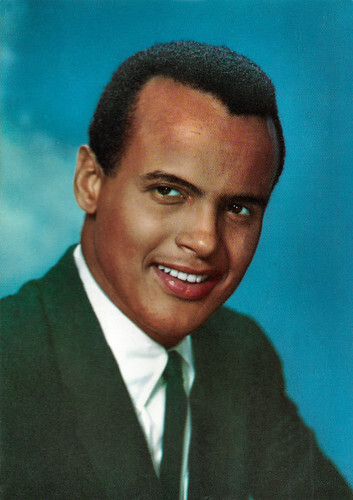
French postcard by Editions P.I., Paris, no. 143, offered by Les Carbones Korès "Carboplane", no. 174.
The King of Calypso
Harry Belafonte was born Harold George Bellanfanti Jr. at Lying-in Hospital in 1927, in Harlem, New York. He was the son of Melvine (née Love), a housekeeper, and Harold George Bellanfanti Sr., who worked as a chef. His mother was born in Jamaica, the child of a Scottish white mother and a black father. His father also was born in Jamaica, the child of a black mother and a Dutch Jewish father of Sephardi origins. From 1932 to 1940, he lived with one of his grandmothers in her native country of Jamaica, where he attended Wolmer's Schools. When he returned to New York City, he attended George Washington High School after which he joined the Navy and served during World War II.
In the 1940s, he was working as a janitor's assistant in NYC when a tenant gave him, as a gratuity, two tickets to see the American Negro Theater. He fell in love with the art form and also met Sidney Poitier . The financially struggling pair regularly purchased a single seat to local plays, trading places in between acts, after informing each other about the progression of the play. At the end of the 1940s, he took classes in acting at the Dramatic Workshop of The New School in New York with the influential German director Erwin Piscator alongside Marlon Brando , Tony Curtis , Walter Matthau, Bea Arthur, and Sidney Poitier , while performing with the American Negro Theatre in such plays as 'Days of Our Youth' (1946). In 1954, he would receive a Tony Award for his participation in the Broadway revue 'John Murray Anderson's Almanac'.
Belafonte started his career in music as a club singer in New York to pay for his acting classes. The first time he appeared in front of an audience at the Village Vanguard in New York, he was backed by the Charlie Parker band, which included Charlie Parker himself, Max Roach, and Miles Davis, among others. At first, he was a pop singer, launching his recording career on the Roost label in 1949, but later he developed a keen interest in folk music, learning material through the Library of Congress's American folk songs archives. With guitarist and friend Millard Thomas, Belafonte soon made his debut at the legendary jazz club The Village Vanguard. In 1952, he received a contract with RCA Victor. His first widely released single, which went on to become his 'signature' song with audience participation in virtually all his live performances, was 'Matilda' (1953). His breakthrough album 'Calypso' (1956) became the first LP in the world to sell over 1 million copies within a year. It spent 31 weeks at number 1, 58 weeks in the top ten, and 99 weeks on the U.S. charts. The album introduced American audiences to calypso music, which had originated in Trinidad and Tobago in the early 20th century.
Belafonte was dubbed the 'King of Calypso', a title he wore with reservations since he had no claims to any Calypso Monarch titles. One of the songs included in the album is the now famous 'Banana Boat Song' (listed as 'Day O' on the original release), which reached number five on the pop charts. His other smash hit was 'Jump in the Line'. Many of the compositions recorded for Calypso, including 'Banana Boat Song', gave songwriting credit to Irving Burgie. His triumphant success as an entertainer in the arts did not protect Belafonte from racial discrimination, particularly in the South. As a result, he refused to perform in the southern region of the United States from 1954 until 1961.
Belafonte's first film role was in Bright Road (Gerald Mayer, 1953), in which he appeared alongside Dorothy Dandridge . In this low-budget film adapted from the Christopher Award-winning short story 'See How They Run' by Mary Elizabeth Vroman, Dandridge starred as an idealistic first-year elementary school teacher trying to reach out to a problem student. Belafonte played the principal of the school. The two subsequently starred in Otto Preminger's hit musical Carmen Jones (1954). The screenplay by Harry Kleiner was based on the lyrics and book by Oscar Hammerstein II, from the 1943 stage musical of the same name, set to the music of Georges Bizet's 1875 opera 'Carmen'. Ironically, Belafonte's singing in the film was dubbed by an opera singer, as Belafonte's own singing voice was seen as unsuitable for the role. Using his star clout, Belafonte was subsequently able to realise several then-controversial film roles. Island in the Sun (Robert Rossen, 1957) is about race relations and interracial romance set on the fictitious island of Santa Marta. The film was controversial at the time of its release for its hints of an affair between Belafonte's character and the character played by Joan Fontaine. The film also starred James Mason , Dorothy Dandridge, and Joan Collins .
In 1959, he starred in and produced the Film Noir Odds Against Tomorrow (Robert Wise, 1959), in which he played a bank robber uncomfortably teamed with a racist partner (Robert Ryan). He also co-starred with Inger Stevens in the Science-Fiction doomsday film The World, the Flesh and the Devil (Ranald MacDougall, 1959). Belafonte was offered the role of Porgy in Porgy and Bess (Otto Preminger, 1959), based on the 1935 opera Porgy and Bess by George Gershwin, DuBose Heyward, and Ira Gershwin. Here he would have once again starred opposite Dorothy Dandridge , but he refused the role because he objected to its racial stereotyping. Sidney Poitier would play the role in the film. Dissatisfied with the film roles available to him, he returned to music during the 1960s.
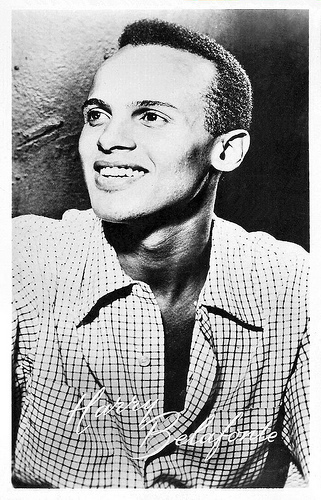
Dutch postcard by Uitgeverij Takken, Utrecht, no. 2054.
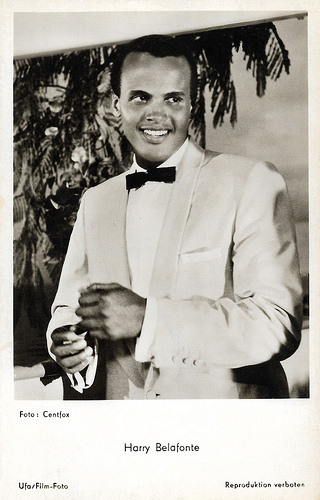
German postcard by Ufa/Film-Foto, Berlin-Tempelhof, no. FK 3791. Photo: Centfox. Publicity still for Island in the Sun (Robert Rossen, 1957).
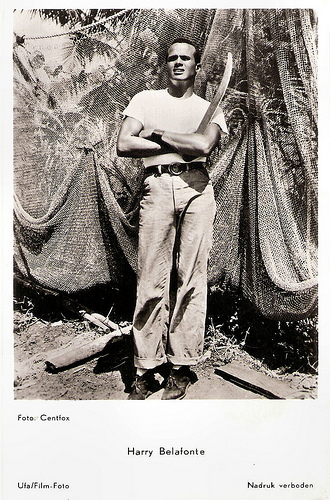
Dutch postcard by Gebr. Spanjersberg N.V., Rotterdam, no. 3793. Photo: Centfox. Publicity still for Island in the Sun (Robert Rossen, 1957).
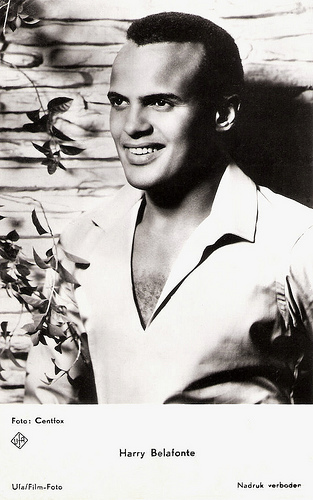
Dutch postcard by Gebr. Spanjersberg N.V., Rotterdam, no. 4022. Photo: Centfox. Publicity still for Island in the Sun (Robert Rossen, 1957).
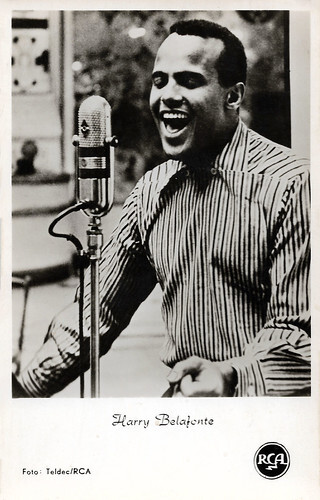
Dutch postcard by Editions Altona, Amsterdam, no. 5167. Photo: Teldec / RCA.
The Banana Boat Song
While primarily known for calypso, Harry Belafonte has recorded in many different genres, including blues, folk, gospel, show tunes and American standards. His second-most popular hit, which came immediately after 'The Banana Boat Song', was the comedic tune 'Mama Look at Bubu', also known as 'Mama Look a Boo-Boo' (originally recorded by Lord Melody in 1955), in which he sings humorously about misbehaving and disrespectful children. It reached number eleven on the pop chart. In 1959, he starred in Tonight With Belafonte, a nationally televised special that featured Odetta. Belafonte was the first Jamaican American to win an Emmy, for Revlon Revue: Tonight with Belafonte (1959). Belafonte recorded for RCA Victor from 1953 to 1974. Two live albums, both recorded at Carnegie Hall in 1959 and 1960, enjoyed critical and commercial success. From his 1959 album, 'Hava Nagila' became part of his regular routine and one of his signature songs. He was one of many entertainers recruited by Frank Sinatra to perform at the inaugural gala of President John F. Kennedy in 1961. That same year he released his second calypso album, 'Jump Up Calypso', which went on to become another million-seller. During the 1960s he introduced several artists to American audiences, most notably South African singer Miriam Makeba and Greek singer Nana Mouskouri. His album 'Midnight Special' (1962) included a young harmonica player named Bob Dylan.
As The Beatles and other stars from Britain began to dominate the pop charts, Belafonte's commercial success diminished. His 'Belafonte at The Greek Theatre' was his last album to appear in Billboard's Top 40. His last hit single, 'A Strange Song', was released in 1967 and peaked at number 5 on the charts. Belafonte has received Grammy Awards for the albums 'Swing Dat Hammer' (1960) and 'An Evening with Belafonte/Makeba' (1965). The latter album dealt with the political plight of black South Africans under apartheid. In 1967, Belafonte was the first non-classical artist to perform at the prestigious Saratoga Performing Arts Center (SPAC) in Upstate New York, soon to be followed by concerts there by The Doors, The 5th Dimension, The Who, and Janis Joplin. In February 1968, Belafonte guest-hosted The Tonight Show substituting for Johnny Carson. Among his interview guests were Martin Luther King Jr. and Sen. Robert F. Kennedy.
During the 1960s, he appeared on TV specials alongside such artists as Julie Andrews , Petula Clark , Lena Horne , and Nana Mouskouri. In 1968, Belafonte appeared on a Petula Clark TV special on NBC. In the middle of a song, Clark smiled and briefly touched Belafonte's arm. The show's sponsor, Plymouth Motors, wanted to cut out the segment, but Clark, who had ownership of the special, told NBC that the performance would be shown intact or not at all. American newspapers published articles reporting the controversy and, when the special aired, it grabbed huge ratings.
In the early 1970s, Belafonte returned to the cinema in two films with Sidney Poitier. The Western Buck and the Preacher (Sidney Poitier, 1972) broke Hollywood Western traditions by casting blacks as central characters and portraying both tension and solidarity between African Americans and Native Americans in the late 19th century. Buck and the Preacher was one of the first films directed by an African American and to be based on a band of African Americans fighting against the White majority. The film was produced by Belafonte Enterprises, Columbia Pictures Corporation, and E & R Productions Corp. Uptown Saturday Night (Sidney Poitier, 1974) is an action-comedy crime film written by Richard Wesley and starring Sidney Poitier , Bill Cosby, and Harry Belafonte. Although the film received mixed reviews, it was a commercial success and was part of the Blaxploitation wave. Later, Cosby and Poitier teamed up again, without Belafonte, for the sequels Let's Do It Again (Sidney Poitier, 1975) and A Piece of the Action (Sidney Poitier, 1977).
Harry Belafonte's recording activity slowed after he left RCA in the mid-1970s. RCA released his fifth and final Calypso album, 'Calypso Carnival' in 1971. From the mid-1970s to the early 1980s, Belafonte spent the greater part of his time touring Japan, Europe, Cuba, and elsewhere. In 1977, he released the album 'Turn the World Around' at Columbia Records. The album, with a strong focus on world music, was never issued in the United States.He subsequently was a guest star on a memorable episode of The Muppet Show (1978), in which he performed his signature song 'Day-O' on television for the first time. However, the episode is best known for Belafonte's rendition of the spiritual song 'Turn the World Around', from the album of the same name, which he performed with specially made Muppets that resembled African tribal masks. Belafonte reprised the song at John Henson's memorial in 1990.
In 1984, Belafonte produced and scored the musical film Beat Street (Stan Lathan, 1984). Set in the South Bronx, the film follows the lives of a pair of brothers and their group of friends, all of whom are devoted to various elements of early hip-hop culture. The cast included Rae Dawn Chong and Guy Davis. Together with Arthur Baker, Belafonte produced the gold-certified soundtrack of the same name. Beat Street's impact was felt internationally as well as throughout the United States. In Germany, for example, films such as Beat Street are credited with introducing the hip-hop movement to the country. In 1985, he was one of the organisers behind the Grammy Award-winning song 'We Are the World', a multi-artist effort to raise funds for Africa, and performed in the Live Aid concert that same year. Belafonte's involvement in 'USA for Africa' resulted in renewed interest in his music, culminating in a record deal with EMI. He subsequently released his first album of original material in over a decade, 'Paradise in Gazankulu', (1988). The album contains ten protest songs against the South African former Apartheid policy and is his last studio album. As UNICEF Goodwill Ambassador, Belafonte attended in 1988 a symposium in Harare, Zimbabwe, to focus attention on child survival and development in Southern African countries. As part of the symposium, he performed a concert for UNICEF. A Kodak video crew filmed the concert, which was released as a 60-minute concert video titled Global Carnival. Also in 1988, Tim Burton used 'The Banana Boat Song' and 'Jump in the Line' in his film Beetlejuice (Tim Burton, 1988).
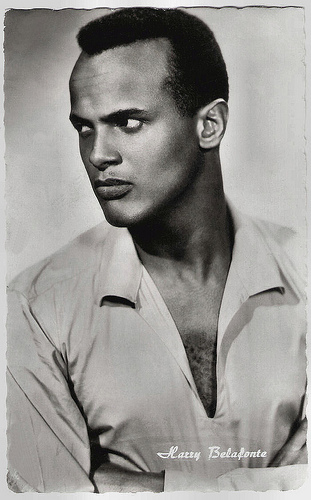
Dutch postcard, no. 2099. Photo: Centfox. Publicity still for Island in the Sun (Robert Rossen, 1957).
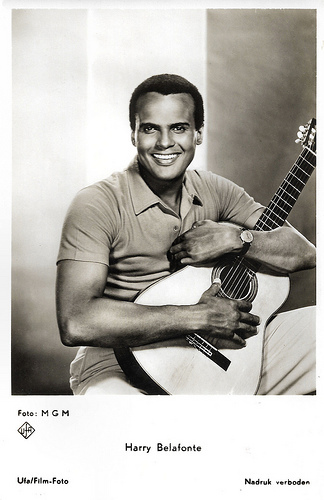
Dutch postcard by D.R.C., Holland, no. 1172. Photo: MGM /Ufa.
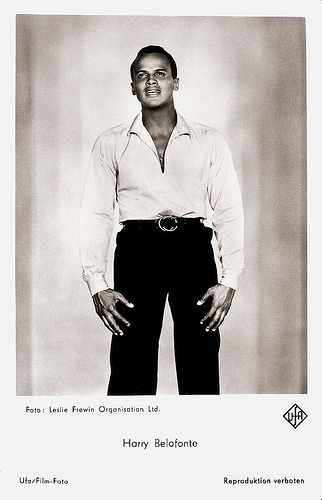
German postcard by Ufa/Film-Foto, Berlin-Tempelhof, no. FK 4282. Photo: Leslie Frewin Organisation Ltd.
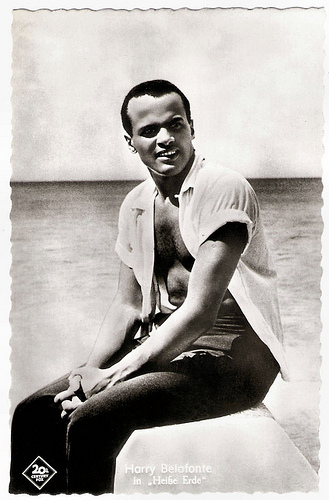
German postcard by Kolibri-Verlag, Minden/Westf., no. 2945. Photo: 20th Century Fox. Publicity still for Island in the Sun (Robert Rossen, 1957).
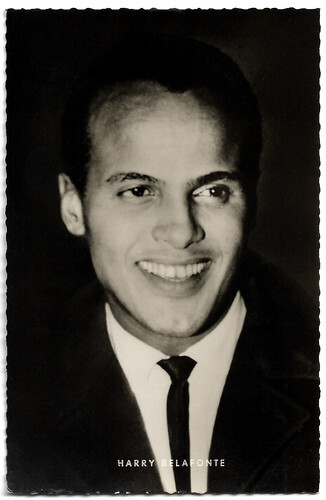
West-German postcard by Kunst und Bild, Berlin-Charlottenburg, no. V 143.
Always outspoken in his beliefs
Belafonte appeared with John Travolta in the film drama White Man's Burden (1995), about racism in an alternative America where black and white Americans have reversed cultural roles. The film was written and directed by Desmond Nakano. The film revolves around Louis Pinnock (Travolta), a white factory worker, who kidnaps Thaddeus Thomas (Belafonte), a black factory owner for firing him over a perceived slight. The film gained a negative reception from the critics and was not a box-office success. For Robert Altman's jazz age drama Kansas City (1996), he won the New York Film Critics Circle Award for Best Supporting Actor. Kansas City, which stars Jennifer Jason Leigh and Miranda Richardson, is also notable for its musical score being integrated into the film, with modern-day musicians recreating the Kansas City jazz of the 1930s. For instance, Craig Handy played the role of Coleman Hawkins, Geri Allen played Mary Lou Williams, and James Carter played Ben Webster.
Following a lengthy recording hiatus, 'An Evening with Harry Belafonte and Friends' (1997), a soundtrack and video of a televised concert, were released by Island Records. 'The Long Road to Freedom: An Anthology of Black Music', a huge multi-artist project recorded by RCA during the 1960s and 1970s, was finally released by the label in 2001. Belafonte went on the Today Show to promote the album on 11 September 2001 and was interviewed by Katie Couric just minutes before the first plane hit the World Trade Center. The album was nominated for the 2002 Grammy Awards for Best Boxed Recording Package, for Best Album Notes, and for Best Historical Album. On television, Harry Belafonte starred as an Associate Justice of the Supreme Court of the United States in the TV drama Swing Vote (David Anspaugh, 1999) with Andy Garcia. In 2006, Belafonte appeared in the film Bobby, Emilio Estevez's ensemble drama about the assassination of Robert F. Kennedy. Belafonte played Nelson, a friend of an employee of the Ambassador Hotel (Anthony Hopkins).
Belafonte received the Kennedy Center Honors in 1989. He was awarded the National Medal of Arts in 1994 and he won a Grammy Lifetime Achievement Award in 2000. He performed sold-out concerts globally from the 1950s to the 2000s. Owing to illness, he was forced to cancel a reunion tour with Nana Mouskouri planned for the spring and summer of 2003 following a tour in Europe. His last concert was a benefit concert for the Atlanta Opera on 25 October 2003. In a 2007 interview, he stated that he had since retired from performing. In 2017 Harry Belafonte released 'When Colors Come Together', an anthology of his music for Sony Legends produced by his son David Belafonte. David wrote a remake of 'Island In The Sun', arranged by longtime Belafonte musical director Richard Cummings featuring Harry Belafonte's grandchildren Sarafina and Amadeus and a children's choir.
Always outspoken in his beliefs, Belafonte achieved widespread attention for his political views in 2002 when he began making a series of negative comments about President George W. Bush and the Iraq War. Belafonte created controversy in October 2002 when he made disparaging remarks about Secretary of State Colin Powell. Far from being upset, Powell reportedly took the remarks good-humoured, refusing to inflame the situation any further. Belafonte's other controversial political statements on U.S. foreign policy have included opposing the U.S. embargo on Cuba, praising Soviet peace initiatives, attacking the U.S. invasion of Grenada, praising the Abraham Lincoln Brigade, honouring Ethel, and Julius Rosenberg, and praising Fidel Castro.
On a Martin Luther King Day speech at Duke University in 2006, Belafonte compared the American government to the 9/11 terrorists. Belafonte and his first wife Marguerite Byrd were married from 1948 to 1957. They have two daughters: Adrienne and Shari, who also worked as an actress. In 1957, Belafonte married his second wife Julie Robinson, a former dancer with the Katherine Dunham Company who was of Jewish descent. They had two children, David and Gina. David, the only son of Harry Belafonte, is a former model and actor and is an Emmy-winning and Grammy-nominated music producer and the executive director of the family-held company Belafonte Enterprises Inc. As a music producer, David has been involved in most of Belafonte's albums and tours and productions. After 47 years of marriage, Belafonte and Robinson got a divorce. In April 2008, Harry Belafonte married photographer Pamela Frank.
In 2018, Belafonte returned to the cinema in Spike Lee's biographical crime film BlacKkKlansman (2018) as an elderly civil rights pioneer. Set in 1970s Colorado Springs, the plot follows the first African-American detective in the city's police department as he sets out to infiltrate and expose the local chapter of the Ku Klux Klan. BlacKkKlansman premiered at the 2018 Cannes Film Festival, where it won the Grand Prix. Belafonte appears in the film recounting the lynching of Jesse Washington, a black teenage farmhand who was lynched in the county seat of Waco, Texas, on 15 May 1916, in what became a well-known example of racially motivated lynching. In 2019, the film won an Oscar for Best Adapted Screenplay. It was written by Charlie Wachtel, David Rabinowitz, Kevin Willmott and Spike Lee. Harry Belafonte died in New York on 25 April 2023, due to congestive heart failure. He was 96.
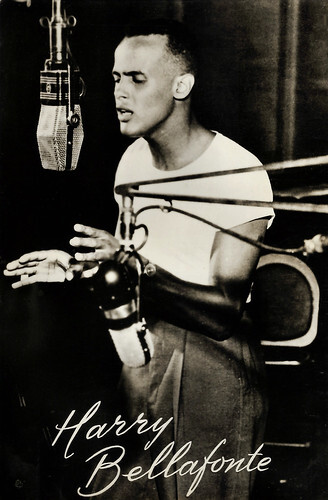
Dutch postcard by Uitg. Takken, Utrecht, no. 3241.
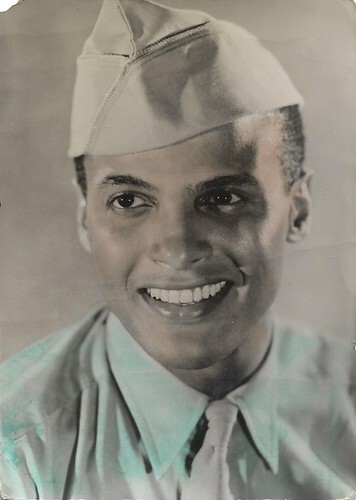
Former Yugoslavian (Croatian) postcard by 3 K, no. 3845, mailed on 18-7-1963. Harry Belafonte in Carmen Jones (Otto Preminger, 1954).
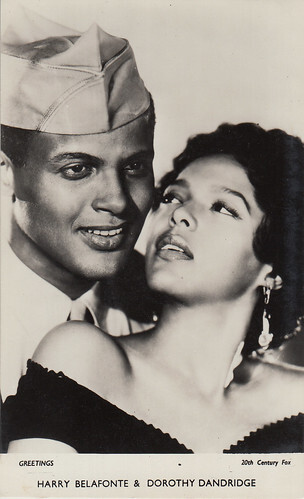
British postcard in the Greetings series. Photo: 20th Century Fox. Dorothy Dandridge and Harry Belafonte in Carmen Jones (Otto Preminger, 1954). Collection: Marlene Pilaete.
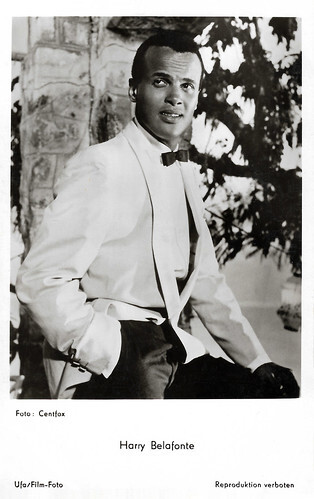
West-German postcard by Ufa/Film-Foto, Berlin-Tempelhof, no. FK 3659. Photo: Centfox. Harry Belafonte in Island in the Sun (Robert Rossen, 1957).
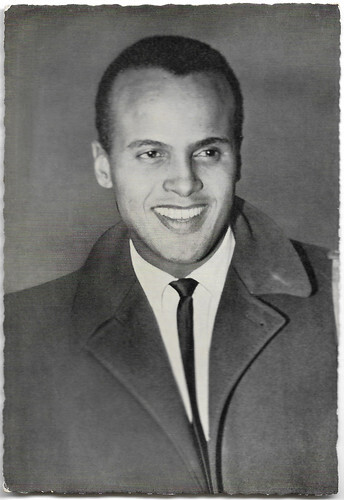
West-German postcard by WS-Druck, Wanne-Eickel, no. 174. Photo: dpa / Centfox.
Trailer for Bright Road (1953). Source: Department of Afro-American Research Arts Culture (YouTube).
Harry Belafonte sings the title song from Island In The Sun (1957) on TV. Source: Kester 1940 (YouTube).
'Day-O' (The Banana Boat Song) in Beetlejuice (1988). Source: Lipebianc (YouTube).
Harry Belafonte and The Muppets perform 'Earth Song'. Source: LenușTM (YouTube).
Sources: Wikipedia and .

German postcard by Ufa (Universum-Film Aktiengesellschaft), Berlin-Tempelhof, no. CK 232. Retail price: 30 Pfg. Photo: Fried Agency.

Yugoslavian postcard by IOM, Beograd. Photo: Sedmo Silo. Publicity still for Carmen Jones (Otto Preminger, 1954) with Dorothy Dandridge .

Dutch postcard by Uitgeverij Takken, Utrecht, no. AX 3680. Photo: 20th Century Fox. Harry Belafonte in Island in the Sun (Robert Rossen, 1957). Belafonte's name is misspelt on the card.

German postcard by Rüdel-Verlag, Hamburg-Bergedorf, no. 2186. Photo: 20th Century Fox. Publicity still for Island in the Sun (Robert Rossen, 1957).

French postcard by Editions P.I., Paris, no. 143, offered by Les Carbones Korès "Carboplane", no. 174.
The King of Calypso
Harry Belafonte was born Harold George Bellanfanti Jr. at Lying-in Hospital in 1927, in Harlem, New York. He was the son of Melvine (née Love), a housekeeper, and Harold George Bellanfanti Sr., who worked as a chef. His mother was born in Jamaica, the child of a Scottish white mother and a black father. His father also was born in Jamaica, the child of a black mother and a Dutch Jewish father of Sephardi origins. From 1932 to 1940, he lived with one of his grandmothers in her native country of Jamaica, where he attended Wolmer's Schools. When he returned to New York City, he attended George Washington High School after which he joined the Navy and served during World War II.
In the 1940s, he was working as a janitor's assistant in NYC when a tenant gave him, as a gratuity, two tickets to see the American Negro Theater. He fell in love with the art form and also met Sidney Poitier . The financially struggling pair regularly purchased a single seat to local plays, trading places in between acts, after informing each other about the progression of the play. At the end of the 1940s, he took classes in acting at the Dramatic Workshop of The New School in New York with the influential German director Erwin Piscator alongside Marlon Brando , Tony Curtis , Walter Matthau, Bea Arthur, and Sidney Poitier , while performing with the American Negro Theatre in such plays as 'Days of Our Youth' (1946). In 1954, he would receive a Tony Award for his participation in the Broadway revue 'John Murray Anderson's Almanac'.
Belafonte started his career in music as a club singer in New York to pay for his acting classes. The first time he appeared in front of an audience at the Village Vanguard in New York, he was backed by the Charlie Parker band, which included Charlie Parker himself, Max Roach, and Miles Davis, among others. At first, he was a pop singer, launching his recording career on the Roost label in 1949, but later he developed a keen interest in folk music, learning material through the Library of Congress's American folk songs archives. With guitarist and friend Millard Thomas, Belafonte soon made his debut at the legendary jazz club The Village Vanguard. In 1952, he received a contract with RCA Victor. His first widely released single, which went on to become his 'signature' song with audience participation in virtually all his live performances, was 'Matilda' (1953). His breakthrough album 'Calypso' (1956) became the first LP in the world to sell over 1 million copies within a year. It spent 31 weeks at number 1, 58 weeks in the top ten, and 99 weeks on the U.S. charts. The album introduced American audiences to calypso music, which had originated in Trinidad and Tobago in the early 20th century.
Belafonte was dubbed the 'King of Calypso', a title he wore with reservations since he had no claims to any Calypso Monarch titles. One of the songs included in the album is the now famous 'Banana Boat Song' (listed as 'Day O' on the original release), which reached number five on the pop charts. His other smash hit was 'Jump in the Line'. Many of the compositions recorded for Calypso, including 'Banana Boat Song', gave songwriting credit to Irving Burgie. His triumphant success as an entertainer in the arts did not protect Belafonte from racial discrimination, particularly in the South. As a result, he refused to perform in the southern region of the United States from 1954 until 1961.
Belafonte's first film role was in Bright Road (Gerald Mayer, 1953), in which he appeared alongside Dorothy Dandridge . In this low-budget film adapted from the Christopher Award-winning short story 'See How They Run' by Mary Elizabeth Vroman, Dandridge starred as an idealistic first-year elementary school teacher trying to reach out to a problem student. Belafonte played the principal of the school. The two subsequently starred in Otto Preminger's hit musical Carmen Jones (1954). The screenplay by Harry Kleiner was based on the lyrics and book by Oscar Hammerstein II, from the 1943 stage musical of the same name, set to the music of Georges Bizet's 1875 opera 'Carmen'. Ironically, Belafonte's singing in the film was dubbed by an opera singer, as Belafonte's own singing voice was seen as unsuitable for the role. Using his star clout, Belafonte was subsequently able to realise several then-controversial film roles. Island in the Sun (Robert Rossen, 1957) is about race relations and interracial romance set on the fictitious island of Santa Marta. The film was controversial at the time of its release for its hints of an affair between Belafonte's character and the character played by Joan Fontaine. The film also starred James Mason , Dorothy Dandridge, and Joan Collins .
In 1959, he starred in and produced the Film Noir Odds Against Tomorrow (Robert Wise, 1959), in which he played a bank robber uncomfortably teamed with a racist partner (Robert Ryan). He also co-starred with Inger Stevens in the Science-Fiction doomsday film The World, the Flesh and the Devil (Ranald MacDougall, 1959). Belafonte was offered the role of Porgy in Porgy and Bess (Otto Preminger, 1959), based on the 1935 opera Porgy and Bess by George Gershwin, DuBose Heyward, and Ira Gershwin. Here he would have once again starred opposite Dorothy Dandridge , but he refused the role because he objected to its racial stereotyping. Sidney Poitier would play the role in the film. Dissatisfied with the film roles available to him, he returned to music during the 1960s.

Dutch postcard by Uitgeverij Takken, Utrecht, no. 2054.

German postcard by Ufa/Film-Foto, Berlin-Tempelhof, no. FK 3791. Photo: Centfox. Publicity still for Island in the Sun (Robert Rossen, 1957).

Dutch postcard by Gebr. Spanjersberg N.V., Rotterdam, no. 3793. Photo: Centfox. Publicity still for Island in the Sun (Robert Rossen, 1957).

Dutch postcard by Gebr. Spanjersberg N.V., Rotterdam, no. 4022. Photo: Centfox. Publicity still for Island in the Sun (Robert Rossen, 1957).

Dutch postcard by Editions Altona, Amsterdam, no. 5167. Photo: Teldec / RCA.
The Banana Boat Song
While primarily known for calypso, Harry Belafonte has recorded in many different genres, including blues, folk, gospel, show tunes and American standards. His second-most popular hit, which came immediately after 'The Banana Boat Song', was the comedic tune 'Mama Look at Bubu', also known as 'Mama Look a Boo-Boo' (originally recorded by Lord Melody in 1955), in which he sings humorously about misbehaving and disrespectful children. It reached number eleven on the pop chart. In 1959, he starred in Tonight With Belafonte, a nationally televised special that featured Odetta. Belafonte was the first Jamaican American to win an Emmy, for Revlon Revue: Tonight with Belafonte (1959). Belafonte recorded for RCA Victor from 1953 to 1974. Two live albums, both recorded at Carnegie Hall in 1959 and 1960, enjoyed critical and commercial success. From his 1959 album, 'Hava Nagila' became part of his regular routine and one of his signature songs. He was one of many entertainers recruited by Frank Sinatra to perform at the inaugural gala of President John F. Kennedy in 1961. That same year he released his second calypso album, 'Jump Up Calypso', which went on to become another million-seller. During the 1960s he introduced several artists to American audiences, most notably South African singer Miriam Makeba and Greek singer Nana Mouskouri. His album 'Midnight Special' (1962) included a young harmonica player named Bob Dylan.
As The Beatles and other stars from Britain began to dominate the pop charts, Belafonte's commercial success diminished. His 'Belafonte at The Greek Theatre' was his last album to appear in Billboard's Top 40. His last hit single, 'A Strange Song', was released in 1967 and peaked at number 5 on the charts. Belafonte has received Grammy Awards for the albums 'Swing Dat Hammer' (1960) and 'An Evening with Belafonte/Makeba' (1965). The latter album dealt with the political plight of black South Africans under apartheid. In 1967, Belafonte was the first non-classical artist to perform at the prestigious Saratoga Performing Arts Center (SPAC) in Upstate New York, soon to be followed by concerts there by The Doors, The 5th Dimension, The Who, and Janis Joplin. In February 1968, Belafonte guest-hosted The Tonight Show substituting for Johnny Carson. Among his interview guests were Martin Luther King Jr. and Sen. Robert F. Kennedy.
During the 1960s, he appeared on TV specials alongside such artists as Julie Andrews , Petula Clark , Lena Horne , and Nana Mouskouri. In 1968, Belafonte appeared on a Petula Clark TV special on NBC. In the middle of a song, Clark smiled and briefly touched Belafonte's arm. The show's sponsor, Plymouth Motors, wanted to cut out the segment, but Clark, who had ownership of the special, told NBC that the performance would be shown intact or not at all. American newspapers published articles reporting the controversy and, when the special aired, it grabbed huge ratings.
In the early 1970s, Belafonte returned to the cinema in two films with Sidney Poitier. The Western Buck and the Preacher (Sidney Poitier, 1972) broke Hollywood Western traditions by casting blacks as central characters and portraying both tension and solidarity between African Americans and Native Americans in the late 19th century. Buck and the Preacher was one of the first films directed by an African American and to be based on a band of African Americans fighting against the White majority. The film was produced by Belafonte Enterprises, Columbia Pictures Corporation, and E & R Productions Corp. Uptown Saturday Night (Sidney Poitier, 1974) is an action-comedy crime film written by Richard Wesley and starring Sidney Poitier , Bill Cosby, and Harry Belafonte. Although the film received mixed reviews, it was a commercial success and was part of the Blaxploitation wave. Later, Cosby and Poitier teamed up again, without Belafonte, for the sequels Let's Do It Again (Sidney Poitier, 1975) and A Piece of the Action (Sidney Poitier, 1977).
Harry Belafonte's recording activity slowed after he left RCA in the mid-1970s. RCA released his fifth and final Calypso album, 'Calypso Carnival' in 1971. From the mid-1970s to the early 1980s, Belafonte spent the greater part of his time touring Japan, Europe, Cuba, and elsewhere. In 1977, he released the album 'Turn the World Around' at Columbia Records. The album, with a strong focus on world music, was never issued in the United States.He subsequently was a guest star on a memorable episode of The Muppet Show (1978), in which he performed his signature song 'Day-O' on television for the first time. However, the episode is best known for Belafonte's rendition of the spiritual song 'Turn the World Around', from the album of the same name, which he performed with specially made Muppets that resembled African tribal masks. Belafonte reprised the song at John Henson's memorial in 1990.
In 1984, Belafonte produced and scored the musical film Beat Street (Stan Lathan, 1984). Set in the South Bronx, the film follows the lives of a pair of brothers and their group of friends, all of whom are devoted to various elements of early hip-hop culture. The cast included Rae Dawn Chong and Guy Davis. Together with Arthur Baker, Belafonte produced the gold-certified soundtrack of the same name. Beat Street's impact was felt internationally as well as throughout the United States. In Germany, for example, films such as Beat Street are credited with introducing the hip-hop movement to the country. In 1985, he was one of the organisers behind the Grammy Award-winning song 'We Are the World', a multi-artist effort to raise funds for Africa, and performed in the Live Aid concert that same year. Belafonte's involvement in 'USA for Africa' resulted in renewed interest in his music, culminating in a record deal with EMI. He subsequently released his first album of original material in over a decade, 'Paradise in Gazankulu', (1988). The album contains ten protest songs against the South African former Apartheid policy and is his last studio album. As UNICEF Goodwill Ambassador, Belafonte attended in 1988 a symposium in Harare, Zimbabwe, to focus attention on child survival and development in Southern African countries. As part of the symposium, he performed a concert for UNICEF. A Kodak video crew filmed the concert, which was released as a 60-minute concert video titled Global Carnival. Also in 1988, Tim Burton used 'The Banana Boat Song' and 'Jump in the Line' in his film Beetlejuice (Tim Burton, 1988).

Dutch postcard, no. 2099. Photo: Centfox. Publicity still for Island in the Sun (Robert Rossen, 1957).

Dutch postcard by D.R.C., Holland, no. 1172. Photo: MGM /Ufa.

German postcard by Ufa/Film-Foto, Berlin-Tempelhof, no. FK 4282. Photo: Leslie Frewin Organisation Ltd.

German postcard by Kolibri-Verlag, Minden/Westf., no. 2945. Photo: 20th Century Fox. Publicity still for Island in the Sun (Robert Rossen, 1957).

West-German postcard by Kunst und Bild, Berlin-Charlottenburg, no. V 143.
Always outspoken in his beliefs
Belafonte appeared with John Travolta in the film drama White Man's Burden (1995), about racism in an alternative America where black and white Americans have reversed cultural roles. The film was written and directed by Desmond Nakano. The film revolves around Louis Pinnock (Travolta), a white factory worker, who kidnaps Thaddeus Thomas (Belafonte), a black factory owner for firing him over a perceived slight. The film gained a negative reception from the critics and was not a box-office success. For Robert Altman's jazz age drama Kansas City (1996), he won the New York Film Critics Circle Award for Best Supporting Actor. Kansas City, which stars Jennifer Jason Leigh and Miranda Richardson, is also notable for its musical score being integrated into the film, with modern-day musicians recreating the Kansas City jazz of the 1930s. For instance, Craig Handy played the role of Coleman Hawkins, Geri Allen played Mary Lou Williams, and James Carter played Ben Webster.
Following a lengthy recording hiatus, 'An Evening with Harry Belafonte and Friends' (1997), a soundtrack and video of a televised concert, were released by Island Records. 'The Long Road to Freedom: An Anthology of Black Music', a huge multi-artist project recorded by RCA during the 1960s and 1970s, was finally released by the label in 2001. Belafonte went on the Today Show to promote the album on 11 September 2001 and was interviewed by Katie Couric just minutes before the first plane hit the World Trade Center. The album was nominated for the 2002 Grammy Awards for Best Boxed Recording Package, for Best Album Notes, and for Best Historical Album. On television, Harry Belafonte starred as an Associate Justice of the Supreme Court of the United States in the TV drama Swing Vote (David Anspaugh, 1999) with Andy Garcia. In 2006, Belafonte appeared in the film Bobby, Emilio Estevez's ensemble drama about the assassination of Robert F. Kennedy. Belafonte played Nelson, a friend of an employee of the Ambassador Hotel (Anthony Hopkins).
Belafonte received the Kennedy Center Honors in 1989. He was awarded the National Medal of Arts in 1994 and he won a Grammy Lifetime Achievement Award in 2000. He performed sold-out concerts globally from the 1950s to the 2000s. Owing to illness, he was forced to cancel a reunion tour with Nana Mouskouri planned for the spring and summer of 2003 following a tour in Europe. His last concert was a benefit concert for the Atlanta Opera on 25 October 2003. In a 2007 interview, he stated that he had since retired from performing. In 2017 Harry Belafonte released 'When Colors Come Together', an anthology of his music for Sony Legends produced by his son David Belafonte. David wrote a remake of 'Island In The Sun', arranged by longtime Belafonte musical director Richard Cummings featuring Harry Belafonte's grandchildren Sarafina and Amadeus and a children's choir.
Always outspoken in his beliefs, Belafonte achieved widespread attention for his political views in 2002 when he began making a series of negative comments about President George W. Bush and the Iraq War. Belafonte created controversy in October 2002 when he made disparaging remarks about Secretary of State Colin Powell. Far from being upset, Powell reportedly took the remarks good-humoured, refusing to inflame the situation any further. Belafonte's other controversial political statements on U.S. foreign policy have included opposing the U.S. embargo on Cuba, praising Soviet peace initiatives, attacking the U.S. invasion of Grenada, praising the Abraham Lincoln Brigade, honouring Ethel, and Julius Rosenberg, and praising Fidel Castro.
On a Martin Luther King Day speech at Duke University in 2006, Belafonte compared the American government to the 9/11 terrorists. Belafonte and his first wife Marguerite Byrd were married from 1948 to 1957. They have two daughters: Adrienne and Shari, who also worked as an actress. In 1957, Belafonte married his second wife Julie Robinson, a former dancer with the Katherine Dunham Company who was of Jewish descent. They had two children, David and Gina. David, the only son of Harry Belafonte, is a former model and actor and is an Emmy-winning and Grammy-nominated music producer and the executive director of the family-held company Belafonte Enterprises Inc. As a music producer, David has been involved in most of Belafonte's albums and tours and productions. After 47 years of marriage, Belafonte and Robinson got a divorce. In April 2008, Harry Belafonte married photographer Pamela Frank.
In 2018, Belafonte returned to the cinema in Spike Lee's biographical crime film BlacKkKlansman (2018) as an elderly civil rights pioneer. Set in 1970s Colorado Springs, the plot follows the first African-American detective in the city's police department as he sets out to infiltrate and expose the local chapter of the Ku Klux Klan. BlacKkKlansman premiered at the 2018 Cannes Film Festival, where it won the Grand Prix. Belafonte appears in the film recounting the lynching of Jesse Washington, a black teenage farmhand who was lynched in the county seat of Waco, Texas, on 15 May 1916, in what became a well-known example of racially motivated lynching. In 2019, the film won an Oscar for Best Adapted Screenplay. It was written by Charlie Wachtel, David Rabinowitz, Kevin Willmott and Spike Lee. Harry Belafonte died in New York on 25 April 2023, due to congestive heart failure. He was 96.

Dutch postcard by Uitg. Takken, Utrecht, no. 3241.

Former Yugoslavian (Croatian) postcard by 3 K, no. 3845, mailed on 18-7-1963. Harry Belafonte in Carmen Jones (Otto Preminger, 1954).

British postcard in the Greetings series. Photo: 20th Century Fox. Dorothy Dandridge and Harry Belafonte in Carmen Jones (Otto Preminger, 1954). Collection: Marlene Pilaete.

West-German postcard by Ufa/Film-Foto, Berlin-Tempelhof, no. FK 3659. Photo: Centfox. Harry Belafonte in Island in the Sun (Robert Rossen, 1957).

West-German postcard by WS-Druck, Wanne-Eickel, no. 174. Photo: dpa / Centfox.
Trailer for Bright Road (1953). Source: Department of Afro-American Research Arts Culture (YouTube).
Harry Belafonte sings the title song from Island In The Sun (1957) on TV. Source: Kester 1940 (YouTube).
'Day-O' (The Banana Boat Song) in Beetlejuice (1988). Source: Lipebianc (YouTube).
Harry Belafonte and The Muppets perform 'Earth Song'. Source: LenușTM (YouTube).
Sources: Wikipedia and .
Published on April 25, 2023 22:00
Paul van Yperen's Blog
- Paul van Yperen's profile
- 13 followers
Paul van Yperen isn't a Goodreads Author
(yet),
but they
do have a blog,
so here are some recent posts imported from
their feed.



